ST. ANDREW’S
The Lifelong Threads of St. Andrew’s

SPRING 2024 MAGAZINE
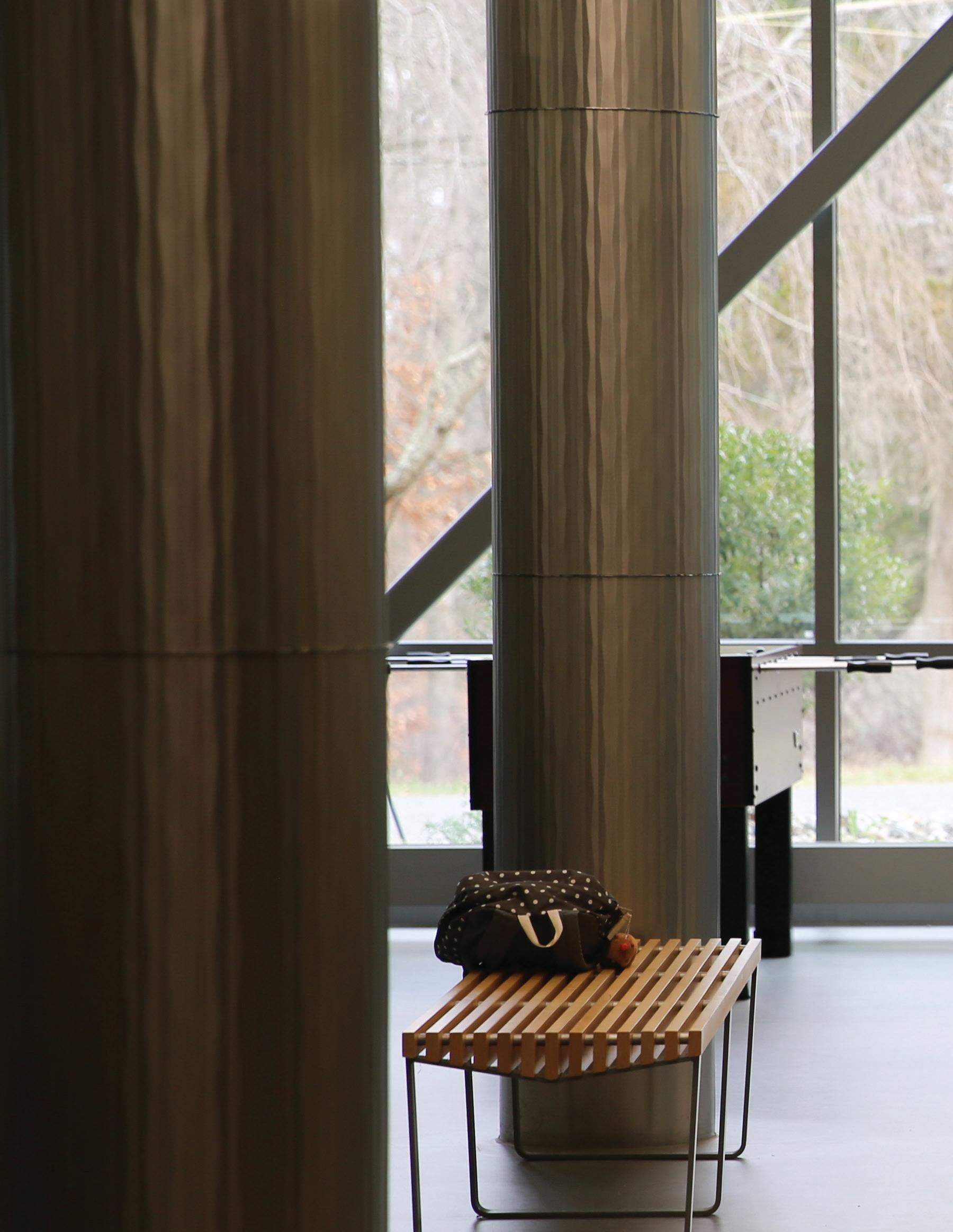
TALK OF THE T-DOCK
2 LETTER FROM THE EDITOR
10 HEAD OF SCHOOL’S MESSAGE
12 STORIES FROM AROUND CAMPUS LET’S GO SAINTS
24 THE NEXT CHALLENGE
The Class of 2024 boasts a crop of soon-to-be collegiate athletes ready to tackle what comes next FEATURE STORIES
32 MAKING TEACHERS
The genesis of the St. Andrew’s Teaching Fellows program
38 LET THE GOOD IN
A conversation with Dan O’Connell, longtime science faculty member and boys cross-country head coach, and Alex Horgan ’18, teaching fellow and boys cross-country assistant coach, on bonds forged on our trails and in our classrooms
CAN’T HELP BUT CONNECT
44 CLASS NOTES 54 IN MEMORY
ST. ANDREW’S MAGAZINE | Spring 2024 VOLUME 46, ISSUE 2 This publication is printed with vegetable-based soy inks on paper with 10% post-consumer waste. Please complete the process by recycling your copy when finished.
{As light streams into Amos Hall during a gray January afternoon, a student finds the perfect place to tuck in and get to
work.}

Letter from the Editor
Dear Saint,
The thread that stitches together every story ever published in this magazine is relationships. Your relationships with classmates, coaches, advisors, and faculty, ultimately culminating in your relationship with the world, and how it was shaped by time spent on the shores of Noxontown Pond.
Our stories also dig into the relationships our current students nourish with each other and with the school community—in fact, we devoted an entire day to this very notion (pg. 14).
Relationships. They’re kind of our thing. But it wasn’t until recently that I personally experienced the emotional enormity of what this community does for its people.
In early December, a virulent bacteria ravaged my right eye to the point of vision loss. This rare infection, the origins of which still baffle my medical team, came with the kind of brain-melting, light-sensitivity pain that forced me into a blacked-out bedroom for weeks. I didn’t eat. I missed Christmas. I was on 40 eye drops daily, an hourly regimen that included overnights. I missed 10.5 weeks of work. The blackness that engulfed me was swift, deep, and unyielding.
And then, the light of St. Andrew’s.
This community helped bring me back to myself in ways that I cannot talk about without becoming tearful. Faculty, staff, their children, and even students began showing up on my doorstep, and they did not stop
“The blackness that engulfed me was swift, deep, and unyielding. And then, the light of St. Andrew’s.”
In those early days, when I was barely conscious, I heard the strains of SAS voices echo up my stairwell as they helped tidy up the clutter that had settled in a home with one parent down, the other a non-sleeping emergency caretaker, and a confused, frightened 7-year-old girl.
The first time I remember feeling something close to happiness was when the smell of Quiche Lorraine, exquisitely prepared by French faculty member Pam Pears, snuck underneath the door of my “cave.”
My first truly unhinged crying spell (I mean that in a healthy way) was reserved for Assistant Director of Admissions Grace Saliba ’12 and English Teaching Fellow Alec Hill ’12. The poor souls were just trying to deliver my daughter some chicken nuggets and fries, yet neither seemed to find my outburst odd. Instead, they leaned in, and I’ll never forget it.
Two IV formers close to my heart who know of my rabid Philadelphia Phillies fandom took it upon themselves to get a message to the organization that resulted in a personalized video from play-by-play guy Tom McCarthy. (Speaking of baseball, Bob Colburn checked on me constantly once he heard about my illness, which I’m sure surprises no one.)
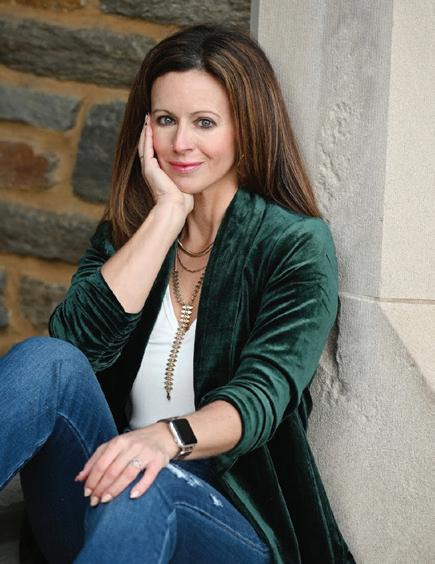
These examples are but a microcosm of what I experienced from this community, yet I am not special. I’m simply a St. Andrean, and this is what we do.
We hope you enjoy our stories on relationships, like those shared between our teaching fellows and their mentors (pg. 32), those forged on our running trails (pg. 38), and those that exist between our crop of soon-to-be collegiate athletes and their coaches (pg. 24). These stories and more create the tapestry of St. Andrew’s.
Have a relationship you’d like to tell us about? I’m all ears (and one eye).
AK White

SAS / ST. ANDREW’S MAGAZINE 2 / TALK OF THE T-DOCK
ST. ANDREW’S
MAGAZINE EDITOR
AK White
DIRECTOR OF COMMUNICATIONS
Amy Kendig
COMMUNICATIONS TEAM
Chelsea Kneedler, Tara Lennon, Andrew Nolte
CLASS NOTES EDITOR
Chesa Profaci ’80
PHOTOGRAPHY
Bradley Cook ’26, Misty Dawn Photography, Erin Farrell Photography
MAIL LETTERS TO:
St. Andrew’s Magazine, 350 Noxontown Road, Middletown, DE 19709-1605
GENERAL EMAIL: magazine@standrews-de.org
CLASS NOTES EMAIL: classnotes@standrews-de.org
St. Andrew’s Magazine is published by the Communications Office for alumni, parents, grandparents and friends of St. Andrew’s School. Printed by Pavsner Press in Baltimore, Md. Copyright 2024.
Mission Statement of St. Andrew’s School
In 1929, the School’s Founder, A. Felix duPont, wrote:
The purpose of St. Andrew’s School is to provide secondary education of a definitely Christian character at a minimum cost consistent with modern equipment and highest standards.
We continue to cultivate in our students a deep and lasting desire for learning; a willingness to ask questions and pursue skeptical, independent inquiry; and an appreciation of the liberal arts as a source of wisdom, perspective, and hope. We encourage our students to model their own work on that of practicing scholars, artists and scientists and to develop those expressive and analytical skills necessary for meaningful lives as engaged citizens. We seek to inspire in them a commitment to justice and peace.
Our students and faculty live in a residential community founded on ethical principles and Christian beliefs. We expect our faculty and staff to make our students’ interests primary, to maintain professional roles with students and to act as role models at all times, to set and maintain healthy boundaries with students, to encourage student autonomy and independence, to act transparently with students, and to support each student’s developmental growth and social integration at the School. Our students collaborate with dynamic adults and pursue their passions in a co-curriculum that includes athletics, community service and the arts. We encourage our students to find the balance between living in and contributing to the community and developing themselves as leaders and individuals.
As an Episcopal School, St. Andrew’s is grounded in and upheld by our Episcopal identity, welcoming persons regardless of their religious background. We are called to help students explore their spirituality and faith as we nurture their understanding and appreciation of all world religions. We urge students to be actively involved in community service with the understanding that all members of the community share responsibility for improving the world in which we live.
St. Andrew’s is committed to the sustainability and preservation of its land, water and other natural resources. We honor this commitment by what we teach and by how we live in community and harmony with the natural world.
On our campus, students, faculty, and staff from a variety of backgrounds work together to create a vibrant and diverse community. St. Andrew’s historic and exceptional financial aid program makes this possible, enabling the School to admit students regardless of their financial needs.
BOARD OF TRUSTEES
Scott M. Sipprelle ’81 P’08, Chair
Richard B. Vaughan ’88 P’24, Vice Chair
Monica Matouk ’84 P’18,’21,’23, Secretary
Kate Sidebottom Simpson ’96, Treasurer
Sarah Abbott ’99
Mercedes Abramo P’18,’22
Michael Atalay ’84 P’17,’19,’23
Aaron Barnes P’21,’24
The Rt. Rev. Kevin S. Brown Bishop of Delaware
Mati Buccini P’21,’23
Kellie S. Doucette ’88 P’18,’18,’21
Porter Durham P’13,’25
Charles P. Durkin ’97
John Eisenbrey, Jr. ’74 P’01,’05,’07
Ari K. Ellis ’89 P’26
Moira Forbes ’97
Grace Gahagan ’10
Anne Hance ’94
Edith “Sis” Johnson P’11
Joy McGrath ’92 Head of School
Henry McVey P’25
Paul F. Murphy P’17,’19,’22
Jennifer B. Thomas P’22
Christian Wilson ’01
TRUSTEES EMERITI
Katharine duP. Gahagan GP’10,’11, Chair Emeritus
J. Kent Sweezey ’70, Chair Emeritus
Sabina B. Forbes P’97,’06 GP’21
Monie T. Hardwick P’02,’04,’07
Maureen K. Harrington P’91,’93,’96,’99,’02
Timothy W. Peters ’66 P’91,’93 GP’19,’21,’24
Steven B. Pfeiffer P’95,’97,’00,’04,’09
Sally E. Pingree P’01
Caroline duP. Prickett GP’18,’20
Henry duP. Ridgely ’67
Edward M. Strong ’66 P’07,’10
Alexander D. Stuart P’09
SPRING 2024 3
MAGAZINE


More than a few snowball fights broke out on the Front Lawn in a snowy spell in mid-January. Arts Department Co-Chair Joshua Meier P’24 brought his Photography I course outside to capture the chaos, with Bradley Cook ’26 snapping a photo of a moment of truce between Bahar Bekirefendi ’26 and Natasha Hearder ’26.
SPRING 2024 5
TALK OF THE T-DOCK /
Boys Varsity Basketball Head Coach Terrell Myers brought 30 years of coaching experience into one timeout in a Feb. 3 matchup against Tatnall. This team faced a challenging start to their season through December and January, but this game marked the beginning of an upward trajectory in which the team won five of the final eight games of their season.

SAS / ST. ANDREW’S MAGAZINE 6 / TALK OF THE T-DOCK
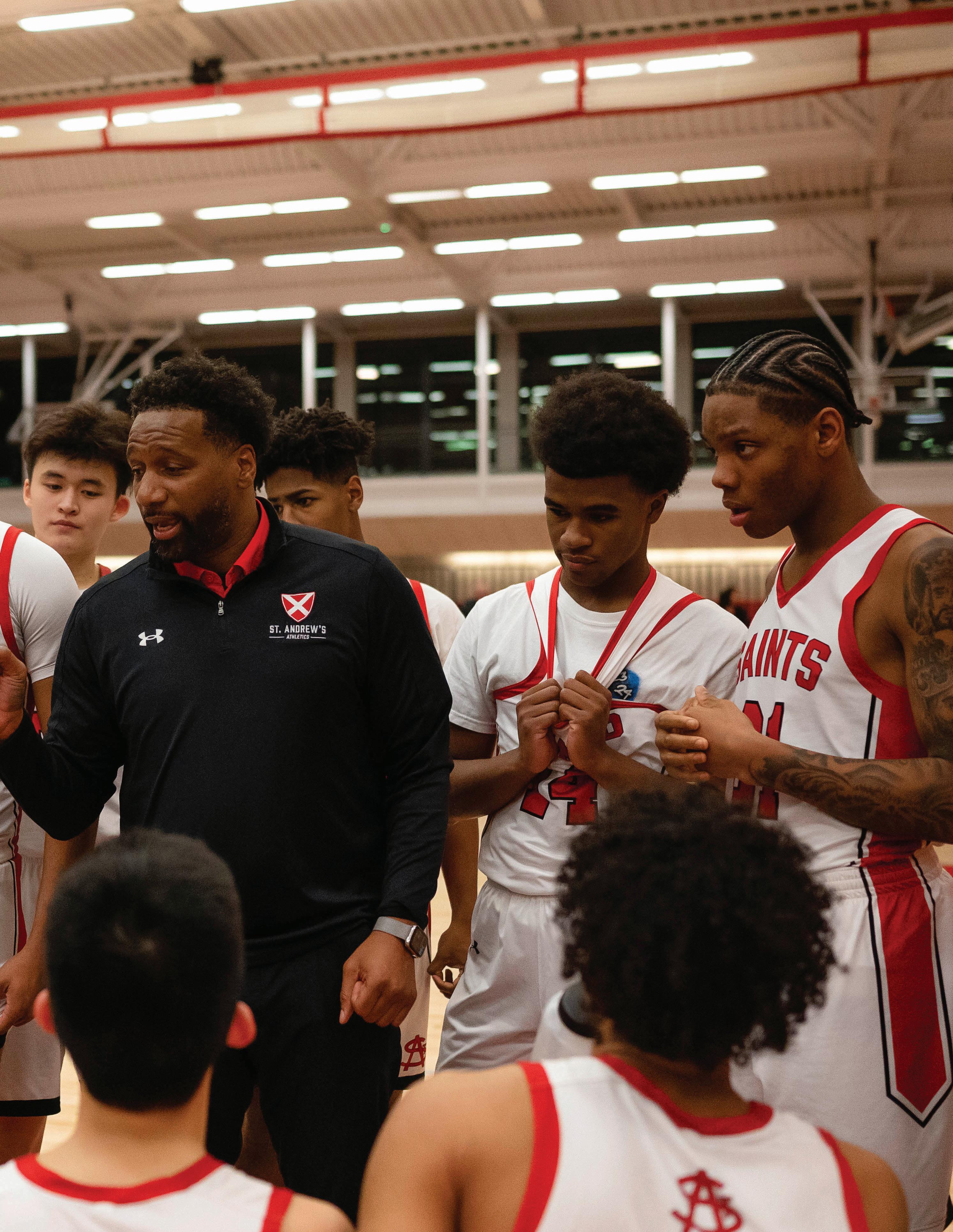
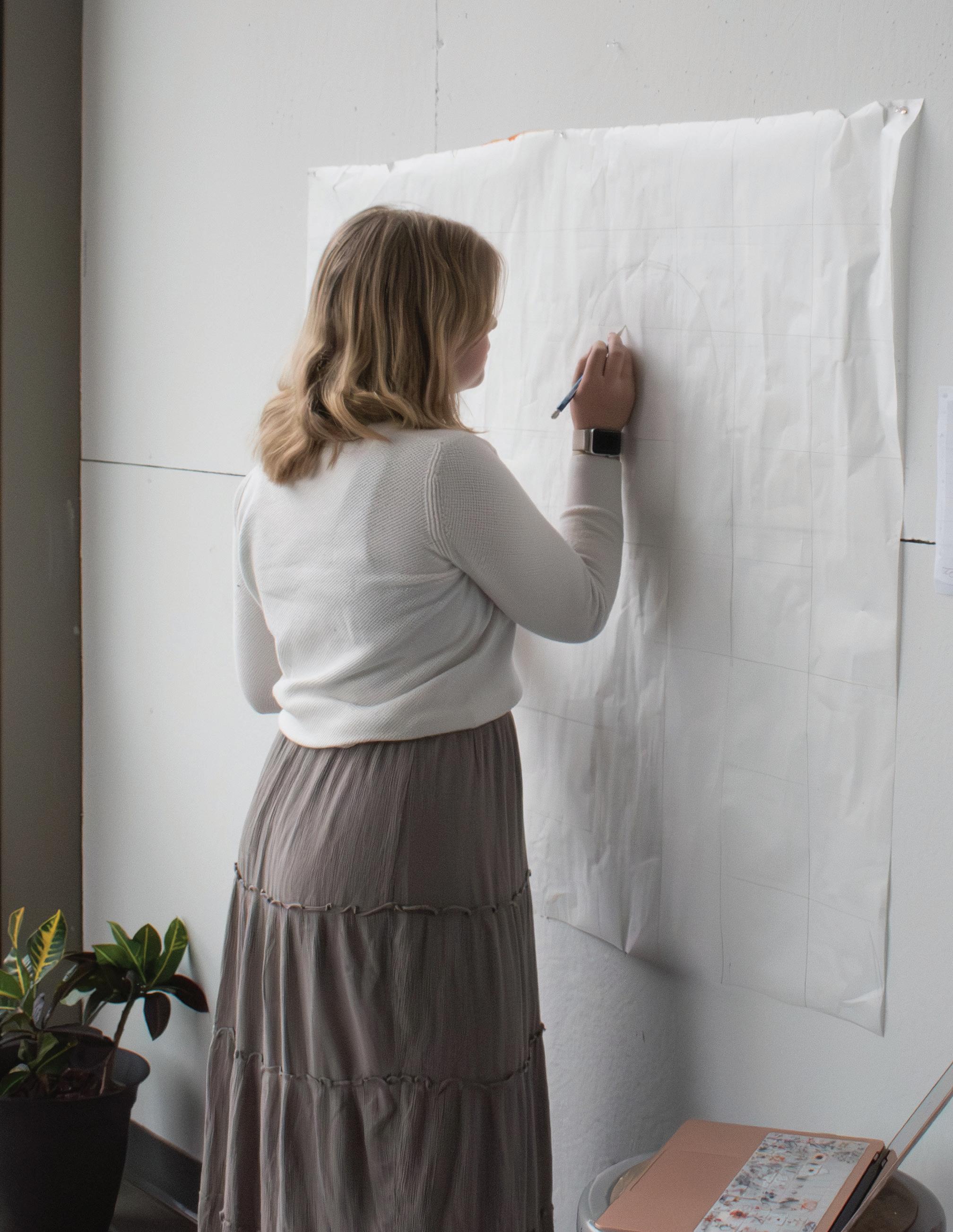

Vivian Snow ’27 sketches a selfportrait in the critique room, aka the “Fishbowl,” of the O’Brien Arts Center on the first Friday afternoon after Spring Break. Along with her III Form peers in Visual Arts I, Snow will bring the sketch to life with varying shades of a singular color in a study of value, one of the seven elements of design introduced in this course.
SPRING 2024 9
TALK OF THE T-DOCK /
Message from the Head of School
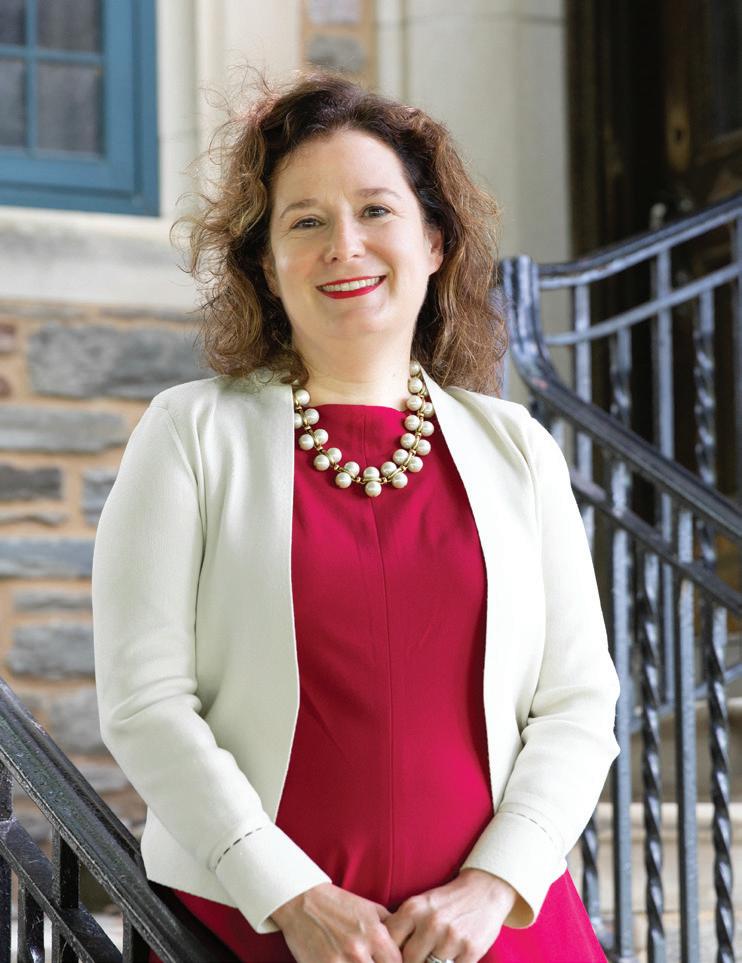

It is impossible to say what small act will provide a moment of transformation and self-belief for a student. ... the “small, daily, conscientious work” of teachers here is never forgotten by young people who are in turn transformed by the small, daily, conscientious work that we expect of them.
“
Small, daily, conscientious work is what transforms,” says science teacher Dan O’Connell in a feature in this magazine. It is hard to imagine a more concise expression of the work of a teacher or student at St. Andrew’s, and when I read Dan’s words, I got goosebumps. The work, of course, is communal— this school is distinguished by our smallness, and our fully residential nature—and it extends for many lifetimes.
From our Teaching Fellows Program in 2024, developed for teachers in their very first year in the classroom, dorm, advisory, and coaching roles, to memories alumni sent of Nan Mein and Evert van Buchem, who died just as 2023 was drawing to a close, you will read about the work of faculty spanning nearly 60 years of the school’s history. Yet the themes of these pieces are of the same cloth. These are no dim and dusty recollections, blurred by the passage of time. No! They are specific and detailed and could have happened this very morning: Nan preparing a potato salad “with freshly chopped chives,” building kites, or pouring sherry as the bells rang with the wry adaptation of the school hymn as a toast, “Jesus calls us!” Evert’s “distinctive and efficient way of running,” preparing a cheese sandwich on a soft roll, or exhorting his students with cries of, “Golly, man!”
This is our opportunity as teachers. It is impossible to say what small act will provide a moment of transformation and self-belief for a student. Including students by making a cheese sandwich or reaching them during chapel by building kites on Easter—the “small, daily, conscientious work” of teachers here is never forgotten by young people who are in turn transformed by the small, daily, conscientious work that we expect of them. This is the call and response that iterates in our classrooms, in our Chapel and Dining Hall and dorms, across the fields and pond, and which builds, brick by brick, a sense and a reality that this education is something more than the sum of its parts. Every reader of this magazine has been touched by this remarkable school and the education we offer. I hope in reading this issue you will be immersed, once again, in the transformative power of a St. Andrew’s education and the faculty members who make it possible. J
SAS / ST. ANDREW’S MAGAZINE 10 / TALK OF THE T-DOCK
From the Mail Bag
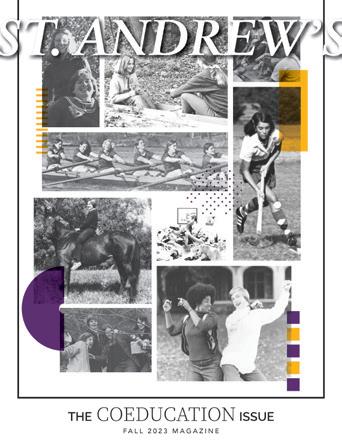
Kudos on Your Coed Issue
I LOVED the latest issue of the magazine! I especially enjoyed your article and interview with Nan Mein. You captured her spirit and her important impact on SAS so fully. Your admiration for her and her work shone through in your writing—thank you! Chris Speers ’07 •
Thank you so much for the article you wrote about the girls and about me to a point. I thought it was absolutely wonderful. I thought the whole magazine was terrific, but I loved the way you portrayed the kids and now the grownups. You really did such a beautiful job. I send lots of love and gratitude. Joan O’Brien P’84 GP’15,’17,’19,’22 •
Setting the Record Straight
I thoroughly enjoyed the latest magazine with all the highlights on coeducation and women’s history at St. Andrew’s, thank you!
As my 25th Reunion is upon me, I couldn’t help wanting to relive the glory days when I was reading the Girls Just Wanna Win Championships piece. So here I am writing to set the record straight that there were two girls’ crew Stotesbury wins that were missed in the magazine: 1997 Junior 8 and 1999 Senior 8.
I had the great pleasure of connecting with [former crew coach] Brad Bates a few weeks ago when he was in Sun Valley for a big Nordic ski race—he’s quite the inspiration and was so fun to watch. He was an amazing coach to all of us and we had fun reconnecting. We also discussed the historical record (ha!) and he confirmed we did, in fact, win those years. No need to update in the magazine, but I hope the records are updated for future reference.
I’m excited to get back on Noxontown Pond this summer at reunion: there will certainly not be any noteworthy results to discuss then! Liza Green ’99 •
We say: To the women of the 1997 Junior 8 and the 1999 Senior 8, we are deeply sorry for the omission. We thank you for your historic wins, which we promise we won’t ever forget!
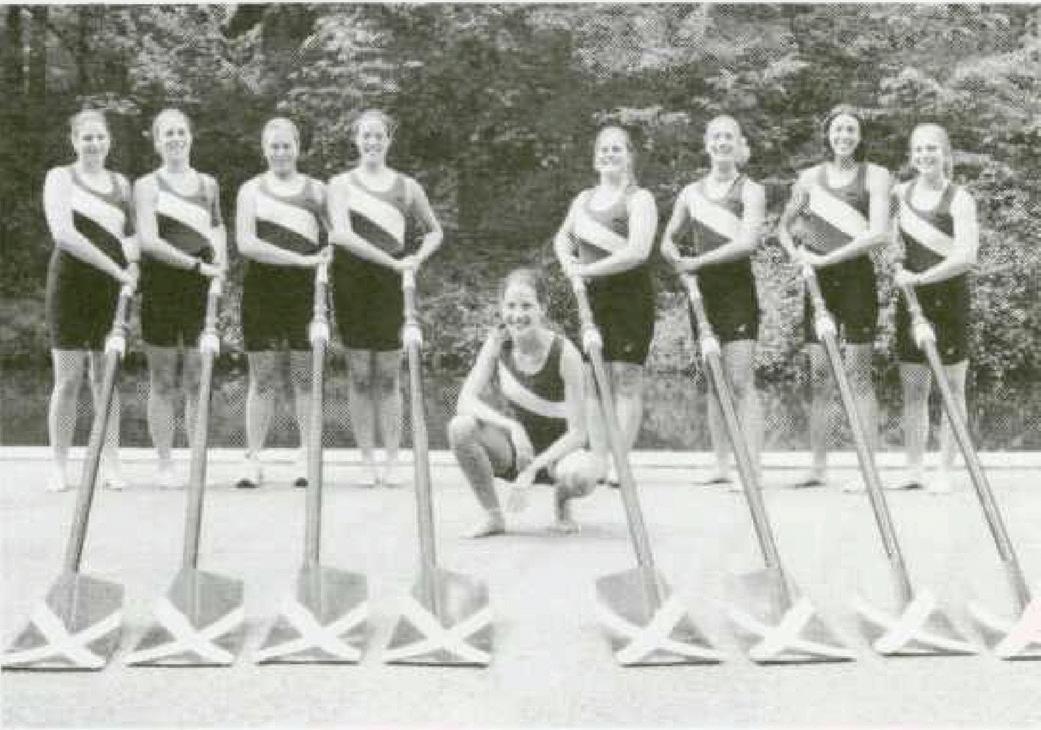


SPRING 2024 11
TALK OF THE T-DOCK /
1997 Junior 8
1999 Senior 8
STORIES FROM AROUND CAMPUS
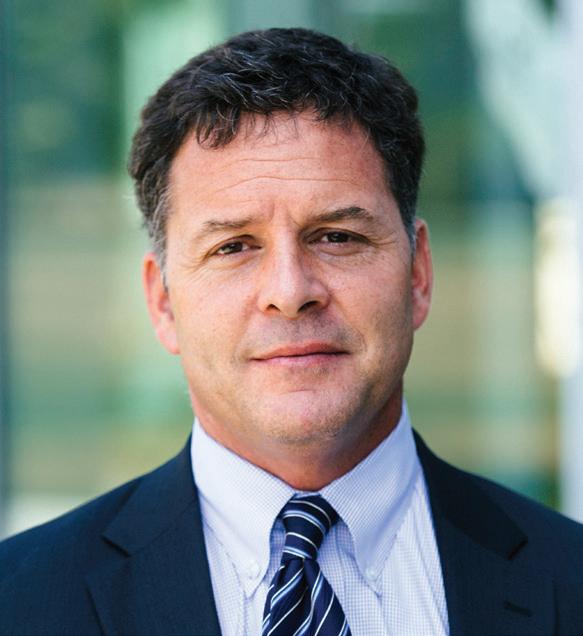
Meet New Head Boys Lacrosse Coach
Chris Bates
Competitors beware: Be it a thumb war, an arm wrestle, or a round of Go Fish, new Head Boys Lacrosse Coach Chris Bates wants to end up in the ‘W’ column. “I am simply wired to be competitive,” Bates says. “It’s my nature.”
It’s a nature he can’t wait to share with his new team; in fact, during this conversation in early March, Bates was quite literally bouncing in his chair in anticipation of getting to the lacrosse field to talk to and work with “his guys.”
Bates has made a national name for himself in coaching high school, collegiate, and even professional lacrosse. He most recently helmed Episcopal Academy’s varsity boys team in Newtown Square, PA. During his tenure, the team was a perennial top three Inter-Academic League competitor. As assistant and head coach, Bates spent 10 years at Drexel University in Philadelphia, earning two conference championships and two CAA Coach of the Year awards. At Princeton, head coach Bates guided the Tigers to three Ivy championships and two NCAA tourney appearances. Last year, he made the leap to professional lacrosse, as head coach of the 2023 Premiere League champions, the Archers Lacrosse Club (a role he will continue in conjunction with his work at SAS, thanks to scheduling).
And now, Bates is here, with vision, with excitement, and sounding like a longtime St. Andrean already. “What’s so cool about this community is I have the opportunity to just be around kids, which sounds simple enough, but it’s something I really love,” says Bates, a former educator who holds a master’s degree in school psychology. “It’s been incredible to go to School Meeting and there’s Tristan [Kalloo ’24] on stage, and I’m like, ‘Wow. He’s a singer, too?’ There are just so many ways for the students to be involved and connected here. It’s very clear to me what this place stands for, and it’s a community I wanted to be a part of and one in which I thought I could have an impact.”
Part of that impact is ensuring his team knows honor and respect. “Not just honor and respect for the game, but honor and respect for each other,” he says. “I love this game. This game has been my life, and we’re going to do it the right way and raise the bar. Do we want to be successful? Of course. We want to do everything we can to win, but more so, to prepare to win, as I believe winning is a byproduct of how well you prepare.”
SAS / ST. ANDREW’S MAGAZINE 12 / TALK OF THE T-DOCK
For Bates, winning isn’t as cut-and-dried as which team scored the most goals. “Seeing guys jazzed up about what we’ve accomplished, seeing them grow, watching them come back next year and see that they walk around a little differently—that’s just as much success,” he says. So, too, is beating down the cultural reputation Bates says can come with men’s lacrosse, earned or not. “I have no interest in working with guys like that,” he says. “These will be good gentlemen. They will respect rules, they will stand for something, and they will have high standards.”
With his new squad comes newcomers. “It’s been a while since I’ve coached players brand new to the game, but I’m excited about it,” says Bates. “I told our guys, ‘Listen. It’s going to be a learning experience both ways. As long as you show up every day with a smile and a willingness to learn, we’re going to be just fine.’”
Bates remembers, on a fall visit to campus, seeing III former Gabriel Musa ’26 on the soccer field. “I said, ‘Hey. I will take him,’” Bates says, laughing. “That kid is going to be a lacrosse player. There’s lots of talent to be found here.”
That Bates also has a degree in school psychology is an asset to the program. “I’m always curious of how people learn, what motivates them, how they think,” he says. “I think it puts me in a good position to be empathetic as I understand that each kid that you coach is different, and you have to coach each kid different. It’s not my way or the highway. My challenge is from a psychological standpoint: What are you understanding? What are you not? What are your motivations? How can we find the middle ground so that you are excited, working hard and improving, and becoming a better teammate? That’s where we want to be.”
As Bates patiently waited out winter away from campus, friends and family who knew of his new gig were curious about where exactly he was going. Bates kept an image of St. Andrew’s on his computer desktop so he could quickly show it when prompted.
“I’m like, ‘Here it is. Look at the pond, look at the Front Lawn—it’s gorgeous,” he says. But, as he was quick to tell them, he was just as excited to be a part of the school community.
“The culture and the spirit of this place—that’s what’s so unique and got me to say, ‘Yes.’ Everyone is so curious about you, and every adult I’ve spoken to can rattle off this and that about any student, which tells me everyone here is part of the growingup process of everybody else. That’s an investment in other people that is special.” •
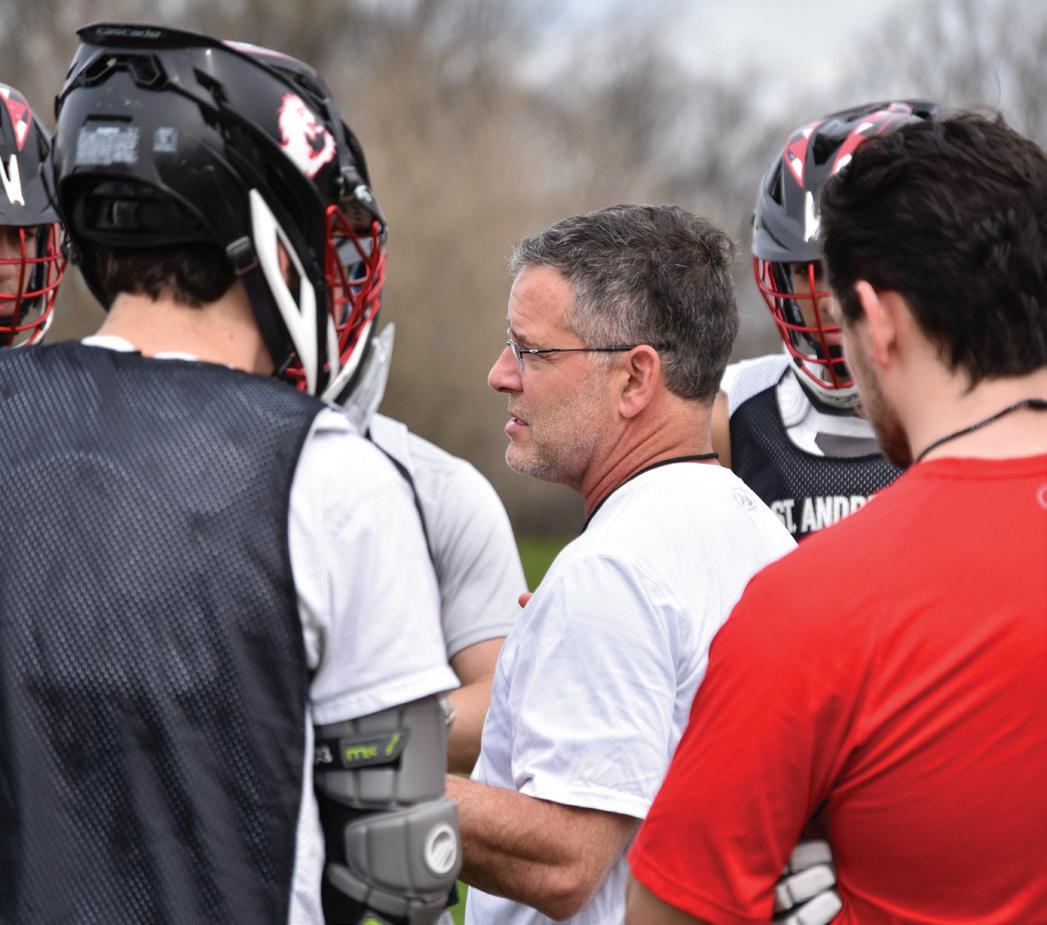
SPRING 2024 13 TALK OF THE T-DOCK /
STORIES FROM AROUND CAMPUS
Understanding our Relationships
St. Andrew’s partners with One Love Foundation for a day of learning about the signs of healthy and unhealthy relationships
Going into the group discussions on In Day on Feb. 19, Grace King ’25 didn’t entirely know what she was getting into.
This was the first In Day held at St. Andrew’s, a day devoted to looking inward to learn about and discuss relationships of all kinds, and to identify the signs of healthy and unhealthy ones. King completed training and preparation in advance of being a student-facilitator on In Day, but she wasn’t sure what would manifest in the discussions and how students would participate.
“My group bought into the discussion amazingly,” says King.
King says that in discussions about how to support better relationships in their own and each other’s lives, students opened up and “took space” and “made space” for each other.
“People were just kind of sitting with their thoughts, but consistently they were always very engaged,” she says. “And everything that they were saying was very thoughtful.”
Chemistry instructor Greg Guldin and Associate Head of School Ana Ramírez were the driving forces behind In Day, which was held in partnership with the One Love Foundation—an organization with the three-fold mission of educating, raising awareness, and mobilizing people to end relationship abuse and create a world of healthier relationships.
“In Day is basically a day that the St. Andrew’s school community comes together to talk about being in relationship with each other,” says Guldin. “Ultimately, the idea is we’re all in relationships with each other from birth, [so it’s essential to hear] about what those relationships are, the things to celebrate, and the complications and the challenges and the opportunities.”
Guldin garnered interest about In Day among the student body to find students like King who were willing to take on leadership responsibilities. Once he identified his 26 student-facilitators, he planned
several training sessions for them in advance of the event.
King says at the three training sessions she attended, she learned about the One Love Foundation and about relationship abuse, and planned out the discussions she and the other facilitators would lead. In addition, she says the facilitators also completed a virtual course through One Love.
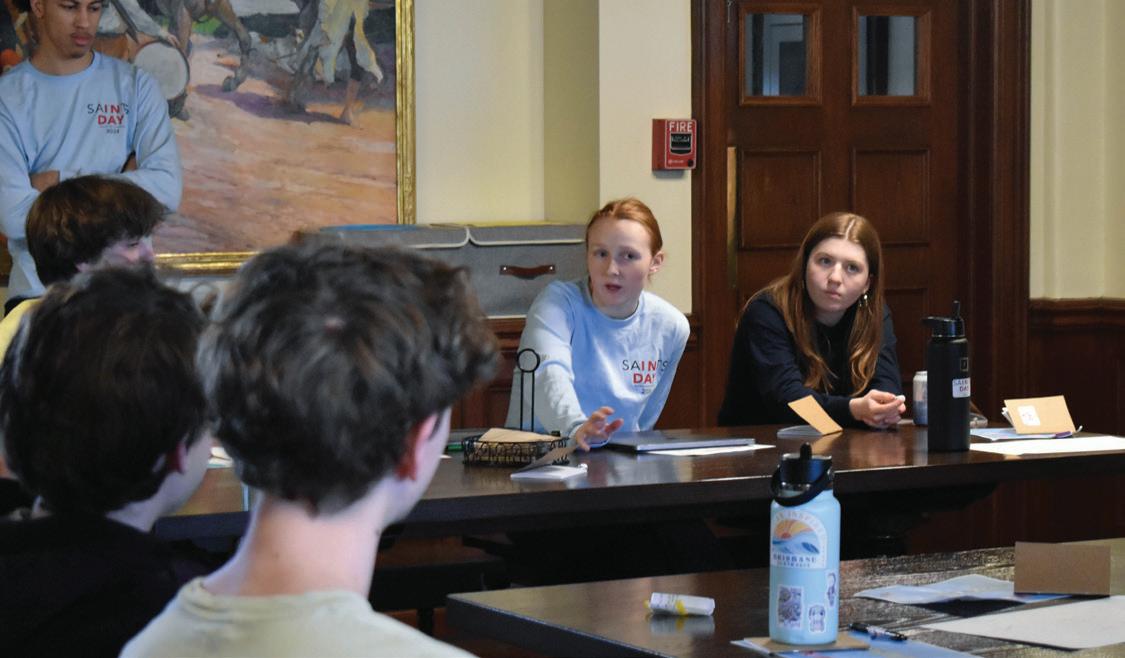
In Day started with a kickoff speech from Amy Altig, head coach of the University of Delaware’s women’s lacrosse team and wife of Megan Altig, who is a member of the St. Andrew’s advancement team and who coaches girls and boys soccer. Amy reflected on the founding purpose of One Love: to honor Yeardley Love, a Baltimore-native and UVA lacrosse player who was tragically killed by her ex-boyfriend in 2010. She then spoke to her own personal experiences as a coach who, year after year, has helped her athletes navigate relationship issues.
Afterwards, students filed into breakout sessions where groups watched videos, reflected on what they learned about relationship abuse, and engaged in conversation about the relationships in their own lives.
SAS / ST. ANDREW’S MAGAZINE 14 / TALK OF THE T-DOCK

“One Love has 10 signs of unhealthy relationships, and 10 signs of healthy relationships, and it can get really in depth,” says King. “It forced me to think about it too, which is good. I didn’t just have other people learn: I was learning too, which I appreciated.”
King says that the experience was not only eyeopening because of the student buy-in, but because it provided her a taste of what being a leader on campus is like.
“I felt what it would feel like to be a senior and to be a leader,” says King. “I’ve not had a true leadership position at the school before. And I feel like that was a leadership position because I was sitting and leading discussion for underclassmen.”
She adds that students may have felt more comfortable and eager to participate on In Day because it was their fellow students, who could relate and understand, who led the breakout sessions.
“Hearing about [relationships] from a peer is really what the goal of the day was,” says Guldin. “To talk to each other about what goes well and what the challenges are and what struggles we may face, and then what are the things that we can do to help each other get [to healthier places].”
King, who is eager to continue to step up as a leader in the future, says her biggest takeaway from In Day is just how important and frequent discussion about relationships should be in the St. Andrew’s community. Along with King, Guldin is excited to keep discussion alive at future In Day programming.
“There’s always opportunities for us to do things better,” says Guldin. “For the next In Day, there’s different ways we may want to mix up the groups, or there’s different timing we may follow. But for a first go of healthy relationship [building], I think it went really, really well.” •
SPRING 2024 15
TALK OF THE T-DOCK /
STORIES FROM AROUND CAMPUS
“A Fascinating Route of Serendipity”
Meet Bill McClements ’81 P’12, St. Andrew’s new chief financial officer

The St. Andrew’s community is excited to welcome Bill McClements ’81 P’12 as our new chief financial officer (CFO), effective May 20. McClements brings decades of experience in business leadership and nonprofit management, as well as the invaluable perspective of a St. Andrew’s alumnus and alumni parent who has seen the impact of the St. Andrew’s mission on himself and on his family.
McClements first experienced life at St. Andrew’s as a V former, a daunting yet rewarding task.
“In some respects, I kind of jumped onto a moving train because the culture and the class was already pretty well set,” says McClements. He transferred to St. Andrew’s after being lured by the academically rigorous St. Andrew’s curriculum, and he says his two years at St. Andrew’s lived up to his expectation and prepared and polished him for academic scholarship on the university level.
Inspired by the transformative Socratic seminars he experienced in former Academic Dean and History Department Chair Bob Stegeman’s history classes, McClements pursued a history degree at Williams College. After graduating, he went on to earn an MBA from Harvard Business School. From there, he spent the first 20 years of his career at Monitor Group, a global strategy consulting firm where he held a variety of positions, including chief operating officer (COO).
“It was really a remarkable run,” he says. “We built a tremendous culture around commitment to clients, commitment to doing good things for society, and commitment to building relationships with people that are respectful and transparent and willing to push each other constructively.”
From there, he found a new opportunity to work for a growing biotech company, Merrimack Pharmaceuticals, which specializes in developing cancer treatment drugs. After six years with Merrimack, McClements began his tenure as CFO/COO of Partner Therapeutics, a pharmaceutical company which aims to improve the lives of patients with cancer and other serious diseases.
McClements says that not only will his commitment to the people side and the financial side of business serve as an asset to St. Andrew’s, but so, too, will his wealth of knowledge about how to tailor that approach to the nonprofit sector. His experience with nonprofits includes his work with City Year, a nonprofit that places AmeriCorps members in schools to support student educational success. McClements saw both sides of that nonprofit—in business school, he served as an AmeriCorps member, and after he earned his MBA, he provided the organization with pro bono consulting work. He’s also helped inspire social change through
SAS / ST. ANDREW’S MAGAZINE 16 / TALK OF THE T-DOCK
nonprofit work as a board member for uAspire, an organization that supports high school students in their pursuit of higher education.
“My parents instilled in me that education is the most important tool society has to ensure justice and equity,” he says. “The unifying thread through all that I’ve done has been programs that are focused on helping young people navigate their way into society and through educational opportunities effectively.”
Due to his years-long commitment to driving student success, McClements had an inkling that at some point, he would pursue a job solely in the nonprofit education sector. It was a “fascinating route of serendipity” in which McClements’ personal networks overlapped with that of Head of School Joy McGrath ’92, thus allowing him to discover a role at St. Andrew’s that would fulfill exactly his desire to make important change.
“I read this job description and it spoke to me on pretty much every level,” says McClements. “I felt like what Joy and the team are looking for is somebody to really deeply engage in the community and become a part of it and to provide sound operational and financial leadership across the institution, but also to help guide and build St. Andrew’s through the next decade or more.”
A key tenet of his business leadership will be his commitment to building and supporting teams at St. Andrew’s. By doing so, he says, St. Andrew’s can continue to further its purpose of providing the best possible learning environment for its students. Stating the core goals of his work as CFO, he echoes St. Andrew’s mission of ensuring the diversity of the student body, providing revolutionary financial aid, and promoting environmental sustainability.
McClements will also engage in the essential St. Andrew’s life: he will live on campus, perform dorm and weekend duty, work with an advisory group, and more.
“That’s a big part of what excited me about the opportunity,” he says. “This would be a chance to really be connected to a wonderful group of people.”
He says that the perspective he gained from watching daughter Annie (McClements) Montgomery ’12 go through St. Andrew’s allows him to understand what it means to be a Saint today. In her time at SAS, he witnessed a culture of genuine kindness along with high academic standards, each made possible with the hiring of talented, devoted faculty.
“Having seen [the impact of St. Andrew’s] with my own eyes, it gives me a real focus on what I want to accomplish and help the team accomplish,” he says. “[St. Andrew’s students] are just terrific people who are really striving to do great things, and there’s nothing better than helping that kind of person do those kinds of things.” •

SPRING 2024 17
ACCESS FOR ALL
This year’s Hooper Conference highlighted the fight for disability rights
BY TARA LENNON
In developing the theme of this year’s Thomas H. Hooper III ’71 Conference on Equity & Justice, a few things came together for Dean of Inclusion & Belonging Dr. Danica Tisdale Fisher. She remembered watching the documentary Crip Camp: A Disability Revolution, a 2020 documentary that explores the history of the disability rights movement, and feeling touched by the sense of interconnectedness that exists between various campaigns for civil and human rights. She also reflected on conversations she had with Grace Anne Doyle ’25, a consistent voice on campus who educates the school community about issues of access and disability.
“I was inspired to use the Hooper Conference to lift up this topic for our community to consider,” Fisher says.
Titled “Access, Advocacy, and the Fight for Disability Rights,” the conference was held March 1-3 and organized by Fisher, the Student Diversity Committee (SDC), and Doyle.
At the conference, disability rights advocates Beth Halsted ’77, Jenny Kern ’83, and Athletics Aide Mike Rivera P’23,’26, told their personal stories of resilience and the work they’ve done in the struggle for equal access.
Halsted opened up the conference in a Friday morning chapel talk, speaking to her athletic experiences at St. Andrew’s. One of the first girls to attend the school, she played field
hockey until a knee injury took her out of play. However, this injury presented her with a new opportunity: to assist close friend Tripper Showell ’75 in the training room, which she ended up doing every following fall and winter of her time at SAS. She recovered from the injury enough to forge what would become a lifelong passion for rowing. The same knee injury sidelined her in her VI Form year, leading her to take on a coaching position for the second boat. It was her days in the training room, however, that proved more useful than she could have ever imagined.
“I found myself a decade later, trapped in a wrecked car on a dark country road, needing every bit of that accumulated knowledge, composure, and skill to stay alive for the six hours it took to be found,” Halsted told students. She knew that her neck was broken, and she also knew that falling asleep would put her in danger. “Tripper’s instruction about spinal injury, concussion, shock, and its treatment revisited me that night as I tasked myself to remain alert through the many hours before sunrise.”
In the months following the accident, she had to relearn everything she knew about her body, and renegotiate her relationship with crew. She loved the sport so much that she couldn’t bear the idea of getting back in the boat in a modified way. But her St. Andrew’s community, who remained in her corner, knew to challenge her.
“I would have never gotten back in a crew shell had I not been contacted by the very same handful of boys who encouraged me to get on the water in the spring of 1974,” she said.
With her former classmates, they built a rowing club of alumni oarsmen in Wilmington, Del., with her in the cox seat.
“As challenges presented themselves, they would be conquered,” she said. “Every practice, once they put the boat in the water, one of them would scoop me up and put me in the boat … Being back on the water with those guys and finding a way I could be involved with a sport I loved felt like freedom, and I will be forever grateful. They just knew what I needed and they refused to allow any barriers to that experience.”
The discussion about overcoming barriers to access continued that evening, with an all-school screening of the documentary Crip Camp: A Disability Revolution. The documentary tells the story of Camp Jened, a camp where teenagers with disabilities explored a future not marked by isolation, discrimination, and institutionalization, but by full inclusion and liberation. The documentary follows the activists who migrated from Camp Jened to Berkeley, Calif., and fought for disability justice.
Doyle, along with the SDC, spearheaded group discussions following the documentary screening in Engelhard. The V former says that
SAS / ST. ANDREW’S MAGAZINE 18 / TALK OF THE T-DOCK
“Being back on the water with those guys and finding a way I could be involved with a sport I loved felt like freedom, and I will be forever grateful. They just knew what I needed and they refused to allow any barriers to that experience.”
—BETH HALSTED ’77

watching the documentary was an eye-opening experience for her and her peers.
“Last year and this year, I’ve given speeches at School Meeting to explain my experience with disability and what I ask from people around me,” she says. “But I think with this conference … I wanted people to understand that sharing my experience is my experience. And every single person with a disability has different things that they can and can’t do, and their experience and feelings toward their disability are going to be different.”
Doyle says the documentary showed numerous perspectives and identities of people who live with all types of disabilities.
“That was really good, because there’s a small number of people at St. Andrew’s that live with physical
or cognitive disabilities, whether they’re visible or invisible,” Doyle says. “The documentary was an opportunity for people to hear a lot of different perspectives.”
Kern is an expert on the history of the Disability Rights Movement that Crip Camp documents because she was part of making that history happen. In a live virtual talk and Q&A with Kern the following morning, the school community furthered the conversation about the evolution of disability rights.
Kern’s journey with disability began in the mid-’80s when she sustained a spinal cord injury in a car accident soon after she entered college.
“That May day, I entered a new world about which I knew practically nothing,” she said. “But I knew myself and that despite the many losses, I was intact in the most fundamental of ways.” Like Halsted, she cited the love and support of her friends and family, including her St. Andrew’s community, who sustained her during a difficult time.
Kern’s experience with disability led her to advocacy. After transferring to Barnard College after the injury, she joined a school committee aimed at increasing access for students with disabilities. She learned how to be creative, how to ask friends for help, and she integrated her experience of being a person who uses a wheelchair into her identity.
Since, Kern has done and seen it all. She briefly returned to St. Andrew’s to coach crew and teach before traveling to Berkeley to volunteer and campaign for disability rights. She went to law school and practiced public interest law, before founding Inclusive Cycling International to increase access to adaptive cycling. Internationally, she also advocates for access to wheelchairs and organizes conferences on disability.
“What events or places or causes will be your Camp Jened?” Kern asked students. “What in your life will bring together the parts of yourself that you love, and maybe you’ve been taught to be ashamed of? Where is the place and who are the people that you risk turning toward to be your truest self and to perhaps create something bigger than yourself?”
The story of Kern’s extensive career elicited numerous questions from the student moderators—Doyle, Zachary Macalintal ’24, and Ashley McIntosh ’25—and the audience. Among questions about her perspective on Crip Camp and her experiences with adaptive sports, Saints looked
“What events or places or causes will be your Camp Jened? What in your life will bring together the parts of yourself that you love, and maybe you’ve been taught to be ashamed of? Where is the place and who are the people that you risk turning toward to be your truest self and to perhaps create something bigger than yourself?”
—JENNY KERN ’83
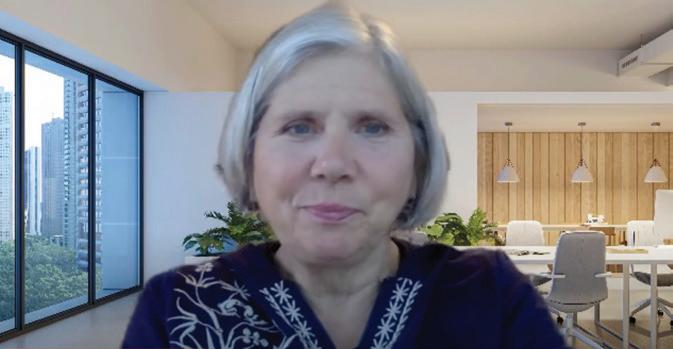
SPRING 2024 19
TALK OF THE T-DOCK /
JENNY KERN ’83
BETH HALSTED ’77
to Kern for advice on what they can do to identify the “new frontier” for disability activism and be activists and allies themselves.
The conference concluded Sunday evening with a presentation from Rivera. Rivera, who is Deaf, had two goals: to educate students on the fight for Deaf rights today and on 1988’s Deaf President Now student protest at Gallaudet University in Washington, D.C., as well as to expand the community’s understanding of Deaf culture.
“As I interact with students daily in the athletics department, it was a great opportunity to share some basic tips for engaging and communicating with Deaf people,” Rivera writes.
He shared his background, including the barriers and language deprivation he experienced as a child, and his experience going to boarding school. When he learned American Sign Language (ASL), his “world opened.”
Fast forward to his time at Gallaudet, a university designed to educate Deaf and hard-of-hearing students. Rivera and fellow students at Gallaudet came together with a shared cause: to demand that the school’s board of trustees appoint a Deaf president instead of the hearing candidate they chose to lead the university. Students shut the doors of their buildings, they marched, and they campaigned under the banner of “Deaf President Now” until the leaders of the university took notice, finally appointing a Deaf president instead.
Rivera asserted that the battle for Deaf rights is not over, citing a need for open-captioned movies at theaters—a call to action the student body has already mobilized on. A group of Saints spearheaded an open-caption showing of Dune: Part Two on March 30 at a local movie theater, Westown Movies.
“This is why I love this SAS community,” wrote Rivera in an email to the student body. “For 10 years, I have
not been able to convince Westown to show a captioned movie. And Saturday night was perfect; we had equal access and I enjoyed every minute.”
During his presentation, Rivera also provided tips for the community to communicate better with him and other Deaf and hard-of-hearing people: make eye-contact when speaking, write or text to communicate, and learn basic phrases in ASL.
“I want students to be aware of the Deaf community, American Sign Language, and our fight against isolation and the need for access everyday,” Rivera shares.
He adds that he was touched to see how many students attended his presentation and engaged with him with excitement, energy, and thoughtful questions.
“You can see the importance of the event by the way the students interacted with me before the weekend and again after the conference,” Rivera notes. “Everyone internalized my message and are much more willing to engage with me and ask questions about my culture, my language, and my experience.”
Fisher says that she was thoroughly impressed by the “intellectual curiosity” of both the student organizers of the conference and the student body as they explored disability rights history and these personal experiences during the conference.
“For some, this was the first time that they had thought critically about disability issues or even considered the history of the disability rights movement, so in many ways this conference provided a new lens through which to think about equity and inclusion that some had not imagined before,” says Fisher.
While the conference may be over, Fisher says the campus conversation about access and ability is just getting started.
“Everyone internalized my message and are much more willing to engage with me and ask questions about my culture, my language, and my experience.”
—MIKE RIVERA P’23,’26
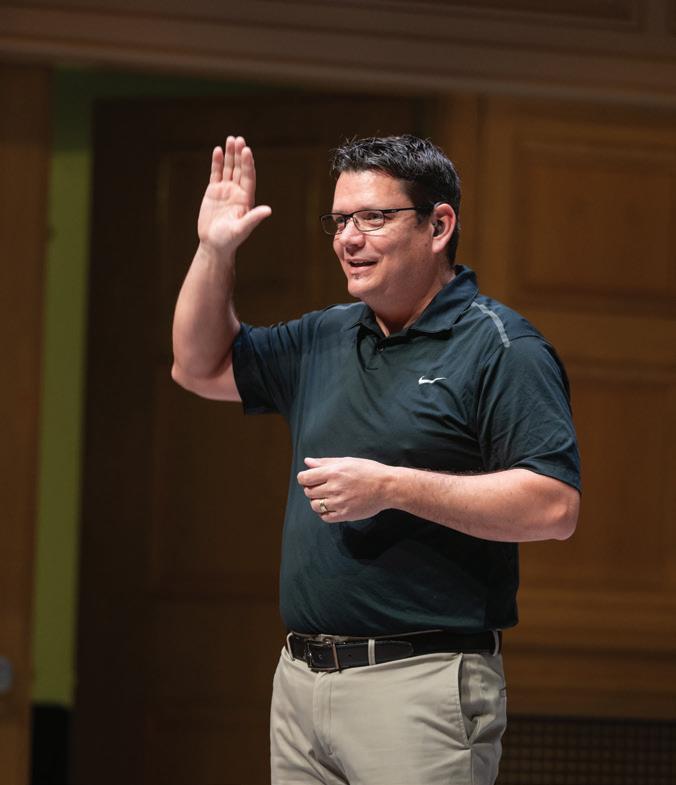
“From what we’ve learned about our community through our guest presenters, SAS has come a long way in terms of its physical accessibility for all of us who live and learn on this campus, and in terms of ensuring accommodations are met in our classrooms,” she says. “While we applaud where we’ve progressed, it is always important to think about ways that we can strive to be more inclusive and accessible. I think the conference sparked some of those conversations and encouraged our students to take inventory of our spaces and our culture to find new ways to advance belongingness and equity at St. Andrew’s.” •
SAS / ST. ANDREW’S MAGAZINE 20 / TALK OF THE T-DOCK
MIKE RIVERA P’23,’26
TRUSTEE’S CORNER
Get to know a member of our Board of Trustees At St. Andrew’s, where we place so much emphasis on people and proximity, it’s easy to understand why U.S. naval pilot Sarah (Atwater) Abbott ’99 would show up for friend Caylei (Fujas) Vogelzang ’99 when she expressed interest in attending a Naval Academy presentation on campus.
“The Academy spoke at lunch, and noted how they graduate all these CEOs, and by the way, it’s free,’” Abbott remembers. “I was like, ‘That’s interesting, but whatever.’ But Caylei wanted to learn more.” So Abbott went with her to a follow-up session. “They played this silly movie, and I was like, ‘There’s no way,’” she says. “They’re appealing to your emotions and your patriotism. It just didn’t land for me.”

Vogelzang, however, was even more invested, and wanted to head to Annapolis, Md., to do Summer Session, essentially a weeklong, intensive crash course in U.S. Naval Academy life. But plot twist: “Caylei hated it,” Abbott says, laughing. “And I loved it. It was something I was craving without realizing it. It was one of those flukes in life, but St. Andrew’s ended up setting me on a path I never expected.”
Years after her 2003 graduation from the Academy and 2005 graduation from Stanford University, her path has sent her back to St. Andrew’s—with close to 2,000 miles flown in 31 different aircraft, two Meritorious Service Medals, multiple combat operations, a husband, two children, seven chickens, two cats, and one dog in between.
As a trustee, Abbott is thrilled to connect with St. Andrew’s in a new way. No longer an active pilot, she notes her naval career has taken on a different direction now. “I focus more on organizations and management, and how to bring people together to do really difficult tasks rather than serve as an individual contributor,” she says. “My work with St. Andrew’s board will leverage all of those things.”
Abbott has been impressed with the diverse body that makes up the board. “It’s a really interesting group,” she says. “I think our challenge is to always come together and make sure we are all willing to express honesty, which is any board’s challenge. That’s where I hope to contribute, to keep fostering that the work is only as good as we’re willing to be honest, to get things on the table and wrangle with them.”
Abbott anticipates the board will have to wrangle with AI. “I’m really excited to see the next chapter of where [Head of School] Joy [McGrath ’92] wants to take the school,” she says. “There’s so much about St. Andrew’s that I think should remain the same, but also, there’s so much going on in the world: How do we prepare students for a life that is more virtual than we ever thought? Do you react with, ‘Ground yourself in the real world’ or do you explore what’s possible in a moment where technology has outpaced almost everything about us as human beings? I think we need to understand how to prepare kids to live in this world successfully, exploring everything from the impact of social media to the essential question of, ‘What is true and real?’”
One thing Abbott knows is real: the St. Andrew’s effect. “Much like the Naval Academy, St. Andrew’s just offers a lifestyle,” she says. “Both work to develop you morally, mentally, and physically; St. Andrew’s adds a spiritual dimension. The message is you should engage with the world mentally, physically, morally, and spiritually. This is a model of how you should live your life: as a whole person.” •
Trustee Trivia
A Quick Q&A with Sarah (Atwater) Abbott ’99
THE THING THAT’D MAKE ME JUMP IN NOXONTOWN POND ... the rope swing.
THE MOST UNDERRATED PART OF ST. ANDREW’S LIFE IS … mandatory Chapel. It’s a time of priceless reflection and togetherness, and you don’t have to agonize over whether you should go or not.
MY FICTIONAL HERO IS … Horatio Hornblower.
I CAN’T BELIEVE MORE PEOPLE HAVEN’T READ …
The Horatio Hornblower series by C.S. Forester, of course. Also Thinking in Bets by poker champion Annie Duke. Maybe a lot of people have read it, but how many understand probability and accept uncertainty? I have to keep reminding myself of both.
NOTHING CHEERS ME UP LIKE …
Naval aviation humor: irreverent, critical, crucial.
THE LAST BOOK I READ WAS … (earmuffs teachers) The Aeronaut’s Windlass. Steampunk flying ships and stuff.
MY FAVORITE WORD IS …
coruscus, which is Latin, and I learned it at SAS reading Aeneid. On paper it means “vibrating, flashing, shaking,” but the way the word is invoked in Aeneid upon the arrival on the Libyan coast, makes me think of fluttering leaves. A translation of 157-179 in Aeneid reads, “ … the bright and glimmering foliage seems to show a woodland amphitheatre.” To this day birch leaves remind me of this word, the Aeneid, and my Latin teacher, Ms. Roche.
SOMETHING THAT MAKES ME LAUGH IS … when my 4-year-old tries to lie. Like, “How do you know I didn’t wash my (dry) hair?”
I COLLECT … Fabric. Yarn. Patterns. Books.
SOMETHING PEOPLE WOULD BE SURPRISED TO KNOW ABOUT ME IS … I have very mundane hobbies, like sewing and gardening, that are extremely exciting to me. I am obsessive over native plants and textiles and crafty pioneer skills.
SPRING 2024 21
TALK OF THE T-DOCK /
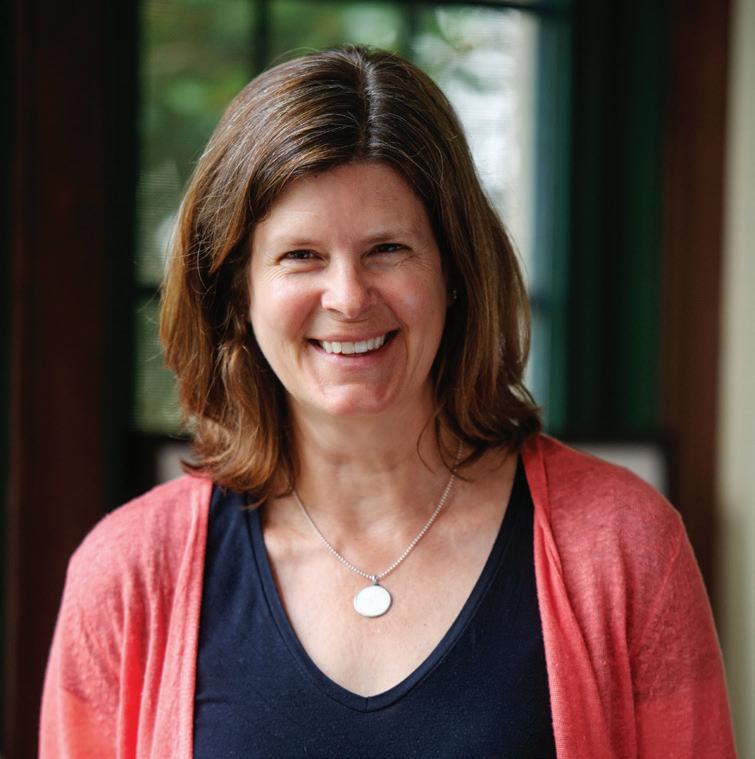

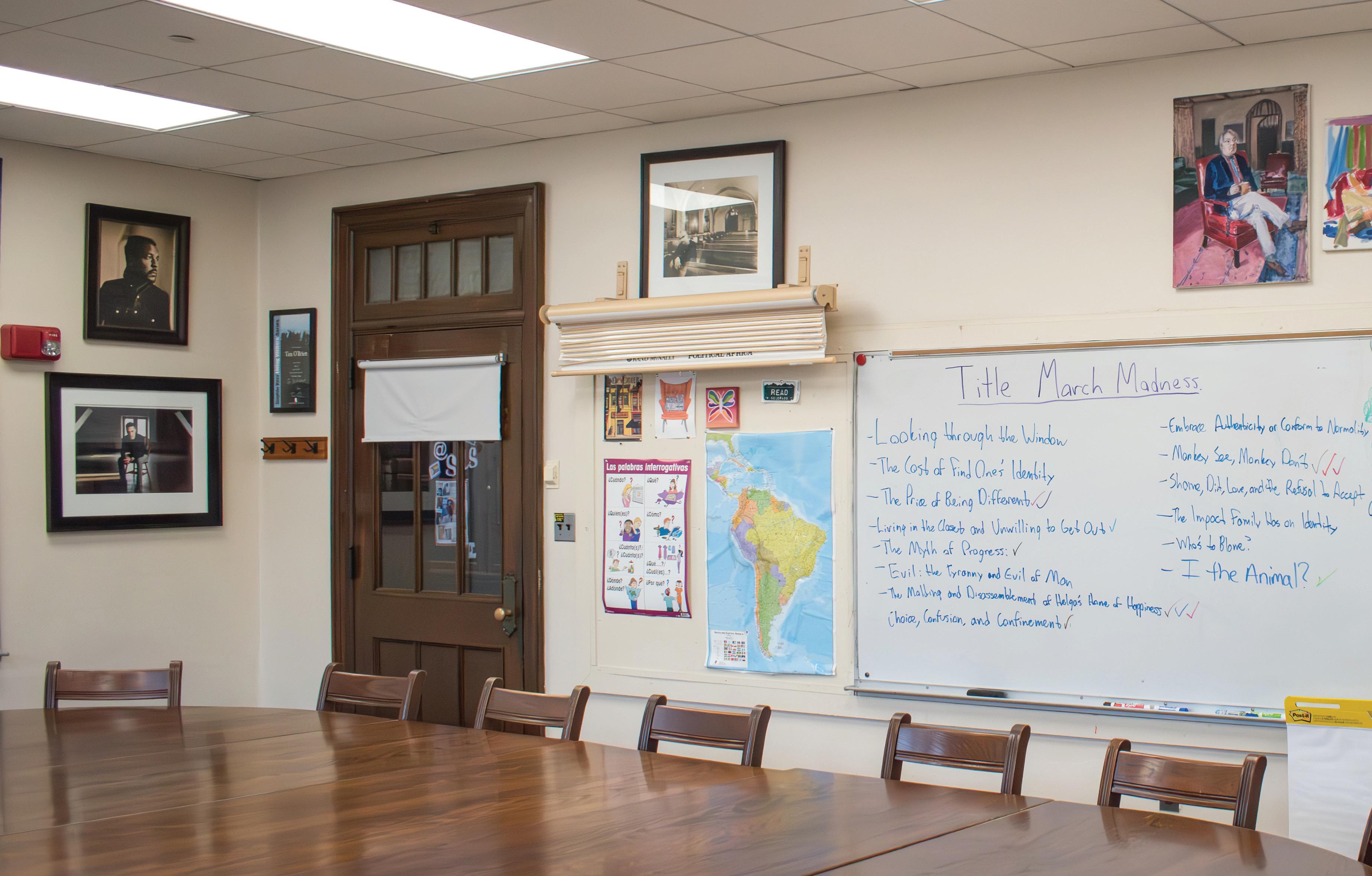
01 02 04 06 07
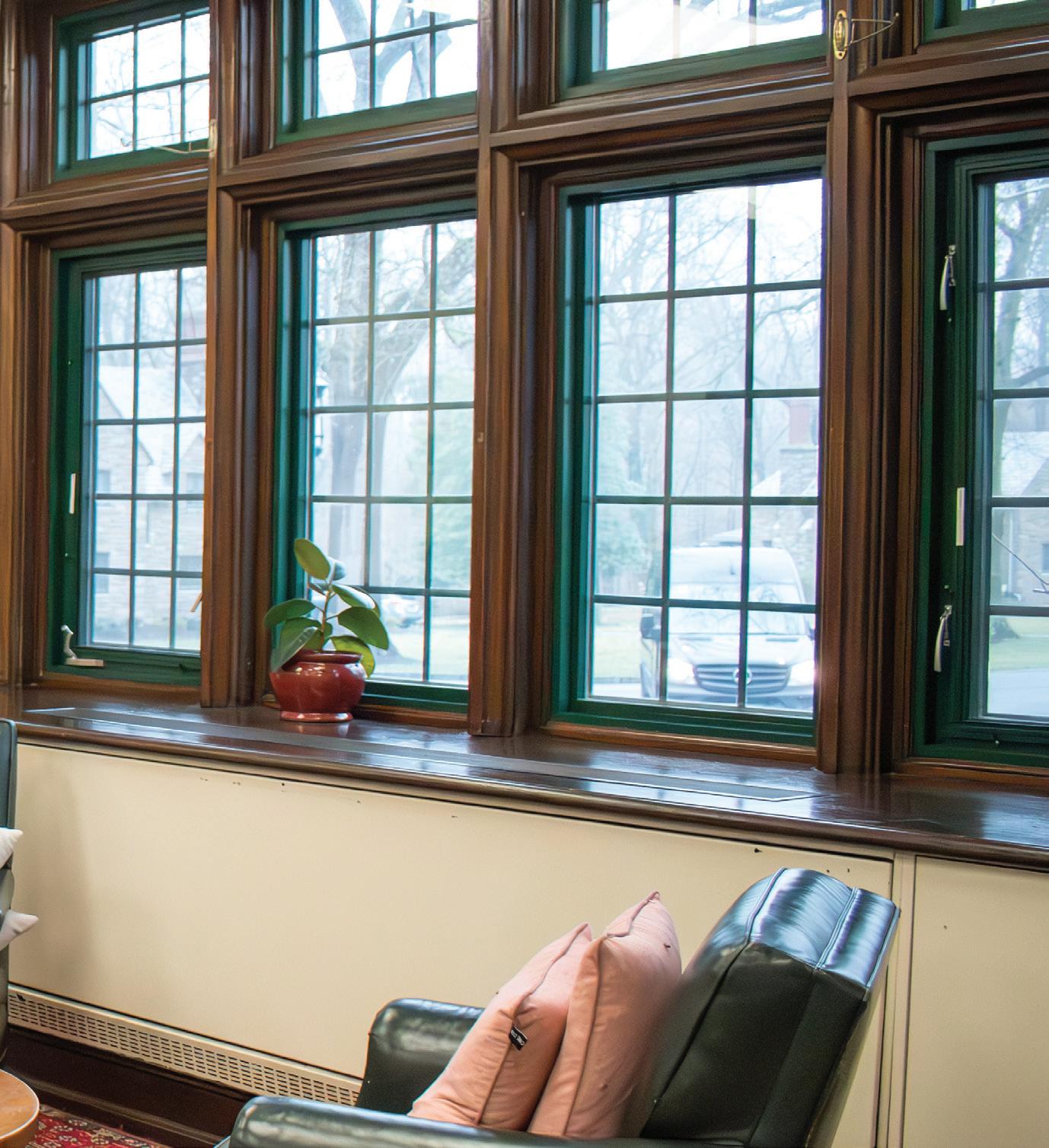
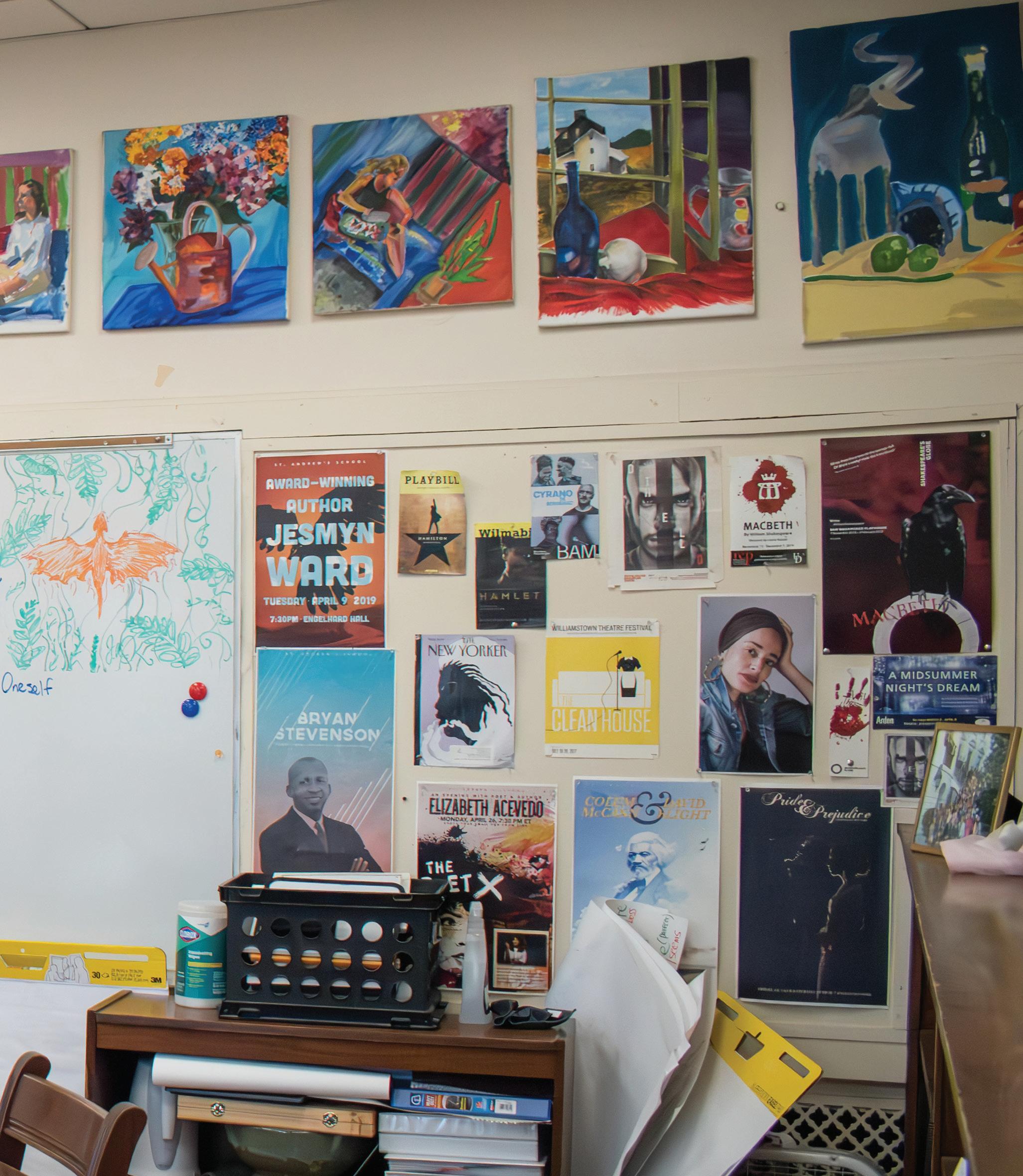
Stuart Chair in English Gretchen Hurtt culture & community disguised as a classroom
01 GREEN POSTER “One of the hardest things we have to do in the academic space is reassure students about writing,” says Hurtt ’90 P’22,’24. “A lot of students get ‘stuck’ when they’re trying to write. Parents come in and comment on the poster, too. I think they feel relieved that this is how we talk about writing here.” (The sage advice reads, “First drafts don’t have to be perfect. They just have to be written.”)
02 AUTHOR PHOTOGRAPHS Two-time Pulitzer Prize for Fiction winner Colson Whitehead (top), Pulitzer Prize in Fiction finalist Nathan Englander, and Pulitzer Prize in Fiction winner Junot Díaz (top right), all shot by Arts Department Co-Chair Joshua Meier P’24 when the authors visited campus. “I inherited these from Elizabeth Roach, who was instrumental in getting these authors here,” Hurtt says. “This room contains the history of my predecessor, the work of the department, and the beauty of the St. Andrew’s community.”
03 STUDENT ART “It’s important to me to celebrate our students, our culture, and their work, so I highlight student art,” she says. “I love looking up and feeling the connection I had with all these students over the years.” (Shout out to Juliet ’25, whose white board marker art is often a topic of conversation.)
04 SAS PENNANT The first thing Hurtt would run to rescue in a fire? Her beloved St. Andrew’s pennant, which has been proudly displayed in Hurtt’s various spaces—college dorm rooms and classrooms—since she got it as a 1990 SAS graduate. “It’s just a very special memory for me,” she says.
05 THE VIEW Hurtt takes the time to appreciate what’s right outside her windows. “All four seasons, the trees are peaceful to look at, particularly in the spring when the cherry blossoms kind of float down across my windows like snow,” she says.
06 SAS WHITE-OUT PHOTO “I love this photo of our students,” she says, “but more so, I love the story that this photo tells of that year, and of their resilience [during Covid-19].”
07 THE CLASSROOM 18 LOUNGE “I have the luxury of this little area that I built with my home coffee table,” Hurtt says. “I have small-group work here, advisory functions, and what I think I like best is how this area is utilized on weekends by students, who will put a movie on and hang out. I want this to be a home-like space, and I have total trust in the students on the weekends.” •
SPRING 2024 23
TALK OF THE T-DOCK / 03 05 OFFICE SPACE


“I am lucky to have a lot of supporters who believe in me,” he says. “Although I can motivate myself, I enjoy having a voice like [Boys Crew Head] Coach [Will] Porter [’96], who believes that I can do things well and go fast. Coach Porter has provided me with great training advice, but his unwavering support of me and our boats makes our team better.”

SATCHEL BARNES ’24
KENYON COLLEGE
TRACK & FIELD
It’s incredible the weight that a mere .007 seconds can hold. That’s the unit of time by which Satchel Barnes won the 55-meter dash in his last race as a Saint, simultaneously setting a new school record and sending the indoor track team to the No. 1 spot on the podium at the Delaware Independent School Conference tournament. Helping bring home a championship was the highlight of the senior’s season, particularly considering Barnes had other athletic pursuits in mind upon arriving to Middletown from Sri Lanka.
“I came here intending to play soccer, basketball, and baseball, yet my senior year, I ran varsity cross-country, and captained the indoor track and field team,” he says. “St. Andrew’s athletics program helped me find where I felt I belonged. The entire athletics department was a complete step up from anything I had been exposed to in Sri Lanka, and that alone pushed me to take advantage the best I could.”
The fleet-of-feet Barnes is packing his running shoes for Kenyon College’s Track & Field team next year. He credits becoming so good at his craft with involvement in other sports along the way. “I would never have gotten as fast as I had if it hadn’t been for my preparation for my other sports,” he says.
Barnes has had to overcome two crushing injuries: a torn ACL his sophomore year, and a repeat of the same injury this year, which sidelined him from his last season of SAS lacrosse as a varsity starter. “Tearing my ACL sophomore year completely changed the trajectory of my athletic career, and in the moment,
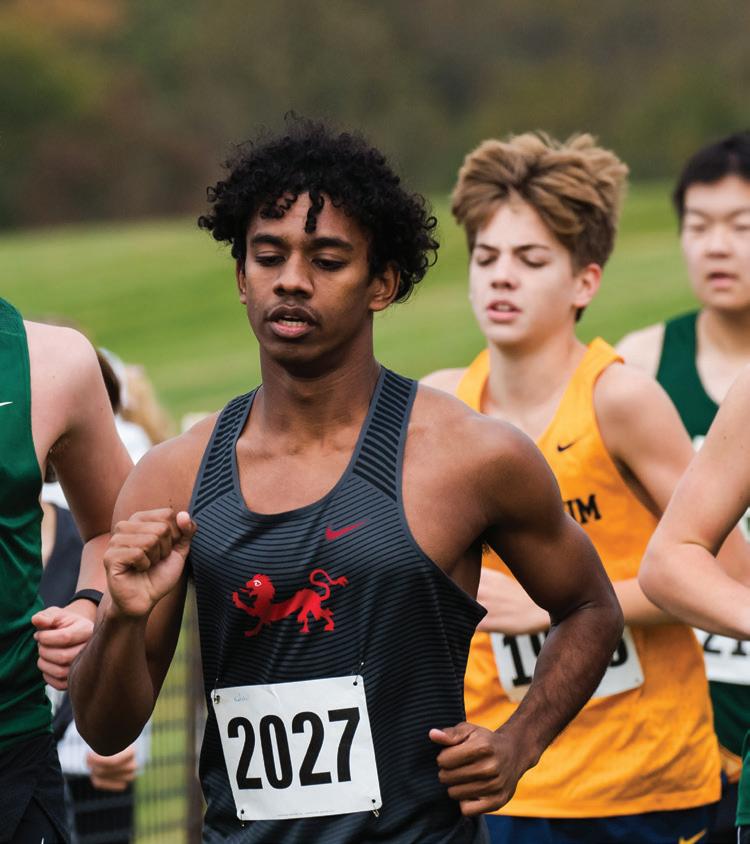

“I came here intending to play soccer, basketball, and baseball, yet my senior year, I ran varsity cross-country, and captained the indoor track and field team. Andrew’s athletics program helped me find where I felt I belonged.”
—Satchel Barnes ’24

I felt absolutely hopeless,” he says. “My teachers, friends, advisors and my basketball coach at the time, Terrell Myers, played a big part in helping me stay upright, and keeping me motivated through what was a really hard time.”
Staring down the same injury again, Barnes is taking it in stride. “I’m still trying to make myself useful on the lacrosse team as a level head and leader, regardless of the fact that I can’t contribute on the field,” he says. “I’ve still got a ton I want to do before I say goodbye to St. Andrew’s, and I don’t plan on letting an injury I beat once as a sophomore hold me back this time around.”
In times like these, Barnes turns to a personal motto that keeps him grounded: “The path we seek is never straight.”
“This is [an idea] that I’ve taken to heart, especially considering that my first injury is what redirected me from basketball to running,” he says. “This is just another fork in the road. To anybody struggling with an injury, you will be more than all right in the end. Lean on your friends, find the small positives, always trust your dedication, always trust your work, and you’re going to be just fine.”
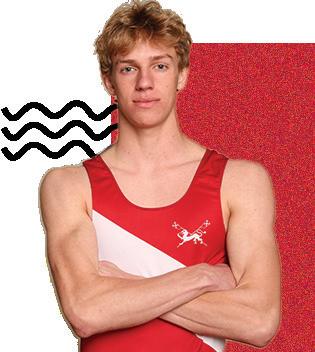
Cooper Drazek is still buzzing from this year’s St. Andrew’s Delaware Independent School Conference (DISC) Boys Swimming Championship. “That has to be one of the biggest accumulations of my efforts that I’ve ever experienced,” Drazek says. “Coming into SAS as predominantly a swimmer, I would not be where I am in regard to rowing without swimming. Being a multi-sport athlete allowed me to transfer things I learned
SAS / ST. ANDREW’S MAGAZINE
COOPER DRAZEK ’24 BATES COLLEGE CREW
from different environments and different people into being the best I can be.”
A title is nice, but Drazek is hungry for more. “I’ve really developed a love for competition, and the feeling of excitement with each event at St. Andrew’s,” he says. “SAS has always left me wanting more after each of my seasons because of how fulfilling they individually felt. Moving on from each season has a bittersweet feeling. I know I’ll take that same feeling with me into college athletics.”
Although ending his final swimming season at St. Andrew’s was difficult, he has his final season of crew to look forward to. “I wasn’t ready to give up such a large part of my life,” he says. “Thankfully I had my peers and coaches with me. My swim coaches and my crew coaches all understood what I was feeling and were there to help me. I now know that I will never fully be done with swimming or crew. I will continue to practice, and I will have the connections I made through my time on each team for the rest of my life.”
The athlete who will enter Bates College in Maine this fall is different from the athlete who first walked onto the St. Andrew’s campus. “I used to have a different idea of athletics. It was always an ‘extra’, something added on to my life,” he says. “Now I see it as an integral part of who I am.”

“If you told freshman-year me that I was going to become a college athlete, I never would have believed you,” says Zoey Honsel. Perhaps even more shocking to Honsel is that she fell in love with rowing, as it was crew winter workout that presented the then IV Form Honsel with her most daunting task as an athlete. “I was facing a lot of challenges that winter, so by 4:00 each day, the last thing I wanted to do was sit on an erg machine in the cold, surrounded by upperclassmen who generally had a lot more experience and excitement than me,” she says.
Yet as the cold weeks rolled on, dread soon melted into triumph. “As the season progressed, I began to find joy in these grueling workouts, and gain confidence from the support of my teammates to the point that winter workout
became the constant of my day that I actually looked forward to the most,” she says. “I’ve grown to enjoy the effort, pain, and joy of athletics.”
Honsel also draws on lessons she learned her III Form year on the field hockey pitch, which proved to her that the point of athletics is not simply to win. “During the fall of freshman year, we were on campus, but with a lot of COVID restrictions, and were unable to play any other schools,” she says. “Regardless of having no official games, the team still met every day, working hard and having fun, to the point that most days, the whole team would stay after the required practice time to continue playing. I think the biggest take away I’ve gotten from Saints Athletics is the importance of a team culture.”
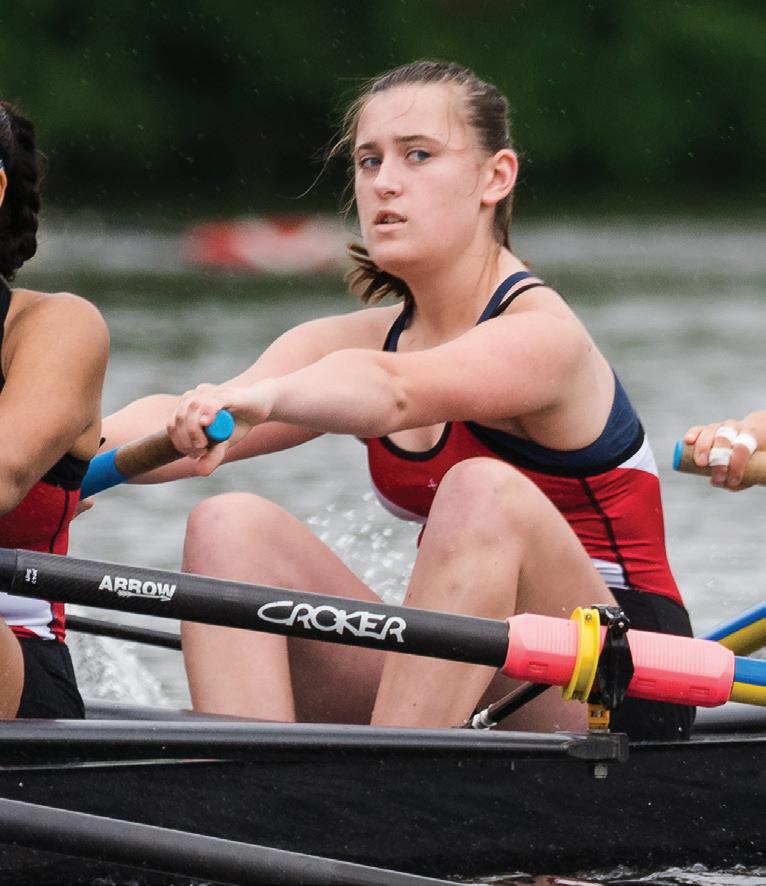
The rower, set to trade Noxontown Pond for Messalonskee Lake in Maine, has mixed emotions about all the change on the horizon. “While I know it’ll be so hard to say goodbye to St. Andrew’s, I’m excited for college,” she says. “I’m especially excited to get to know a new team and to live in Maine, even though it’ll be a lot colder rowing on the water than I’m used to.”
Honsel feels gratitude for the people and programs at St. Andrew’s that helped her get to this point. “Especially my rowing coaches during my time here, Mr. [Christopher] and Mrs. [Lou] Berl [’84 P’17,’19,’22] and Mr. [Wilson] Everhart [’95]. They helped me grow into the athlete I am today, pushing me to work hard and find pride and confidence in what I can do. I’m so grateful for all that they’ve done for me.”
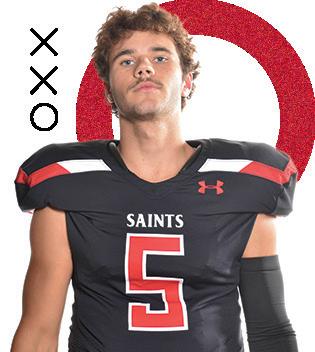
Frank Nasta can recall the play like it happened yesterday. During the secondto-last game of his senior football season, with roommate and teammate Griffin Patterson starring in his first game since returning from an injury, the pair connected on a spectacular throw and reception.
LET’S GO SAINTS! / 27
ZOEY HONSEL ’24
COLBY COLLEGE
CREW
FRANK NASTA ’24
MACALESTER COLLEGE
FOOTBALL
“It was under the lights at Seaford. On a third-and-long, we called a deep shot to Griffin,” Nasta remembers. “He caught it in stride and dragged a couple of defenders [with him] until he went out of bounds inside the ten-yard line. From that moment on, I knew that the rest of the season was going to be a lot of fun.”
Not only was the moment important to Nasta because of the way the whole football team rallied around Patterson when he went down and celebrated his dominant return, it was also important because, for Nasta, football has become a way of life. “Each moment of the game is so special that they have a way of engraving their way into your brain,” he says.
This ever-present passion for the sport wasn’t always the case. “I think if you went to my freshman-year self and told him all my athletic achievements, he would be shocked,” Nasta says. “Before SAS, I never played tackle football. I had no idea if I would be good, I just knew I wanted to be good. I didn’t think that playing in college would ever be a possibility. Throughout this [recruitment] process, I have learned to believe in what is possible.”
Nasta attributes his opportunity to play collegiate football to Head Football Coach Patrick Moffitt. “I owe everything in my football career to Coach Moffitt,” he says. “Ever since I stepped on campus during Covid my freshman year, he saw something in me that I didn’t see. I hope that I lived up to the expectations that he set for me.”
While Nasta’s final season quarterbacking SAS football did not go as planned—the squad narrowly missed the playoffs after a season of tough lessons and triumphant comebacks—what he’ll most remember is the way he spent the night after the team lost its first game of the season, the game that injured Patterson and another key player, too.

“Before SAS, I never played tackle football. I had no idea if I would be good, I just knew I wanted to be good. I didn’t think that playing in college would ever be a possibility. Throughout this [recruitment] process, I have learned to believe in what is possible.”
—Frank Nasta ’24
“That night, I visited all of the football players just to talk to them and make sure that they were feeling ok,” Nasta says. “[The talk] helped recenter me, and helped me realize that the season was not lost because at the end of the day, we were still a team and the relationships that we would form would still last a lifetime. I just want to thank anybody who I ever took the field with: none of this would be possible without each one of you.”

When Luke Ochis thinks about the pond that winks and beckons from right outside his Founders windows, he can’t help but feel lucky. “For years, I’ve rolled out of bed, walked down one flight of stairs, and there it is,” he says. “There are very few schools that could have better prepared me for this moment. Every Saturday in the spring, we have people come here and race. They have to take apart their boats, drive for hours, reassemble their boats, race, take them apart again, drive hours home, and I’m just … here. When you have such opportunity [as an SAS student] to race, to always be preparing for a new checkpoint, it becomes second nature.”
Rowing wasn’t always second nature to Ochis, who wanted to be a soccer standout. But he found himself on an erg for the first time his III Form year and realized his physicality alone made him a force to be reckoned with. “I wouldn’t say I was ‘athletic’ at the time, but I was big, and my sheer size made my erg time really good, one of the fastest of all the freshmen.”
That’s the kind of statistical detail Ochis used to get lost in. “It used to be all I’d want to do is tell people how good I was at something. I was very into getting results and displaying them, getting what I could out of those results, and not really work for it that much afterward,” he admits. “But I soon came to realize when you’re good at something, you’ll tell everyone. But if you are great at something, everyone will tell you. So I made that switch to almost quietly putting the work in.”

While he’ll miss many things about St. Andrew’s, nothing competes with the boys in the boat. “The thing about rowing is you’ve got all of your best friends in the boat,” Ochis says.

SAS / ST. ANDREW’S MAGAZINE 28 / LET’S GO SAINTS!
LUCAS OCHIS ’24
MIT CREW
“You look beside you, and you see your competition, which is likely another boat full of best friends, and all you need to do to win is to work together and prove that you’re the boat of better best friends.”

FOOTBALL
From the football field, to Amos classrooms, to Founders dorms, if you’ve met Griffin Patterson, you’ve likely noticed the competitive spirit he carries with him. What you might not know, though, is the origin story that inspired Patterson to never back down.
“My sophomore year, during my first ever playoff game, I was picked up and fully suplexed over someone’s body,” he says. “That was the moment I decided I needed to start putting some more work in if I wanted to succeed in my sport.”
Whether he’s putting extra effort into the weight room, taking additional reps after practice, or studying film in his free time, Patterson doesn’t miss a chance to improve. He encourages others not to, either. “No matter what grade you’re in, start working now,” Patterson says to any athlete who aspires to play college sports. “No matter how good you think you are, there’s someone better who wants the same thing as you. The only way to surpass them is to just put in the time.”
That mentality was helpful when Patterson had to overcome his most significant setback: a broken collarbone his senior fall. “The people who helped me through it the most were my roommates, my coach, and athletic trainer Al Wood,” he says. “They made sure that even when I wasn’t able to be out there playing, I was keeping my spirits high and put in work wherever possible.”
Patterson says Wood has been in his corner since he arrived at St. Andrew’s. “Showing up as a tiny freshman, he didn’t treat me any differently than the seniors who he had known for years. He made time for me if I needed it and walked me along with all the other new kids through the proper technique for every lift,” he says. “He

continued to push me to better myself no matter the sport I was playing. Outside of his job as athletic trainer he was simply one of my biggest supporters. He genuinely wanted me to succeed, and that feeling made me want to push myself even harder.”
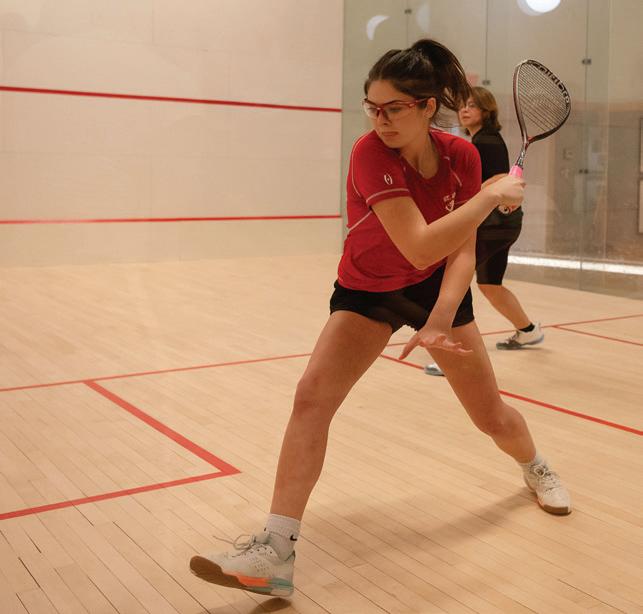
No stranger to adversity, the once “tiny freshman,” “suplexed” as a sophomore, and injured as a senior has pushed himself all the way to MIT football. “I was always doing a sport no matter the season, so even when I wasn’t training specifically for my main sport, I was working on things that would benefit me: speed, hand-eye, strength, etc.,” Patterson says. “If you really want to achieve something athletically, there are resources available and people [at St. Andrew’s] who will go out of their way to make that happen.”

Before Markley Peters found herself with a position on Denison University’s squash team, she was only considering schools with club teams. “At first I wasn’t sure if I was good enough to be on a [varsity] team, or if it was even what I wanted,” Peters says. “However, within five minutes of talking to the coach [at Denison], I couldn’t imagine pursuing a different college experience.”
Pursuing is the key word here, as Peters was aggressive in reaching out to coaches. “There is no harm in reaching out to coaches if college athletics is something you’re interested in,” she says. “Keep an open mind. I wouldn’t be in this position if I didn’t take the first step.”
Always “in-season” as a multi-sport athlete, Peters is excited to tackle her first collegiate season. “I think I’m prepared for the longevity of a college season,” she says. She also feels better prepared to tackle the intersection of collegiate academics and athletics because of her time at St. Andrew’s. “Balancing the time commitment of athletics with schoolwork can be challenging,” she says. “I’ve missed classes for away games and matches, which has actually made me a stronger student in the long run. I have learned how to communicate with my teachers and seek help proactively.”
LET’S GO SAINTS! / 29
GRIFFIN PATTERSON ’24 MIT
MARKLEY PETERS ’24
DENISON UNIVERSITY SQUASH

Peters says she’s grown, emotionally and athletically, as a byproduct of SAS sports.
“When I arrived as a freshman, I was very unsure of myself and relied on my older teammates’ directions,” she says. “As I’ve gotten older and developed more confidence, I’ve become a more prominent voice. I have also learned to advocate for myself and my teammates, which is especially important in squash where matches are refereed by other players. I still have a lot to learn, but being comfortable speaking up has made it much easier to pursue feedback and advice.”
A major factor in Peters’ growth mindset has been being surrounded by women coaches, particularly Jenny Carroll, who helms girls cross-country and varsity lacrosse; and Head Girls Field Hockey Coach Kate Cusick.
“I am so grateful for all the incredible women who have coached me,” she says. “Each one has inspired me on and off the field. Mrs. Carroll has been my No.1 supporter since freshman year. She holds many titles in my life: teacher, coach, and advisor, but honestly, I just consider her my second mom. And although Ms. Cusick only came to SAS last year, she has already made a big impact on me and the entire field hockey program.”
Peters was particularly inspired by the trust she says Cusick extended to her and the field hockey team. “[Coach Cusick] listened to every idea we had no matter how crazy it was,” she says. “This created a really positive atmosphere that was infectious for the entire team and helped us have the most successful season our school has seen in years.”

If Stella Roffers’ new teammates on the University of Texas-Austin’s crew team find her bopping along pre-race in her own little dance circle, they can blame St. Andrew’s for that. The 1V Boat ritual—Roffers’ boat mates always danced to the same songs, but the playlist is too sacrosanct for print—will remain one of the athlete’s favorite memories STELLA ROFFERS ’24 UNIVERSITY OF TEXAS-AUSTIN
from SAS crew. “That entire boat changed the way I row, and who I am as an athlete,” Roffers says. “These are the moments that will stay with me for the rest of not only my athletic career, but also the rest of my life.”
She credits much of who she is as an athlete to Girls Crew Head Coach Wilson Everhart, whose words on simply being present will stick with her. “He said you’re not going to be able to perform at your personal best every day, but it is about showing up and giving what you can because that is what makes a difference to not just you, but the team as a whole,” she says.
At St. Andrew’s, our student-athletes are surrounded by many unofficial coaches, too, like Al Wood, the school’s longtime athletic trainer, whom Roffers turned to, time and time again, over her athletic career.
“[Mr. Wood] has been there for me for all four years,” she says. “He has supported me, pushed me, healed me on multiple occasions, and does so much more than most people realize. I have learned so much from him about how to take care of injuries, and how to help other people.”
Roffers notes she appreciates the school’s emphasis on being a multisport athlete. “It enables you to become a more well-rounded athlete,” she says. If playing collegiate sports is top of mind for any of her fellow Saints, she has some advice: “Use St. Andrews’ as a building block,” she says. “Figure out parts of [your] team that you want or would change, and find a college team that fits those needs. It also doesn’t have to be a stressful process; you will end up where you are supposed to be.”
As she reflects on her time at St. Andrew’s, Roffers can’t help but consider the student she came here as and the leader she leaves here as. “I see someone who has grown into a leader,” she says. “Coming into sports here I wanted to be a person who could lead a team, but I didn’t have the tools to actually be that person. St. Andrew’s has taught me how to be a player with integrity and strength, and a player who can have fun while competing.”

30 / LET’S GO SAINTS!
CREW
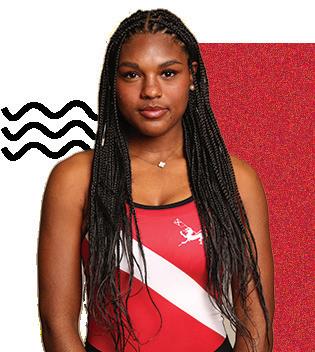
JOYE WINGARD ’24
HARVARD UNIVERSITY CREW
Anyone who’s watched Joye Wingard do her thing on the water might be shocked to know that before her commitment to Harvard—a school lucky enough to gain two of our rowers next year—she only had one full year of SAS rowing under her belt. “I didn’t even decide I wanted to try to row in college until I experienced rowing at St. Andrew’s,” she says. “I have the best boat ever, and I’m with the best girls ever. I consider them my sisters, and I really felt that bond within the boat. It made me realize how much rowing is more than just a sport.”
Wingard tried other athletics pursuits—she was a swimmer, for example—but didn’t get that feeling of family she craved due the individualistic nature of the sport. “The family feeling of crew drew me in, but also I’m very competitive, and crew offers both: a strong sense of team, and the independence and the ability to be able to work my hardest, which I can’t wait to take to Harvard. I am so excited for the competition and the challenge.”
Once Wingard realized that she wanted to take her rowing to the collegiate level, an assist from a SAS alumnae helped elevate her game. “This summer, I did an intensive, four-week summer crew program with Ready Set Row, coached by Holly Austin [’97], who not only went to St. Andrew’s, but also rowed at Harvard,” she says. “It was so wonderful to feel that personal connection with her.” It was also good for Wingard to see the many ways crew can stay with you for life. “I can’t imagine ever not doing this,” she says.
As Wingard prepares to trade St. Andrew’s red for Harvard Crimson, she thinks about a favorite mantra that she’s borrowed from Head Coach Wilson Everhart:

Everything is on the table, nothing is guaranteed. To her, it means no dream is out of reach.
“This contributes to my mindset of never giving up because you never know what is to come, especially being underdogs,” she says. “I very

“I
can’t even imagine what it’s going to be like, and how I’ll feel, the weeks leading up to my last times on the water as a student. The season goes by so fast, you’re putting in all this hard work, but also, one day will be my last day. I want to use every moment of this season, every moment on the water, to really appreciate it.”
—joye wingard ’24

much believe our team is capable of doing anything, and that’s because of Mr. Everhart. I have friends who have rowing coaches that will yell at them and be on their case if they have to get off the erg or leave practice because something hurts. Mr. Everhart is totally the opposite. I am so grateful he’s created the space for us that he has.”
Wingard recently experienced one of what will be many lasts this crew season: her last first day of the season. “I can’t even imagine what it’s going be like, and how I’ll feel, the weeks leading up to my last times on the water as a student,” she says. “The season goes by so fast, you’re putting in all this hard work, but also, one day will be my last day. I want to use every moment of this season, every moment on the water, to really appreciate it.” J
SPRING 2024 LET’S GO SAINTS! / 31
SAS / ST. ANDREW’S MAGAZINE 32
Making Teachers
THE GENESIS OF THE ST. ANDREW’S TEACHING FELLOWS PROGRAM
BY TARA LENNON
AS A FORMER wildland firefighter in Salt Lake City, Alec Hill ’12 wore two different hats: a white one and a gray one, each signifying his fire crew at the time. As an editorial assistant and managing editor of The Sewanee Review, the oldest continuously publishing quarterly literary magazine in the nation, he didn’t wear a hat to work, but if he did, perhaps it’d be something writer-ish, like an Irish flat cap or fedora.
Now as an English teaching fellow at St. Andrew’s, Hill is wearing a hat with an unfamiliar fit: the Mr. hat, that which signifies authority and adulthood and all that comes with it in the space of educating teenagers at a boarding school.
In some ways, this particular piece of headwear is tougher than the one that could literally withstand fire because this one needs to withstand something even scarier: the notion that he’s the guy with the answers.
“It’s just a strange experience to suddenly put on the role of ‘Mr. Hill,’” he says. “That hasn’t stopped being strange. Yet, in some ways, you just start playing the role.”
As Hill has put on his Mr. hat, he has watched the former misters in his life doff theirs: English teacher Will Porter and biology teacher Dan O’Connell, who he once knew as Mr. Porter and Mr. O’Connell, are now just “Will” and “Dan.” While he says this has been a “ground shift,” it’s also been humbling and rewarding.
“They still have plenty to teach me, but we can also relate as adults, and they take my ideas seriously and they care about how I’m doing, and they’re my friends,” says Hill. “That feels amazing.”
At St. Andrew’s, the idea of being a wearer-of-many hats is not uncommon: throughout the day, faculty are dorm parents, teachers, coaches, advisors, unofficial cheerleaders, official bearersof-caffeine, and so much more.
SPRING 2024 33
MAKING TEACHERS /
But the newly developed Teaching Fellows program at St. Andrew’s—a program which aims to attract and retain early-career teachers by helping them dip their toes into boardingschool life with mentorship, support, and without the workload of a fulltime faculty—changes the game. The program fundamentally allows for the exchange, negotiation, and the tryingon of different hats at St. Andrew’s in a way that was not entirely possible prior to its development.
All St. Andrew’s teaching fellows—the school has four this year—are navigating their own unique pathways into the classrooms and dorms and onto the fields; as well as the transition to a different phase of life, whether that’s watching teachers become colleagues like Hill, or figuring out adulthood and life as a post-graduate.
As the fellows take on their various roles, they aren’t forced into ones they’re not quite ready for. They can try on the teacher hat in co-teaching and solo-teaching settings, yet wait to put on their advisor hat until they have better adjusted to campus life.
“I don’t think I could have done this without the teaching fellow set-up, or I could, but it wouldn’t have been pretty,” says Hill. “I needed a year with training wheels to figure this job out.”
THE ORIGIN OF THE PROGRAM
DEAN OF FACULTY Development Emily Pressman says the Teaching Fellows

program’s custom-fit experience is specifically suited to early-career teachers in terms of their schedule, and the levels of support and mentorship they require.
“In some ways, [the origin of the program is] sort of a combination of a personal story and a professional story,” Pressman says.
Pressman began her teaching career as a teaching fellow herself at Phillips Academy, and saw the value of a program that provides a pathway into the life of an educator. The following school year, Pressman packed her bags and came to St. Andrew’s (bags that have yet to be re-packed as Pressman is in her 21st year here). Though she jumped immediately into the responsibilities of a full-time faculty member, she says St. Andrew’s had the support she needed as a new teacher, with mentorship from former faculty members Brad Bates, Nan Mein, Nigel Furlonge, and Lindsay Brown, all whom she credits with shaping her into the teacher she is today.
“I know that for me, if I hadn’t been in a place that was so thoughtful pedagogically about what we were doing in the classroom and with colleagues who both supported and coached me, but also really trusted me to be in the classroom and allowed me to do things right off the bat, that I wouldn’t be nearly as as passionate and engaged of a teacher now as I think I am,” she says.
Now as dean of faculty professional development charged with the hiring of future St. Andrew’s educators, Pressman cooked up the idea of an intentional fellowship program at the school to make the school an even better place for those teachers, and for the community as a whole.
“On the one hand, [the early-career teachers] don’t have teaching experience, but they have really fresh and really well-developed experience working with the best scholars in the fields
“I don’t think I could have done this without the teaching fellow set-up, or I could, but it wouldn’t have been pretty,” says Hill. “I needed a year with training wheels to figure this job out.”
that they’ve just been studying,” says Pressman. She adds it’s also beneficial to have people who can fulfill needs of the school—like coaching, dorm duty, and all of the other key duties that drive boarding-school life—even if they aren’t yet teaching a full load in the classroom.
Ultimately, why did our teaching community buy into such a program? Because, she says, St. Andrew’s educators are not just concerned with “creating great teachers” for our students, but for students everywhere. The Teaching Fellows program fit neatly into the St. Andrew’s mission of not just teaching students, but teaching teachers.
THE PILOT YEAR
KYRA WILSON DIDN’T always know she wanted to go into teaching. History, though, they always felt called to.
After her sophomore year of college, Wilson was a teaching assistant for high school students at the National History Academy, a summer program for “history nerds” like herself, she says. They were paired with a teacher who did not take the teaching assistant position lightly and wanted Wilson to be actively collaborating.
“That was scary in a lot of ways, but also I think it made me realize that I had a lot of the natural instincts of being up in front of high school students, and I was getting a lot of joy out of that in a way
SAS / ST. ANDREW’S MAGAZINE 34
HILL READS A PASSAGE IN HIS CREATIVE WRITING 1 COURSE, THE SOLE CLASS HE SOLO TEACHES.
that I hadn’t previously considered,” says Wilson. That eye-opening summer program, along with reflecting on their experience of growing up in a tight boarding-school community with their parents as educators, convinced them to consider teaching. She began looking at fellowship and full-time positions as a candidate through educator recruitment service Carney, Sandoe & Associates her senior year of college.
Months later, in the fall of 2022, Wilson found herself on campus as the first and only fellow in St. Andrew’s new program. Not long after moving into an apartment on Moss, Wilson heard a banging sound in the room above.
They went upstairs to assess the situation. After she knocked on the door and introduced herself, the student—who was kicking the stubborn riser on her bed with her orthopedic boot—immediately embraced her in a hug.
“I was like, ‘Oh, this is the kind of community I’ve walked into,’” says Wilson.
From that moment of being so vulnerably welcomed by one of their residents, to her first history department meeting, Wilson says she felt immediately trusted and accepted into the St. Andrew’s community. Their colleagues sought out their opinions and perspectives, yet there were support systems in place for them to rely on as they adjusted to the ups and downs of their first year as an educator.
The first semester, she co-taught U.S. History alongside History Department Chair Matt Edmonds and taught that same course solo during a different block—the now-standard teaching load for fellows. “This is your course,” they remember Edmonds telling them about their co-taught course. He was there to guide and support, but for this period, she was the conductor.
“I left last year being very excited to come back, and very excited to take on more responsibility and to continue to push myself and grow into the educator that I want to be, while knowing that I still have plenty of work to [do to] be that person,” says Wilson, who acknowledges not just support from Pressman and Edmonds, but the entire school community.
Yet both Pressman and Wilson acknowledge one thing was missing from the pilot year of the program: more fellows.
A FELLOWSHIP OF FELLOWS
PRESSMAN SAYS SHE always wanted the fellowship to be an actual fellowship—that is, a community of fellows who can go through the experience together, sharing the highs and lows of their newfound career but also the personal transitions they may be going through.
“It was hard to be the only one, the only fellow and one of the [few] younger faculty members on campus,” says Wilson. “So there was a sense of not knowing how my experience compared to other people because it had been a while since there had been anyone in similar shoes to me.”
This school year, Pressman realized her dream, as a cohort of four fellows joined the teaching community: Hill, Spanish teaching fellow Anabel Barnett, science teaching fellow Alex Horgan ’18, and religion and philosophy teaching fellow Connor Doughty.
As there’s something thrilling about getting a new class of III formers each year, there’s something equally exciting about a group of young faculty coming to St. Andrew’s. They bring new life to the school, renewed enthusiasm about the possibilities of their work, and a dictionary’s worth of unexpected adjectives to describe student essays (Dean of Teaching & Learning Gretchen
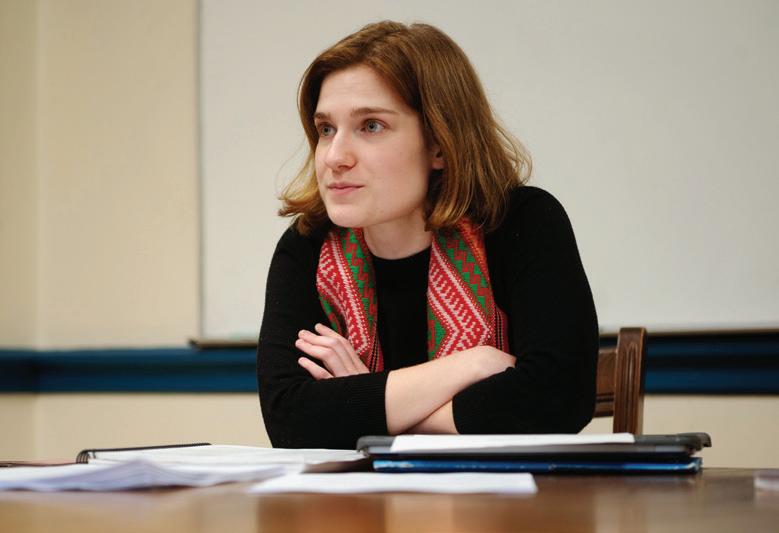
Hurtt ’90 P’22,’24 has a favorite of Hill’s: “baggy.”).
“The kids seem to really love this idea that there is sort of a next generation [of faculty], a generation that’s closer to them,” says Barnett. Barnett and Hill have cherished the experience of going through the process of teaching for the first time communally, collaborating with other teaching fellows and hearing about how the program is working in other departments.
This year’s cohort comes from a variety of backgrounds, and found their way to St. Andrew’s in notalways-linear ways.
Barnett, a recent college graduate, got the gig after meeting Pressman at a new faculty dinner back in May. She wasn’t faculty—her partner and now-fellow teaching fellow Doughty was. After Pressman and Barnett met, Pressman immediately recognized the qualities she looks for in a fellow in Barnett: passionate about community, coachable, and well-versed in their discipline. She saw Barnett’s potential to not only be a fantastic fellow, but fantastic educator—even if Barnett didn’t know that herself yet.
While the program allows for fellows to do everything, from coaching field hockey to advising the student-run publications, like all things at St. Andrew’s, the beating heart of this program extends from the classroom.
FELLOWS IN THE WILD
HILL MAY KNOW how to put out wildfires, but Mr. Hill has a whole other
SPRING 2024 35
MAKING TEACHERS /
THIS YEAR, WILSON’S TEACHING LOAD CONSISTS OF TWO U.S. HISTORY SECTIONS AND TWO RESEARCH SEMINAR SECTIONS.

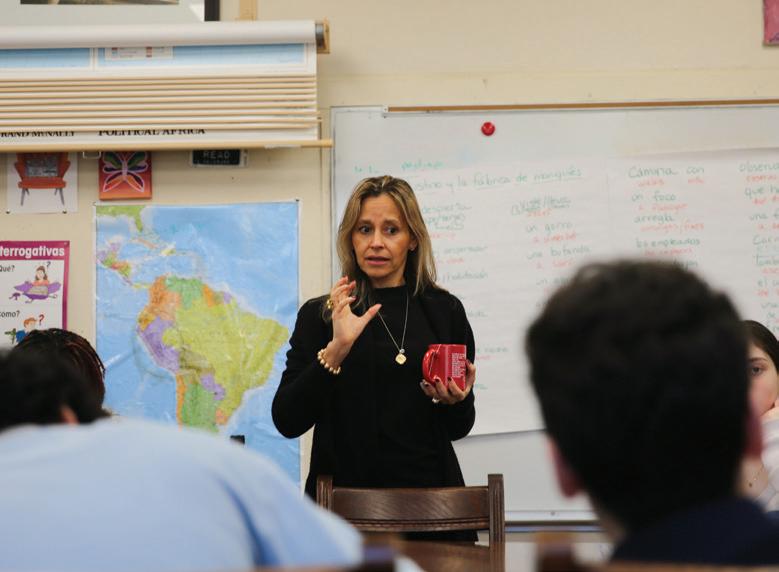
type of heat on his hands: the ebbing and flowing fire of dialogue in his St. Andrew’s English classroom. At one second, the flames may be raging, and at another, it might need a little kindling to keep it going.
Hill says this was one of his greatest learning curves in terms of managing the classroom: figuring out how to be open to the energy of his students, yet also knowing how to guide the discussion to where he needs it to go.
“What elements of a chapter haven’t we covered? What are we overlooking? How do I nudge us in that direction without grabbing the microphone and just starting to insert my own opinions?” Hill says of the constant monologue that runs through his head at the seminar table.
With the help of veteran teacher Hurtt, who is in her 20th year at St. Andrew’s, Hill has never had to look too far to understand how to wield the energy in the classroom—he says his co-teacher has the “experience, patience, humor and standards” to just know how to gently get the students to where they need to be.
One Friday afternoon, in Advanced Study English 4, Hurtt and Hill expertly handled the highs and lows of discussion, somehow always knowing how to pick up where the other left off. Just as they urged students to be the “tour guide of their paper,” advice aimed at helping students structure their senior exhibition paper, the teachers were the tour guides of the class period: they bounced off each other’s ideas, engaged in discussion with individual students, checked in with each other about their progress, kept the pace of the classroom, and occasionally used weird but charming phrases that one would usually find in a St. Andrew’s classroom, like, “have a whack at it.”
This balance and rhythm is not unique to the English department, although each fellow and their tandem teaching partner speak a unique classroom language. In Spanish 1, Associate Head of School Ana Ramírez and Barnett showcased a similar game of metaphorical ping-pong as the duo passed ideas and guidance as the class progressed.
Barnett has a confidence in the classroom that just looks easy, the same graceful confidence Ramírez developed from the years of experience it took for her to master the art of creating a vibrant classroom. They guided students through a quiz review with animated delivery and ease. The energy was high, a product of the III formers who filled the seats, and the fast, dynamic approach of the instructors.
“Ana’s truly a master of teaching language,” says Barnett. “The way that she handles predominantly young underformers in the classroom, it’s just amazing to watch.”
She says that Ramírez has taken her “under her wing,” allowing her to thrive in the subsequent Spanish 1 course she teaches on her own. However, that class is not just entirely made up of III formers, but a mix of III, IV, and V formers. As
the year progressed, she learned to make instructing adjustments to keep the upperclassmen involved. Ramírez has provided her with the “toolbox” for teaching that class on her own, she says.
With her tools, Barnett says she has developed her own teaching style over the course of the year, one that emphasizes the “symbiotic” relationship between teacher and student.
“I want [the students] to be themselves in the classroom,” says Barnett. “I want them to enjoy what they’re learning. I want them to feel comfortable enough with me to talk to me and be honest with me and be themselves, but also respect me at the same time.”
Speaking of symbiotic relationships, the fellows program benefits veteran teachers like Ramírez, too. Ramírez arrived at St. Andrew’s immediately after graduating from Kenyon College (which also happens to be her mentee Barnett’s alma mater). She had advisees, she was in charge of a dorm, and she was teaching. “It was a lot,” she says. Twenty-six years later, Ramírez is still here; now, as associate head of school, she spends a lot of time out of her classroom, working on critical aspects of student life and supporting Head of School Joy McGrath ’92. But Ramírez has discovered that having Barnett as a teaching fellow beside her helps her do something she never wants to lose sight of: keep her finger on the pulse of what’s happening in the classroom.
“I am a teacher at heart,” says Ramírez. “I could not do the job that I do even with all the responsibilities if I am not in the classroom … And so I don’t want to see the school from a lens that is 360, but I want to be right in it and to help all of us make decisions that are grounded in experience and not just from observation.” Having Barnett alongside her, she says, is the “blessing” that allows her to accomplish just that and to
SAS / ST. ANDREW’S MAGAZINE 36
BARNETT GUIDES III FORMERS IN HER CO-TAUGHT SPANISH 1 COURSE THROUGH A QUIZ REVIEW.
RAMÍREZ SUPPORTS BARNETT IN FACILITATING VOCABULARY REVIEW IN SPANISH 1.
continue to support the success of each student, who is “a world of their own.”
For Hurtt, having a teaching fellow in the classroom allows her to slow down and to think in a new way about the teaching that she has done for years.
“[Hill] is a writer himself and he studied literature very deeply, so he often just describes what one does as a writer very accurately and in a fresh way, [which I appreciate] because I’ve been using the same phrases and pieces of advice for years,” says Hurtt.
Teachers are always reflecting on their classes, Hurtt says, and so having someone with whom to discuss how a class went is highly beneficial to her own development as a teacher and leader.
“They are great eyes and ears on our courses and on our teaching ... it helps the veteran teacher to reflect, to explain [what we do in the classroom], and maybe to think critically about all those choices that we’re making,” says Hurtt.
THE FUTURE OF THE FELLOWS
EVEN AFTER QUADRUPLING the amount of fellows from the pilot year to now, Pressman says the program still has room to grow. She notes that the biggest
roadblock this year was a scheduling challenge that made it difficult for the whole cohort to meet regularly.
“This is a place where time is one of the commodities that we have the least of,” says Pressman. “Without [a time to meet] built into the class day as we had intended for it to be, it just made it much harder to formally gather the group. What I’d really like is for us to move in the direction of having a more substantial curriculum for teaching fellows so that there’s more opportunity to not just learn by doing, but also to be reading some of the great thinkers in education and having conversations about that and building that additional layer of professional development into the program.”
Pressman also plans to continue the school’s commitment to diversifying the faculty through the program. Pressman and Dean of Inclusion & Belonging Dr. Danica Tisdale Fisher are doing so by working with the Pipeline Cooperative, a network of schools and educators of color who connect directly with local colleges to grow the next generation of teachers at independent schools.


and the system and the schedule we have for all teachers?”
Pressman acknowledges that while the program aims to retain fellows who will go on to shape the future of the school, there will be some fellows who decide not to live the boarding-school life after their trial year.
“They are great eyes and ears on our courses and on our teaching ... it helps the veteran teacher to reflect, to explain [what we do in the classroom], and maybe to think critically about all those choices that we’re making.”
“I’m really excited and really hopeful that the Teaching Fellows program will be an avenue for recruiting early-career candidates of color and early-career candidates that represent the diversity of the student body in all sorts of ways,” says Pressman.
Hurtt’s positive experiences with the program have prompted her to reflect on the process of onboarding of all new teachers at the school, regardless of years of service. “Ideally, someone would be talking with every teacher about their work every day,” says Hurtt. “A lot of times [full-time faculty are] in isolation, but the fellows are not. They get to be in constant dialogue. So how can I replicate that with the structures
“I think it’s totally okay and really great and exciting if it gives folks a chance to be here for a year or two and then be able to say, ‘Wow, that was really rewarding, and it actually helped clarify for me what else I want to do that isn’t quite this.’”
However, she says, she hopes that the program will be something that “opens a door to a lifetime career of teaching”—the same type of lifetime career and calling that she, Hurtt, and Ramírez have pursued with unwavering commitment.
“It’s a program that is designed to help that new teacher come and experience this incredible life,” says Ramírez. “Because [teaching at a boarding school] is more than just a job.” J
SPRING 2024 37
PRESSMAN LEADS CAROLINE MEERS ’24 AND MARY TROY ’24 IN AN ORAL EXHIBITION FOR THEIR FINAL PAPERS ON TONI MORRISON’S BELOVED
MAKING TEACHERS /
HURTT, IN HER CO-TAUGHT ENGLISH 4 COURSE WITH HILL, LEADS A WORKSHOP ON STRUCTURING THE SENIOR EXHIBITION PAPER.


Let The Good In
A conversation with Teaching Fellow and Boys Cross-Country Coach Alex Horgan ’18 and Science Teacher and Boys Cross-Country Head Coach Dan O’Connell P’19,’24,’27 on bonds formed on the trails, in the classrooms, and beyond
EDITED AND CONDENSED BY AK WHITE
t was only a matter of time before our “If These Walls Could Talk” series—in which Saints past and present share a conversation inspired by a shared campus space—hit the great outdoors. Any St. Andrean will tell you that magic happens out on our trails: the conversations, the sights, the camaraderie, the core memories formed. Who better to speak to the wonders of our woods than members of our cross-country team? Peter Bird ’25 and Chris Onsomu ’25, two elite St. Andrew’s runners making quite the name for themselves in the sport, interviewed Teaching Fellow and Boys Cross-Country Coach Alex Horgan ’18 and Science Teacher and Boys CrossCountry Head Coach Dan O’Connell. The conversation ranged from falling in love with running, to falling in love with teaching, and all of the interesting St. Andrew’s relationships at hand: Bird and Onsomu run for and have been taught by O’Connell and Horgan, Horgan was coached and taught by O’Connell as a student, and now, Horgan and O’Connell teach and coach together. The overall take away? Running is hard. Teaching is hard. But you let the good in, and you get the good out.

LET THE GOOD IN /
SPRING 2024
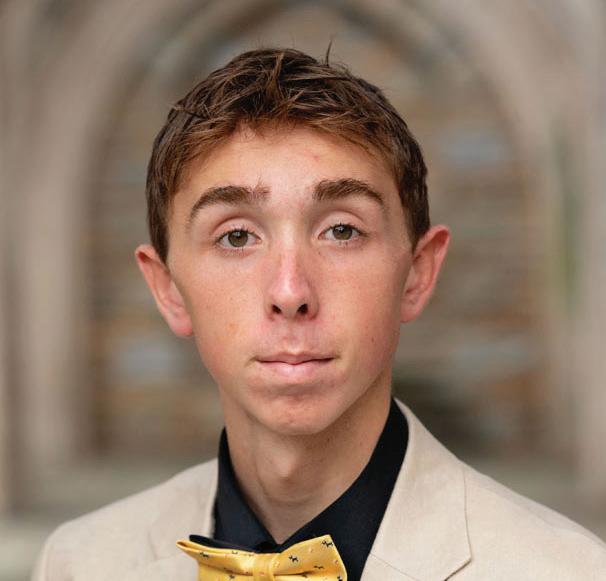

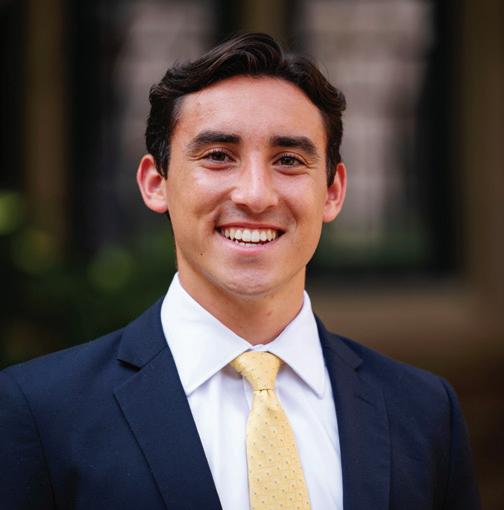

CHRIS: How’d you fall in love with running?
ALEX: I started very young. My grandfather ran for the University of Delaware and my mom ran for East Carolina University. My dad ran, too. When I was about 6, my grandfather would take me to tracks and I’d run the 55-meter dash and he’d teach me simple running skills, like track starts. My first cross-country season was in third grade. I started getting serious about running in sixth grade.
DAN: I played soccer as a midfielder. I wasn’t the most skilled player, but I could run. I had a feeling that someday, I’d be a runner. The first opportunity I had to run as a sport was my freshman year of high school. I remember I asked my mom to buy me these shoes. They weren’t the kind of shoes that you would just casually run in, they were racing shoes. I was not the kind of kid who would ask my mom to buy me clothes, so non-essential running shoes? Forget it. I have three brothers, so it was often hand-me-downs. But I got the courage to ask, and she bought them. I remember holding the shoes in my hands and thinking, ‘I’m going to do something.’ I’m getting choked up telling this story. I broke the school record for the mile as a freshman in those shoes. The story continues, but that’s the origin.
PETER: Did your relationship with running change once you got to St. Andrew’s?
DAN: I came here 25 years ago already deeply passionate about running, so that doesn’t feel like it changed. What has changed is my relationship with coaching, and my relationship to what I thought I knew about running. When I first got here, I was very eager to coach, but I didn’t think of it as an essential part of my job. Where I grew up, teaching was the critical thing. It’s been a shift for me to consider coaching as not a required ancillary duty, but a core focus of my professional life.
I’d been running for a long time before St. Andrew’s and I truly didn’t think I had anything new to learn until I had a showdown with [Athletic Trainer] Al Wood, who has been one of my greatest friends over the past 20 years. He said to me, ‘So-and-so’s injured, so I’ll take him from here for the week.’ And essentially I said, ‘You don’t know as much as I do about running injuries. No one could. That’s absurd. You’re muscling in on my territory.’ And he said, ‘No, this is my territory.’ Which of course it was. That was a failure to understand that I had so much to learn. All these years later, I try to remain a student of running.
ALEX: We weren’t running year-round when I got here. Indoor track didn’t exist my first two years, so I just had cross-country, which was a different kind of running season


/ FEATURE
PETER BIRD ’25
CHRIS ONSOMU ’25
DAN O’CONNELL
ALEX HORGAN ’18
40
than I was used to. Junior and senior year I started running indoor track. Mostly I just loved running whenever I could find the time, regardless of a team. A lot of that came from working with Coach O’Connell. His whole philosophy is that he wants people to love running and not just be there for the times and competing.
As I now coach with him, in addition to him being my teaching fellow mentor, so much of his philosophy comes through in my coaching and teaching, which is simply love what you’re doing. I don’t think I always knew that when I was at St. Andrew’s. When I got to college, I tried to stay tapped into what Coach O’Connell taught me.
PETER: What other lessons has Mr. O’Connell taught you?
ALEX: I have memories as a student and athlete of Mr. O’Connell where we’d be on the trails and he’d say, ‘Stop.’ There wouldn’t be much other context outside of, ‘This is a really beautiful moment that we should take in.’ It was about remembering why we’re out there, and how lucky we were to be doing what we’re doing. You only have so many opportunities to look at and celebrate this one thing, so take the time to do it.
“I have memories as a student and athlete of Mr. O’Connell where we’d be on the trails and he’d say, ‘Stop.’ There wouldn’t be much other context outside of, ‘This is a really beautiful moment that we should take in.’ It was about remembering why we’re out there, and how lucky we were to be doing what we’re doing.”
—ALEX HORGAN ’18
CHRIS: What’s going on there, Mr. O’Connell? What are you trying to get us to understand?
DAN: Coming out through the fields and watching the sunset, of course we pause and let the good in—we must let in the few seconds of joy after an hours-long period of training misery. Flush the misery. Those rare joyful seconds might seem like they don’t deserve to be the focus of one’s memory or attention, but you don’t need to be fair-minded when curating your experiences. Instead, we can choose to hold in memory the few seconds of pleasure and let the rest wash out of us. It might be a tiny moment of camaraderie or support from a teammate. It might be laughing at a joke or whatever—something very disproportionately small when compared to the whole experience. I think what I truly mean by ‘let the good in’ is ‘let the good in disproportionately.’
CHRIS: Do you think running SAS trails as a student inspired your love of environment and science?
ALEX: I do. I think it ties into teaching, too. I really liked high school, and I think a lot of that stemmed from spending so much time outdoors. I spent hours upon hours in these woods. You’re bound to see so many things: deer, a cool bird, different trees, beautiful vistas. That inspired my interests. I loved having someone I could ask big questions to about it all, and now I’m somebody who can be asked these questions.
PETER: Mr. O’Connell, did running inform an interest in biology and the natural world, or did an interest in biology and the natural world inform running?
DAN: There are always layers to why one continues to do something, but to start, neither of those was true. Over the course of my life, the ‘being in nature’ part became paramount. There was a period where I wouldn’t consider living somewhere that I couldn’t run right out the door into something beautiful. I would rather live where there’s good running than have a good job. That was my priority for a while.
I remember as a young runner being somewhat disdainful of people who ran for ‘health reasons.’ To me ‘health reasons’ wasn’t secondary, it was worse than secondary, it was negative. If you’re running because it’s good for you, I thought you were missing the point. You’re trying to get something out of running that keeps you from truly living in the moment. I remember telling my wife [SAS Choral Director] Quinn [Kerrane P’19,’24,’27] on our first date, which was a blind date, that I liked to run, but I wasn’t into fitness. Now that’s changed. I’ve had students who are really serious athletes, who are entirely tuned in to biology because they are understanding the physiological impact of their


LET THE GOOD IN /
SPRING 2024
athletic pursuits, yet as a coach, I never know how to discuss the physiological benefits of practice because I don’t want to turn it into a classroom. The way we talk about getting in shape is incredibly vague. I can explain for them: here are the systems that you’re stressing during this workout, and the stress is going to produce these responses, and then you’ll be in shape. I’ve got really thoughtful runners, like Peter, who are invested in this kind of thinking.
CHRIS: What are the parallels between running and teaching?
ALEX: In your training, you have to be consistent, but every day doesn’t have to be perfect. You can have good days, you can have bad days, you just have to do it. The way we approach a semester as faculty is day after day of doing small things. As a new teacher learning about the process of teaching, I’ve discovered there’s faith you have to have that the bits and pieces you’re putting in are going to pay off. When I look back to the fall, specifically my intro bio class, we started with very basic ideas, like, ‘How do you make an observation?’ or ‘How do you ask a good question?’ It can feel repetitive in the beginning because it feels like every day we’re talking about the same concepts, but all of a sudden, the questions we’re asking and observations we’re making are much stronger.
DAN: Obviously one of the things that leads to academic success is intelligence, but some educators buy into the philosophy that everyone can do everything: all you need is grit. Science doesn’t back that up. As teachers, we must signal to students, ‘You are going to be excellent in this subject and not as excellent in this subject’ and offer honest feedback. In terms of changing one’s ability to succeed academically, the only knob we can really turn is the knob that deals with effort and attitude. So what’s the best way to teach the idea that consistent daily effort pays off? I learned that better in the athletic realm and carried it into the academic realm. Of course everybody understands that effort is good and that performance gains will come from effort. But it’s one thing to know that in the abstract and it’s another thing to actually see it. And when you actually see it, I think you develop a much healthier understanding that you can carry into your academic life. Small, daily, conscientious work is what transforms. I deeply believe coaching students helps create better students.
CHRIS: Mr. Horgan, what have you found to be most surprising now that you’ve come back to school in this new capacity?
ALEX: You don’t realize all the roles until you’re doing it. I’ll be working with someone in the classroom, 30 minutes later I’m coaching them, and then two hours later I’m checking
them in on dorm. Being able to shift those relationships is tricky. The role I’m serving as teacher in the classroom is very different than the relationships I hold on dorm when everyone is unwinding for the night. There’ve been adjustments I’ve had to make.
PETER: Why did you choose to join the Teaching Fellows program?
ALEX: I always had an interest in boarding schools, and I deeply agree with the mission of St. Andrew’s. In the fall of my senior year of college, I was in the process of considering grad school or what type of work I want to do when St. Andrew’s had a job posting for the fellowship and it sounded like an incredible opportunity.
I didn’t know if I’d be suited to just show up and teach right away. But the year-long mentorship and reduced course load offers the ability to really transition and get your footing. For me, it made teaching no longer feel like a stretch; instead, it was something that I could jump into and do.
PETER: How do you think your triple-threat relationship with Coach O’Connell—former athlete and student, current co-coach, current teaching partner—has shaped your SAS identity?
“Small, daily, conscientious work is what tranforms.”
—DAN O’CONNELL
ALEX: I was really excited to coach with Mr. O’Connell because I knew what his program looked like as a student. When [former cross-country teammate and fellow Teaching Fellow Alec Hill ’12] came back to teach and coach, we were already in this relationship with running as adults where we’re doing it because we love it, which came from Coach O’Connell. We do this out of passion. That’s a shared mentality between the coaching staff.
In the classroom, it’s similar to what I used to experience with him as a student in the woods. In the fall, with Intro to Bio, we spend so much time getting outside doing observational activities and exploring. The whole goal is just to appreciate what’s around us and ask questions and be curious. And I think that his idea is, let the students be curious and get them


/ FEATURE
to love science and be interested in science beyond a textbook. It’s very similar to this cross-country coaching philosophy, where we take something that can be daunting and make it seem really approachable and engaging and actually fun. We have a lot of fun in the classroom. There are days where we’re serious and locked in and there are days where there are a lot of laughs and it’s very intentional. There can be times it seems like, ‘Oh, they’re not really paying attention’ when in fact it’s very strategic on his end, these pointed opportunities where he’s letting students explore and roam and get lost in it all.
DAN: I can’t say enough good things about Alex Horgan as a teaching partner. He’s so focused on doing a good job, and he’s really good at learning. He takes his job so seriously that he’s now an actual teacher within a very short amount of time. It took me four or five years to figure out how to be a teacher, and I feel like in his second year, he’ll be the teacher that I was in my fifth. He’s the perfect example of the athletic learning algorithm: he is incredibly conscientious and he doesn’t expect to be able to run a marathon on the first day. He understands there’s a process, and he embraces the process.
He’s been sitting in on one section of my biology class, and that section has been clicking along. I asked him if he’d consider coming to a different section, which wasn’t running as smoothly. He came, and he watched what was happening. He gave me some feedback that made a lot of sense. He’s already a colleague that I feel shoulder-to-shoulder with. As a co-coach, he makes up some of my deficiencies in a way that I appreciate. I think he sees that I sort of coach the bottom part of the team better than I do the top, so he’s taken over that space with a champion’s mental attitude. He wants to take a bigger swing. I think if we were to turn the program over to him, he’d say, ‘Yeah, state championships, that’s great, but let’s look even further beyond that.’
CHRIS: Not to call you out Mr. Horgan, but which class have you enjoyed teaching more: biology or environmental science?
ALEX: I enjoy the topics of environmental science more because what we try to do in that class is tie together different issues. While we might be talking about energy production and using solar panels, we can then tie in the political side, the economic side, the social impact. I love environmental science conversations because we have to consider so many angles and that really challenges me to think broadly as an educator. These topics are really complicated and it’s fun to work through those issues in real time in a classroom.
PETER: The first year of your fellowship is coming to a close. What’s next?
ALEX: This fellowship is truly so critical for those new to teaching to get a feel for it and really understand what we’re doing here. I’ve enjoyed the guidance from other faculty members and the predetermined course structure and materials that I get to work with, which has allowed me to truly focus on the act of teaching. I don’t have to build out my lecture slides every night. I don’t have to pick out a textbook at the beginning of the year. Every day, I’m engaging in the act of teaching. This has opened the space for me to decide if I love this or not, and the result is I’ll be back next year as a full-time faculty member.
CHRIS: So the program worked.
ALEX: The program absolutely worked. I feel like this summer, I can build on everything I learned this transitional year. I think I will be able to walk in the doors with more confidence next school year. This past September, each day going into the classrooms was a nerve-wracking experience, just knowing that it was up to me to manage that classroom, and not being so far removed from my college classrooms where if I was confused, I turned to my teacher and asked, ‘Can you clarify this? What’s the plan for this project?’ When my classes entered a new project or a paper or were working through a tough lesson, my students would start asking tough questions. Being able to manage those questions myself and not have that safety line of, ‘‘Well, let me just ask Mr. O’Connell’ because it was just me there … that was a learning curve I hope to have surmounted for next year. I’m really looking forward to what’s to come in all my roles here.
DAN: The first year at this place can be really, really tough. It’s hard to find an even-keel as there is simply so much we ask of our people. You ask yourself as a first-year teacher, ‘What is happening?’ and the answer is often, ‘Everything is happening.’ But Alex seems to have quietly surveyed the landscape, and said, ‘I’ve got this.’ J



LET THE GOOD IN /
43 SPRING 2024
Class Notes
Former
Faculty
Former St. Andrew’s faculty gathered in Providence, R.I., in December to celebrate the birthday of Joan O’Brien P’84 GP 15,’17,’19,’22, organized by Louise Howlett P’11,’14 and Lindsay Brown P’11,’14.
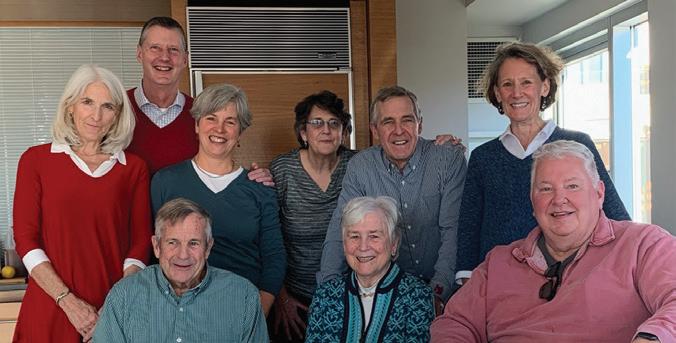
(l. to r., front row) Harvey Zendt P’03,’05,’09, Joan O’Brien, Lundy Smith. (l. to r., back row) Louisa Zendt ’78 P’03,’05,’09, Lindsay Brown, Louise Howlett, Gail LeBlanc, Peter and Darcy Caldwell P’07,’07,’10.
1954
George Baxter spoke at the memorial service of Bill Pope ’61 in New York, and wore his SAS blazer—yes, from his 1954 graduation!
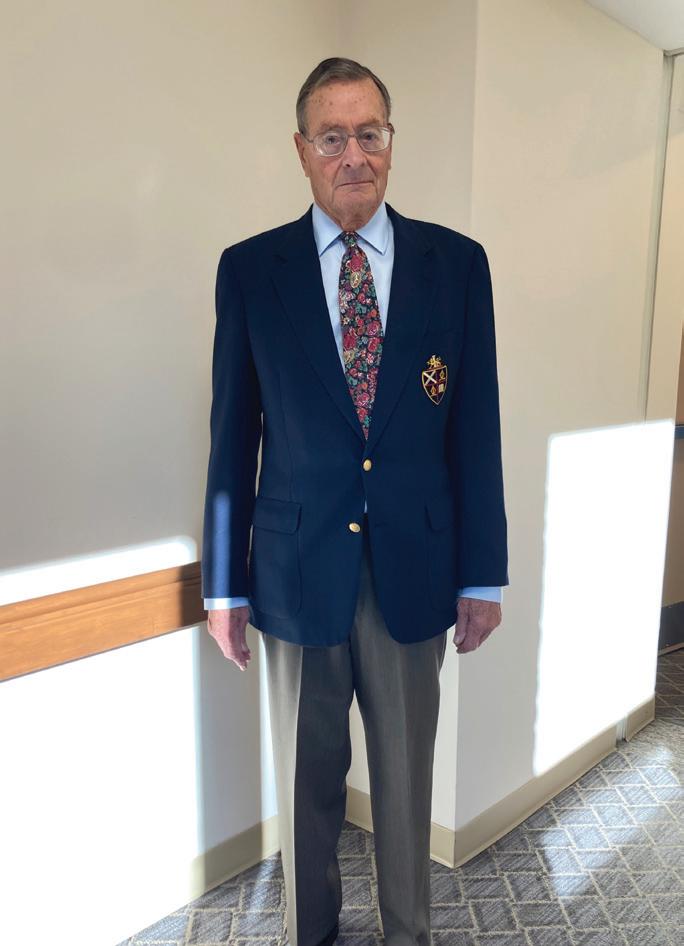
“In a good 2023, Evelyn and I produced 400 lbs. of vegetables for neighbors,” Church Hutton reports. “They are well—the Huttons, not the vegetables!—in good humor, travel often, and would welcome to their northern Virginia home any classmates passing by. The latter would not be required to till the soil.”
1957
1957 Omission and Correction: The last important sentence was not included in the previous note, submitted by Class Agent George Brakeley, with Barbara Ranck’s permission. Our apologies to and prayers for John. “I stopped for a visit with Barbara and John Ranck. John is battling dementia, but so far is able to remain at home in Paoli, Pa.”
Tim Bloomfield is currently in Punta Gorda, Fla., with his wife Susan and their dog Daisy. “I’m hoping to do some sailboat racing,” Tim writes. “We got here on our boat, having left Annapolis last October and starting March 1, we’ll head back across Lake Okeechobee and up the Intercoastal Waterway to get home in mid-April.” Fair winds and following seas, Tim, Susan, and Daisy!
1958
Members of the Class are still Zooming on the fifth of each month at 5 p.m. ET, and have widened the circle to include members of their surrounding classes. For February’s Zoom No. 38, Gordon Appell ’60 led a discussion about the Middle East. The previous topic was on memorable conversations around the SAS dining table.


1959
“It was a good year for two old folks, a year that included a tour with a nephew and his wife introducing some of their favorite places: Alsace, GarmischPartenkirchen in Bavaria, Lake Garda, Italy and finally Barcelona,” Andy Adams wrote in his 2023 Christmas letter. Andy and his wife, Liz, returned home via a transatlantic cruise to Fort Lauderdale.
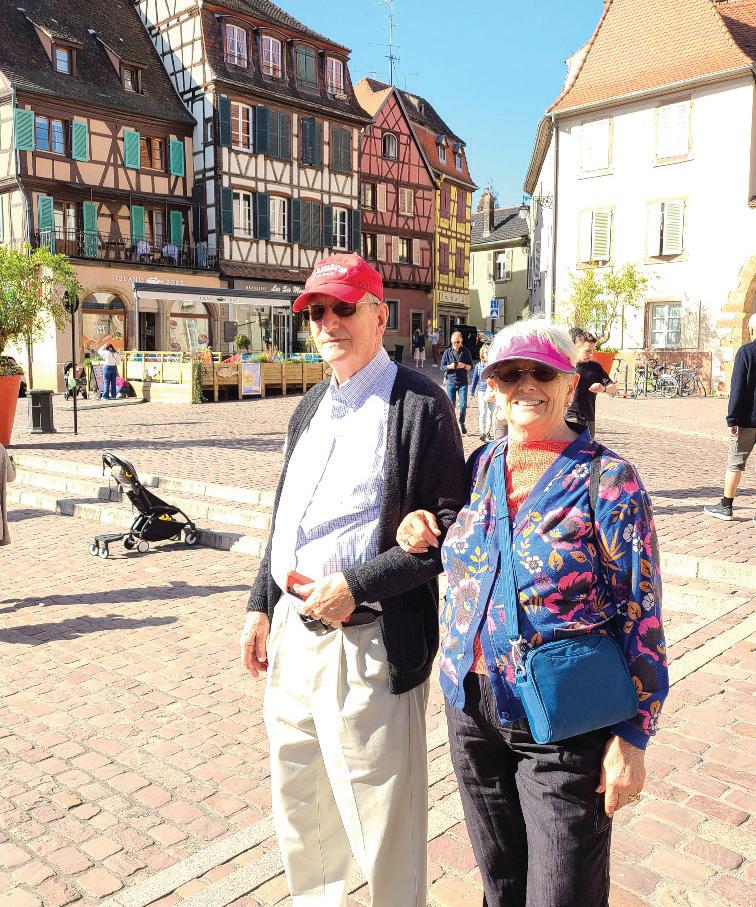
Last year was full of family celebrations and travel for Jim Thomas, including a trip to Rome with his daughter, Ginger. Whenever possible, Jim also hikes about two miles at Great Falls National Park, which he notes is a short drive from home. Oftentimes his son, Jim Thomas ’86, joins him.
1960
Gordon Appell is in his 17th year of teaching foreign affairs to seniors (citizens, not students) through the University of Denver Osher Lifelong Learning Institute (OLLI). There are over 100 OLLI programs across the United States.
SAS / ST. ANDREW’S MAGAZINE 44 / CAN'T HELP BUT CONNECT
(top row) Chesa Profaci ’80, Bulent Atalay ’58, Frank King ’58 (middle) Jim Thomas ’58, Chuck Miller ’58, Andy Adams ’59. (bottom) Charlie Wayne ’60, Pieter Voorhees ’60, John Hammer ’58
Jim Thomas ’86 and Jim Thomas ’58 hiking in Great Falls last fall.
Andy Adams ’59, sporting his SAS cap, and wife, Liz Adams, in the town square in Colmar, France.
John Beverley and his wife, Gay, a retired psychologist, and their daughter, Alisa, a veterinary technician in shelter medicine in Baltimore, celebrated Christmas in Wrightsville Beach, N.C. A few weeks later, they celebrated John’s 81st birthday.

Last December, Brian Fisher participated in a His Majesty’s Ministries performance of “Gloria: Perspectives of Christmas” as one of the Kings. “It required what I thought was a lot of memory of words to several songs,” Brian says. “But afterwards, I found I was able to lift myself out of the experience and instead focus on the meaning of the story.”

1962 and 1963

John Schoonover also attended a Loudon Wainwright ’65 concert in Elkton, Md., last November.
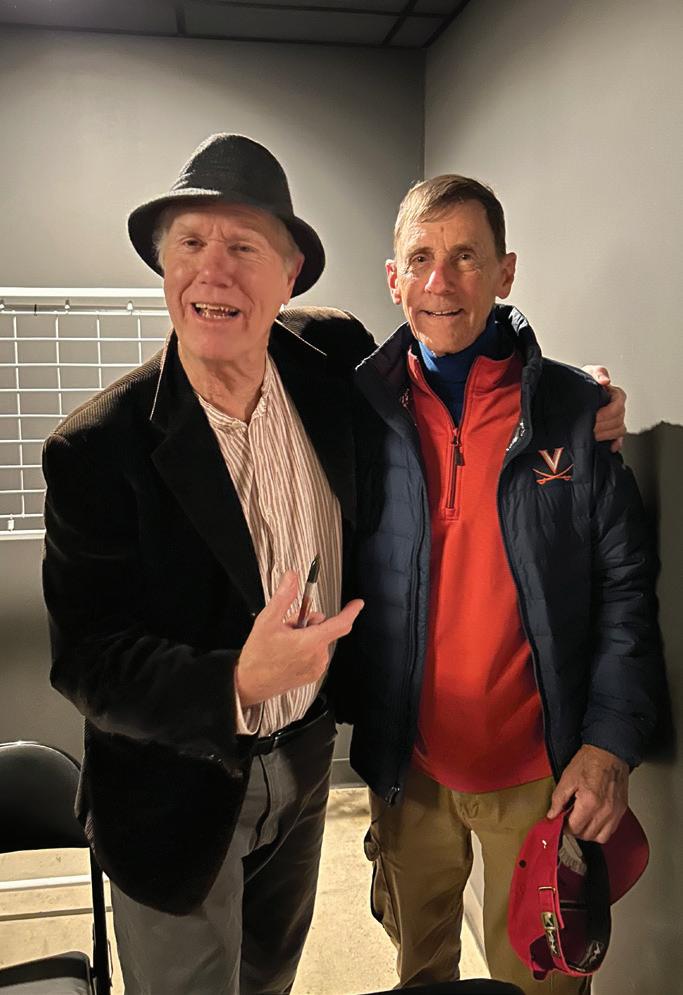
1964
The family of Mike Gerzso ’64 gathered for a photo op: (l. to r.) Daughter-in-law Adela, son Christian, wife Rosa Elena, and Mike.
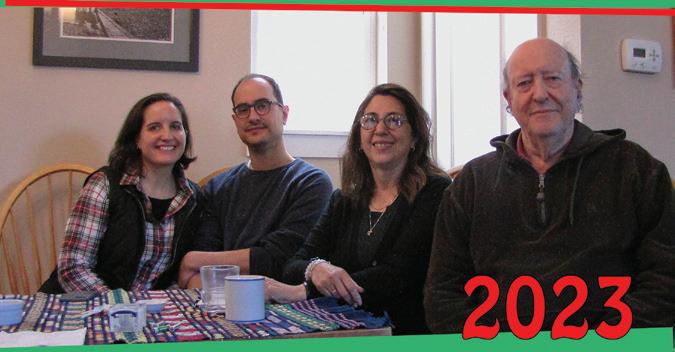
At his home in Maine, Steve Rutter was busy building a deck before the snow started to fly. The deck looks out to the Chandler River, he writes, which empties into the Gulf of Maine.
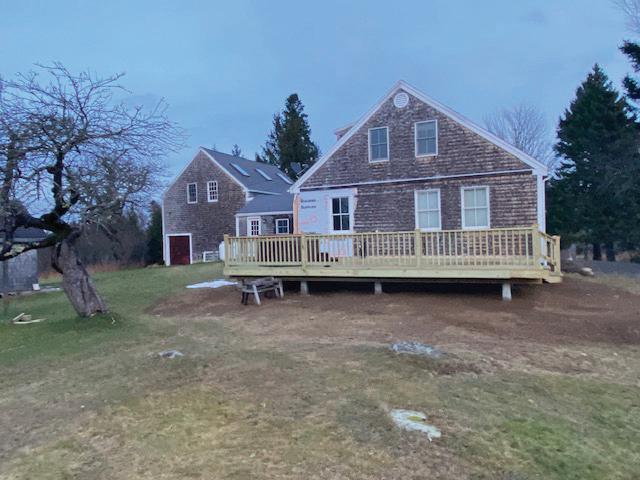
1967
In January, classmates and friends showed up for Roy Foster, who gave this year’s Levinson Lecture at St. Andrew’s, titled “Dead Poets and Live Issues.”
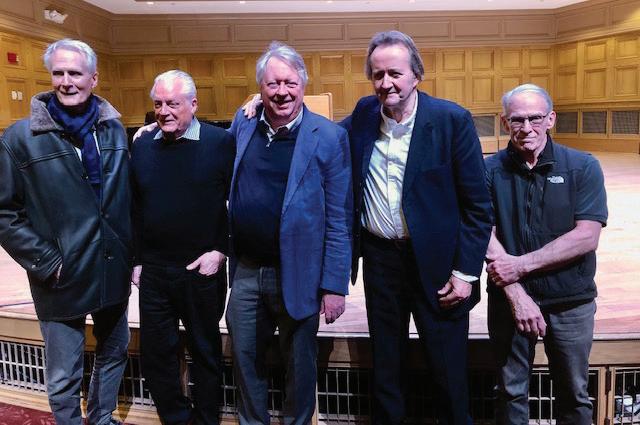
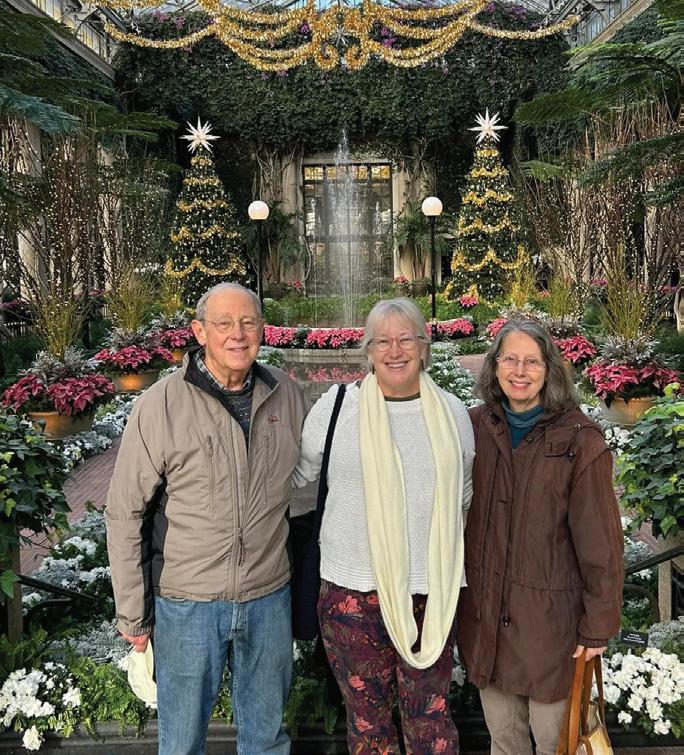
SPRING 2024 CAN’T HELP BUT CONNECT / 45
Gay and John Beverley ’60 with daughter, Alisa.
“King” Brian Fisher ’60
(l. to r.) Fran and John Schoonover ’63 and Dorothy Scarlett and Ernie Cruikshank ’62 at Lessons and Carols at St. Andrew’s in December.
(l. to r.) Ed Strong ’66, Larry Russell ’67, Jay Tolson ’67, Roy Foster ’67, and Fritz Hoffecker ’67
Bill Amos ’67, Alison (Amos) Muller ’78, and Josephine Eccel P’03,’10 at Longwood Gardens at Christmas.
1973
Everett McNair was on campus in November for Founders Day. As the 2023 Distinguished Alumnus, he gave the Founders Day Chapel talk, attended classes, went to wrestling practice, and spent time with faculty and students.


1979
Betsy (Beard) Stillings attended the Washington film premiere of Boys in the Boat and was also interviewed on the Seattle television show Evening Magazine about her own crew experience—and her Olympic gold medal, which was on display at a special exhibit about the University of Washington’s winning rowers.
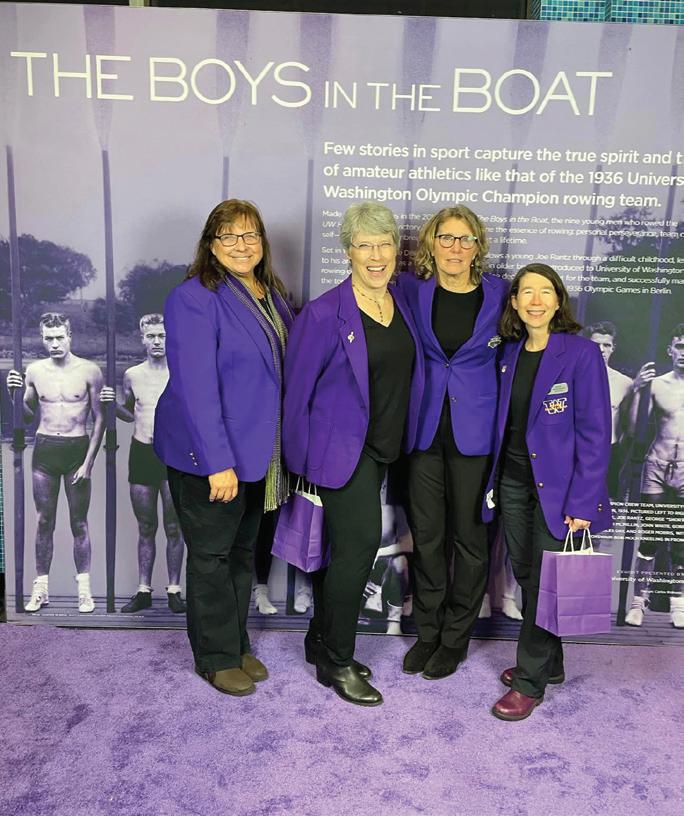
1980
Kate (Rentschler) Ausbrook and Judi (Skelton) Spann had a great but short visit when Kate and her husband, Keith, were in Jacksonville, Fla., where Judi and her husband, Bill, live. SAS friendships never die!
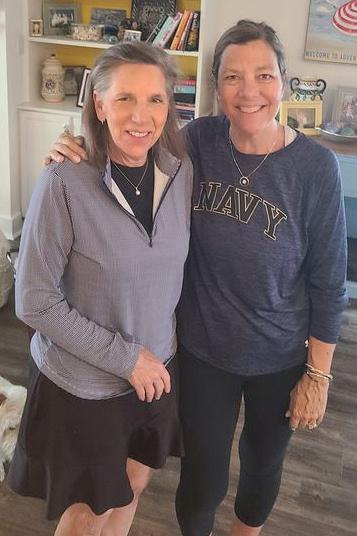
Kate and Judi.
1981
Congratulations to Katie (Kunz) Wilkinson, honored by Delaware Business Times as one of the “Most Impactful Leaders in the First State,” for her work
in banking. The list reflects “a who’s who of many of the state’s most important, and up-and-coming, leaders across a variety of industries, each chosen by DBT’s editorial staff over months of debate” and features those “who are creating jobs here, serving populations in need, or helping to shape the state’s public policy of the future.”

1982
“Travels included Palm Desert, Calif., Door County, Wis., SAS Reunion, Toronto, Minneapolis, and Tampa, and many people came to visit us, Kevin Grandfield writes. “We enjoyed walks at the Botanic Gardens, music concerts at Northwestern, and visits to the Art Institute. But in September, Mary had another oral cancer removed. Mary appears to have a condition known as field effect cancer, where new cancers keep appearing in her mouth. We have decided to end surgical treatments as they result in more suffering for Mary. She has begun palliative care for discomfort and is starting therapy to try to slow the cancer growth. More trips are planned for 2024!”
1983
Jill (Phillips) Rogers and Nancy Beth (Soles) Garrett visited Margy Horan Bond in her last months as chief of mission and consul general in Curaçao. “Margy was the most amazing host and tour guide,” Jill writes. “Curaçao was warm and delightful; our visit perfectly timed as the U.S. was blanketed in snow. Highlights included seeing an abundance of pink flamingos in their natural habitat, Porn Star martinis, great snorkeling, a colorful local art gallery, binging Netflix’s Escaping Twin Flames, along with lots of laughter and excellent meals!”
SAS / ST. ANDREW’S MAGAZINE 46 / CAN'T HELP BUT CONNECT
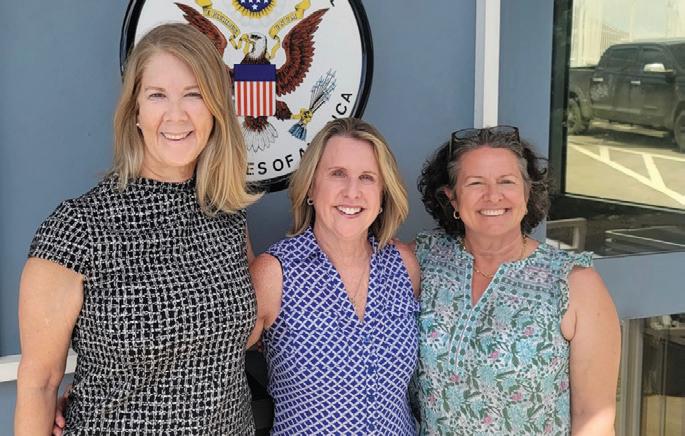
1987
Karen Pupke and Rupert Bell met up—way up, at Summit One Vanderbilt—to watch the Macy’s Day Parade in New York City this past Thanksgiving.
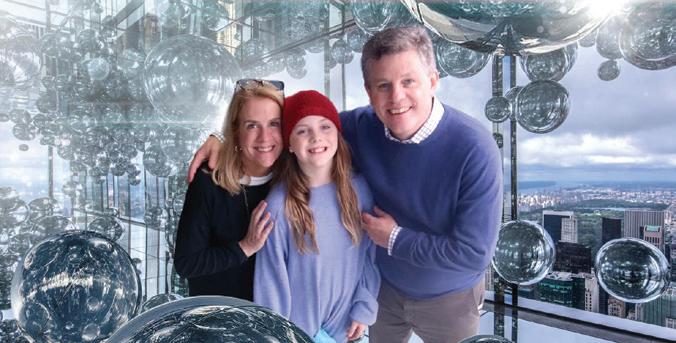
Karen Pupke, her goddaughter/Rupert’s daughter, Kika, and Rupert Bell
1988
In January, Jonathan Banks and his family attended the Australian Open. While there, they had lunch with Breffni Kehoe ’86, who lives in Mernda, Australia, and also met up with Kamillah Males ’90 for the women’s semifinal matches.
Julie (Herbert) Leopard and Brandon Mathews caught up in Philadelphia—Julie was in town from Atlanta, and Brandon from Switzerland!
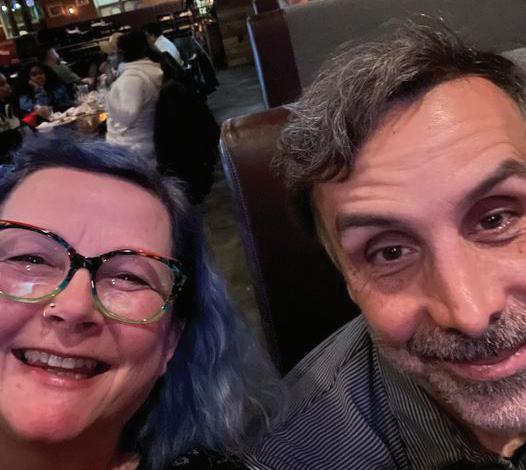
1989
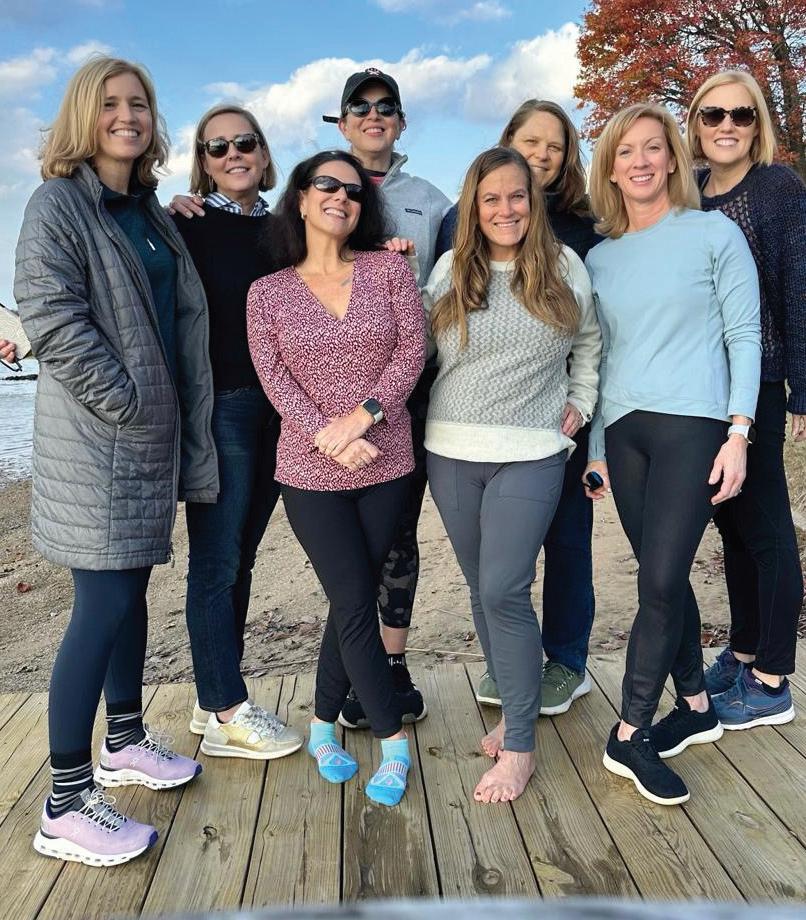
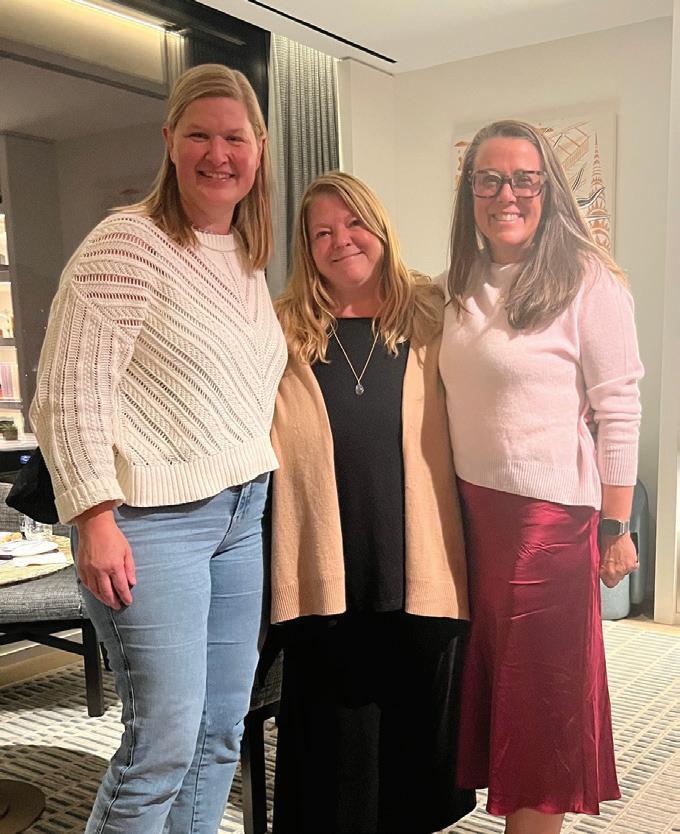
and it had been a handful of years since we’d seen each other.”
“Hard to believe it’ll be 26 years this spring,” Peter Hoopes writes. “My kids are doing well with one spring graduation from college. I continue to teach and coach at SAS, and will be producing several short films over the next year.”
Colin Murray is currently living in Chatham, N.J., working for an energy company that coincidentally has a refinery near Middletown on Route 13!

“Tom Puky and I rowed with some of the ‘Old Guard’ in the Head of the Schuylkill this fall,” Jim Bruin writes. “Good times.”
“All is well here: senior and sophomore in high school, at a start-up, married for 20-plus years, dog, etc.,” Kate Dickman writes. “Parents and family are healthy. Much to be thankful for! Busy but good years. I saw Toby [Whitmoyer], Em [Sinkler] and Marlies [Lissack] last month in New York City—two different nights, but a good SAS haul! My heart was totally full seeing those wonderful old pals and catching up. Felt like no time had passed,
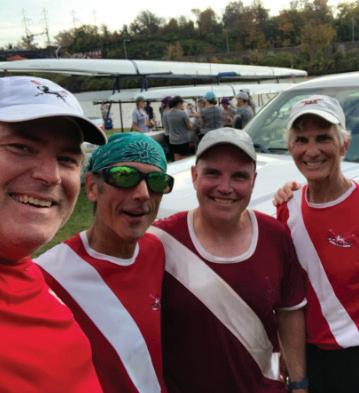
SPRING 2024 CAN’T HELP BUT CONNECT / 47
Margy Horan Bond ’83, Jill (Phillips) Rogers ’83, Nancy Beth (Soles) Garrett ’93 in Curaçao.
The annual 1989 Girls Weekend: (l. to r.) Zibby (Hammond) Pyle, Barrett (Simpson) Brewer, Catherine (Soles) Pomeroy, Allison Hamiton-Rohe, Melissa Mills McLoota, Susan Willock, Kristen (Zilling) Kreuzkamp, and Megin (Adams) Myers
Marlies (Patzman) Lissack ’89, Emilie Sinkler ’89, and Kate (Gamble) Dickman ’89 in New York City in October.
Colin Murray ’89 and his kids (both sophomores) at a hockey game during Family Weekend at Colorado College. Go Tigers!
Saints at the Head of the Schuylkill: Tom Puky ’89, Richard Cookerly ’78, Jim Bruin ’89, Steven Brownlee ’77
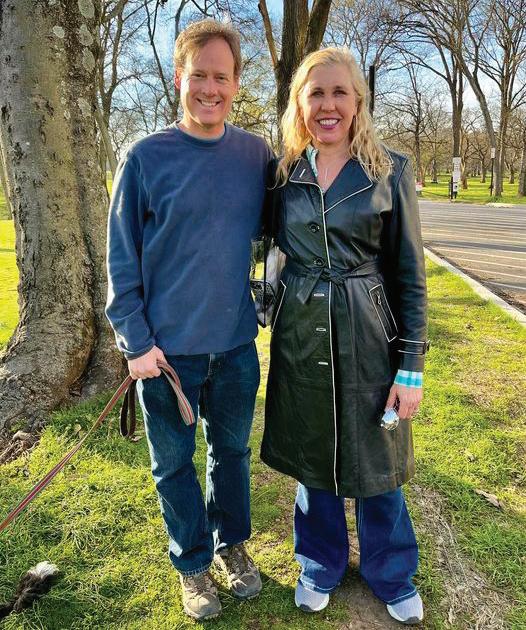
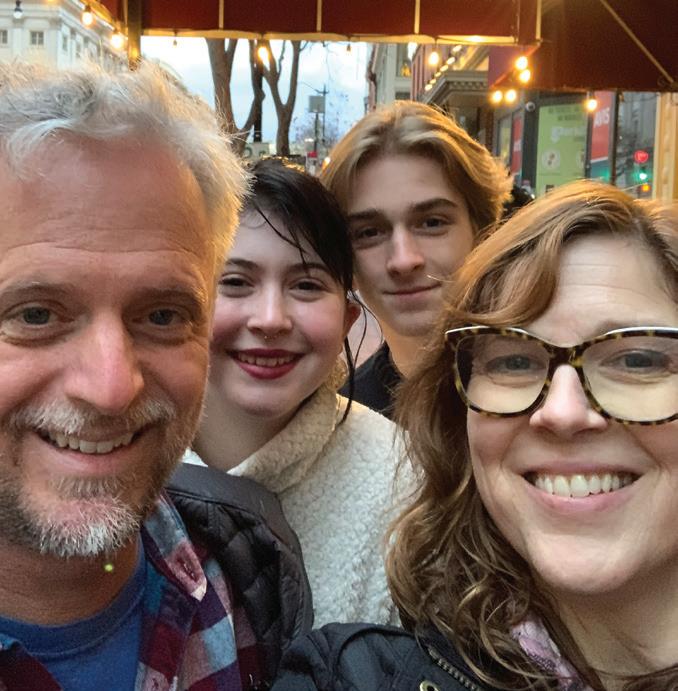
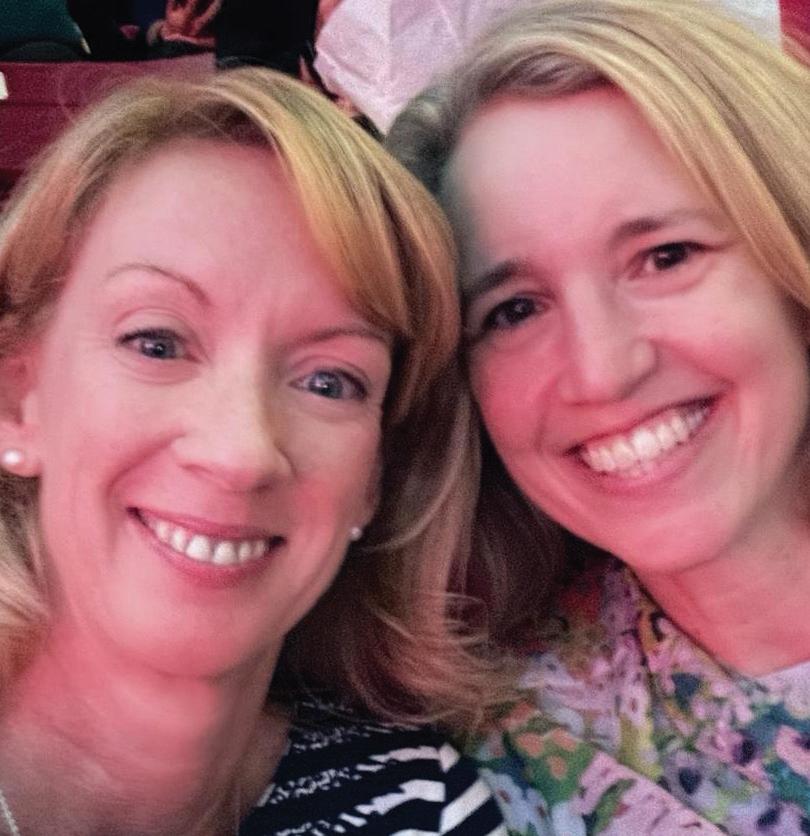
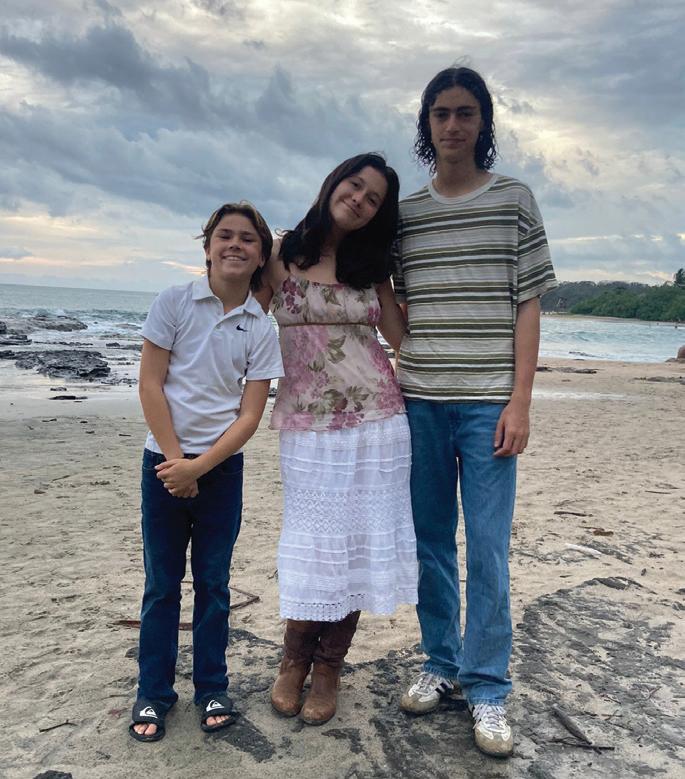
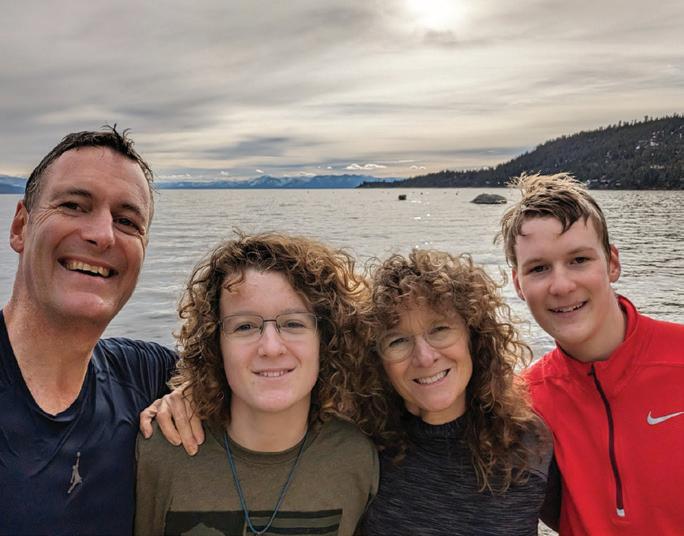



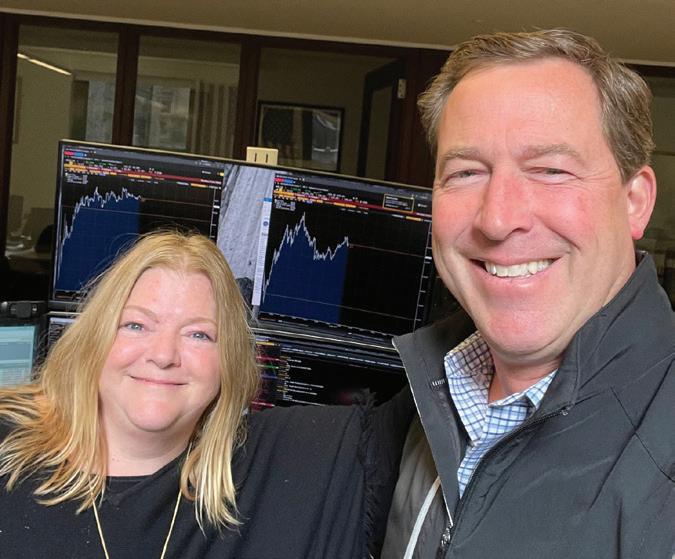

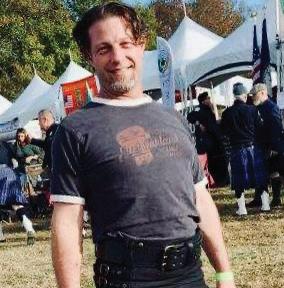
SAS / ST. ANDREW’S MAGAZINE 48 / CAN'T HELP BUT CONNECT
Victor van Buchem ’89 and Alex (Sargent) Capps ’85 walked around Centennial Park while Vic and family were visiting Nashville.
Allison Hamilton-Rohe ’89 and family at Carmine’s in New York City over Christmas.
Kristen (Zilling) Kreuzkamp ’89 and Zibby (Hammond) Pyle ’89 at Boston Pops Concert.
The children of Becky (Wendell) Watters ’89 caught some waves in Costa Rica.
Tore Olsen ’89 and family, who are sailing the South Seas.
Corinna Calhoun ’89 and family at Christmas.
Kristen (Zilling) Kreuzkamp ’89 and family visited her parents in South Carolina.
Megin (Adams) Myers ’89 and family having fun at the roller rink.
Em Sinkler ’89 and Bill Spire ’89
Greg King ’89 hosted a West Coast reunion with classmates Amy Wilson, Tom Pinckney, Tore Olsen and his wife, Becky (Wendell) Watters, Howard Moorin, and Andrew Hill
Keary Jenkins ’89 at the Highland Games.

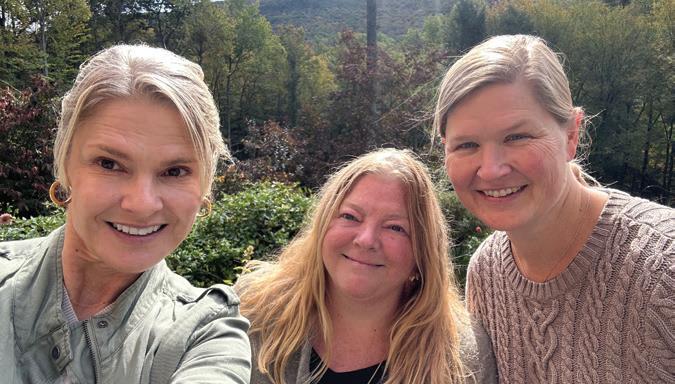
1995


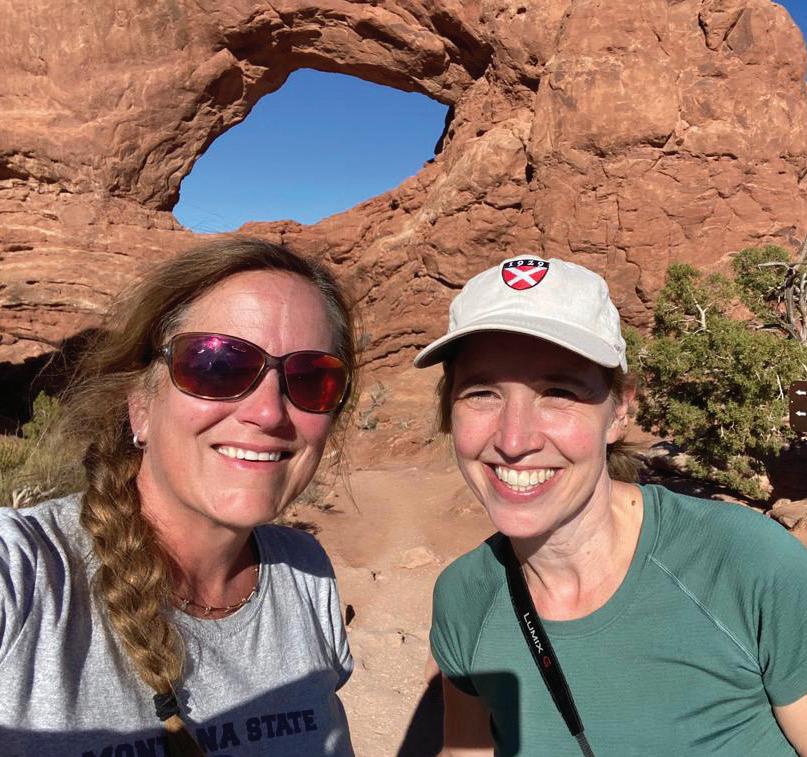
“I continue to do a lousy job of documenting family trips, but fortunately, other hands are usually on deck,” Chris writes. “[We went on a] too-brief, whirlwind visit to NYC in December. It was a treat to introduce our kids to a city dear to Elizabeth and me, and to catch up with family and a few friends (even if so many folks were missed). I didn’t manage to see any SASers while there. Charlie Gaeta and I almost connected ... but didn’t. I did see Edward Jones out on Long Island after leaving the city, however.”
2001
Richard Hutton is a Lieutenant Colonel in the US Army and is currently finishing his Ph.D. at the London School of Economics. “We’re finishing up a great three years in Britain this year and are off to Denver for my battalion command and our next adventure in June 2024,” Richard writes. “Katherine and I, as well as Kate (8), Powell (6), and William (4), are thriving, and we’ve been fortunate to get the kids to much of Europe during our time over here. Hoping that we can get to know any Saints around the Rockies in the next few years!”
2007
Members of the Class of 2007 gathered in New York City in December.
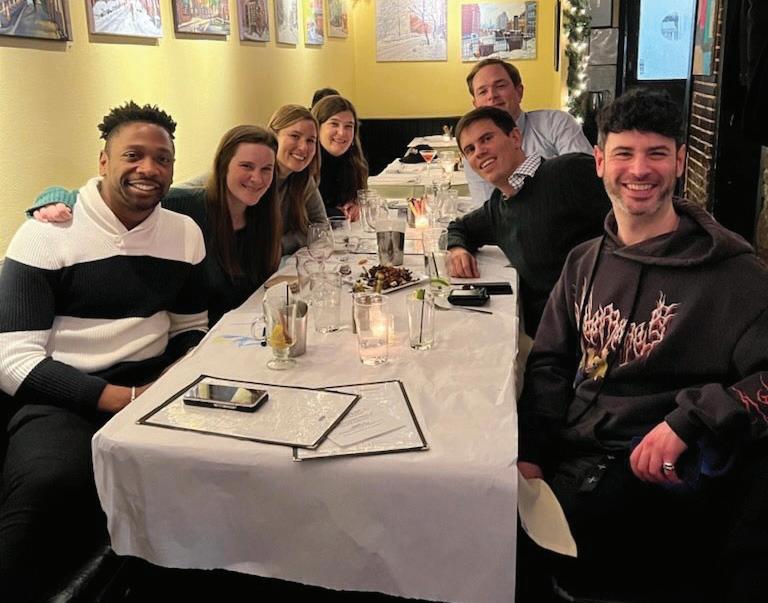
After recently moving to Miami, Kathryn (Orfuss) Perkins and husband, Ike, hosted a mini SAS reunion at their new home. The dinner coincided with a visit from a few out-of-towners, and Katie Stout and her family being in Miami for her Art Basel art show opening at Nina Johnson Gallery.

, Rosy Gonzalez Speers.
2018
Congratulations to Alex Horgan for finishing 49th at the Philadelphia Marathon with a time of 2:31:54, a blistering 5:48/mile pace.
SPRING 2024 CAN’T HELP BUT CONNECT / 49
Trevor Middleton ’89 and James Lai ’89 at a SAS fall reception.
Tom Pinckney ’89 and his son, Coates, caught up with Ashton Richards ’78 while visiting Branson School in California.
Melissa Mills McLoota ’89 and Zibby (Hammond) Pyle ’89 in Utah for the eclipse.
Lee (McGill) Jennings ’89, Em Sinkler ’89, and Marlies (Patzman) Lissack ’89 at Em’s house in Woodstock, N.Y.
Christopher Reiger ’95 and his family visited New York City in December.
(l. to r.) Nwakibe Kanu, Sutton (Brown) Al Qasimi, Rachel Hickman, Emily Bierwirth, Rob Bryan, Malcolm Forbes, Max Friedman.
(l. to r., front) Chris Speers ’07 with son Mateo, Jeff Kinkle with daughter Olympia (Katie Stout), Will Speers P’07,’09,’13 with grandson Lucas, Kathryn (Orfuss) Perkins with daughter Bunny. (l. to r., back) Katie Stout ’07, Ana Viruel, Ian James ’07, Eloise Repeczky ’07, Stephanie Chubb ’07, Chauncey Elsas ’07
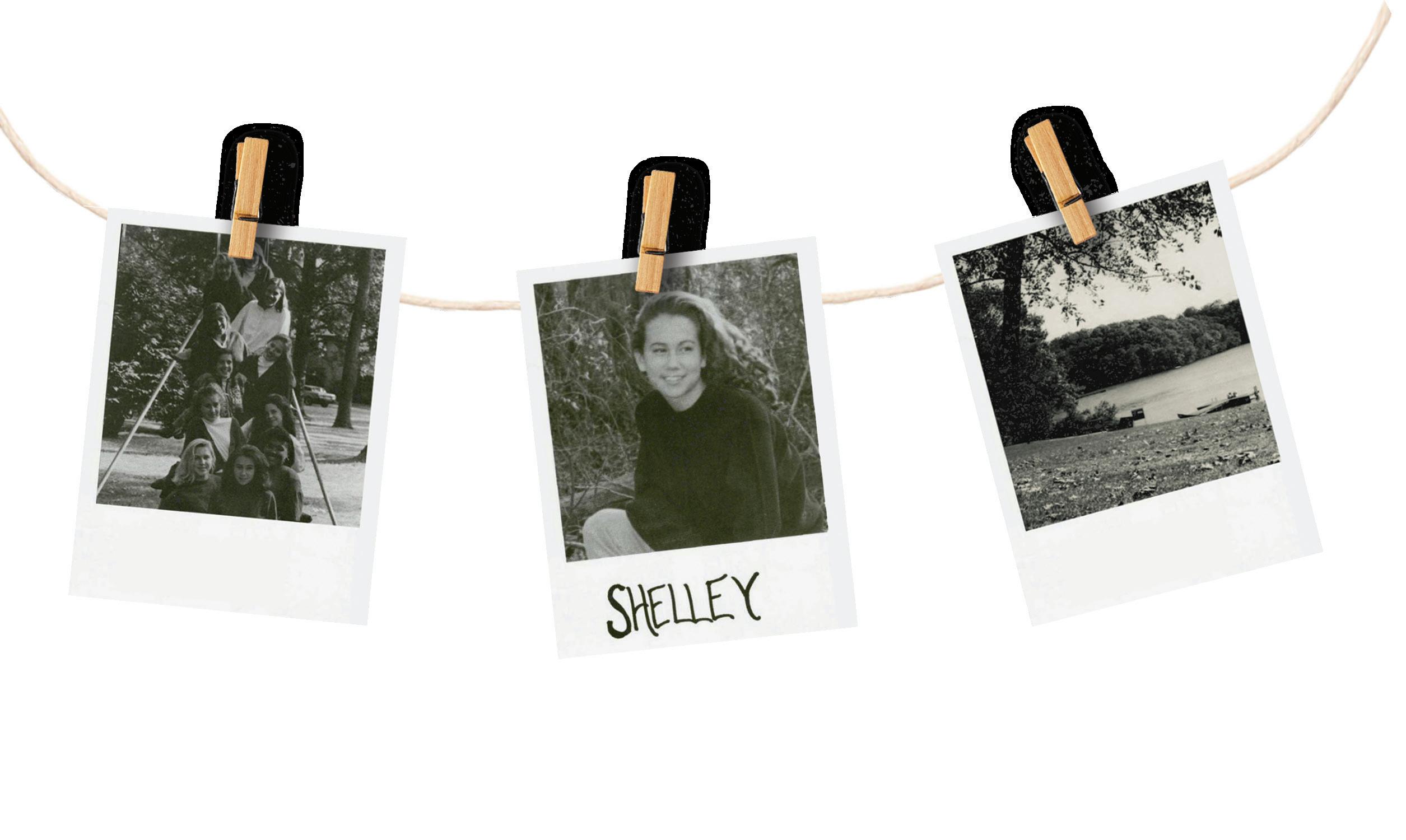
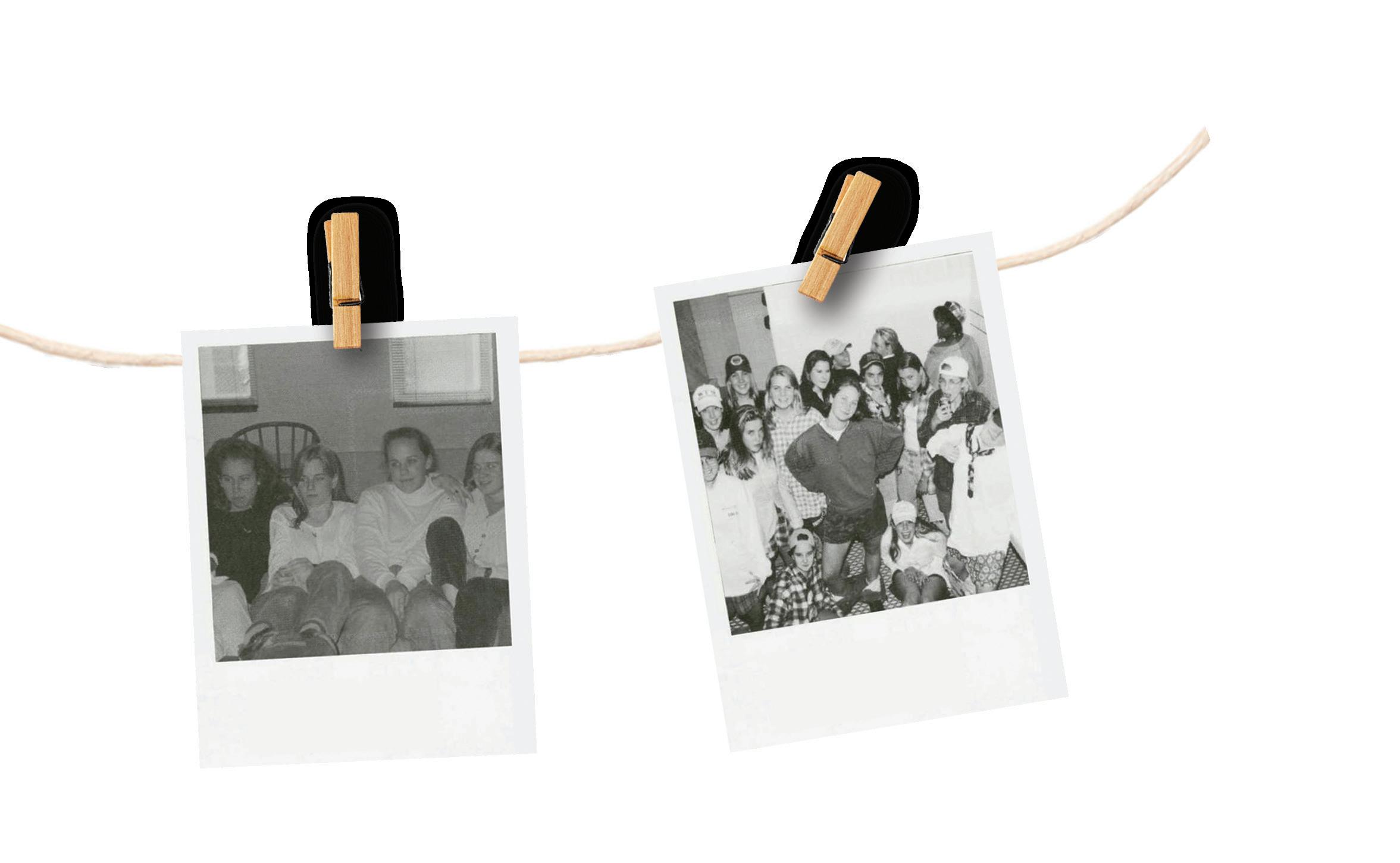
Shelley (Haley) Huntington delivered the following chapel talk at St. Catherine’s School in Richmond, Va., where she is MS/US Librarian, Faculty Advisory Council, and Head of Honor
50 / CAN'T HELP BUT CONNECT

When I was 14, the same age as many of you 8th graders, I packed up and went to a boarding school. It was about four hours from my house, in a state I had never visited. When I got in the car to leave that September early morning, the cold air stung a bit and I suddenly understood I wouldn’t be back home for a few months.
The school sat at the end of a long, long drive that snaked through pristine, grassy fields. Imagine solemn stone buildings, dramatic pitched slate roofs, shining leaded windows, a cloister garden, a vast dining hall with beams running the length of the ceiling and long wooden tables. Old murals, faded paintings of jacketed school boys, covered the walls, and they stared softly at you from across time. Leaving the dining hall, you descended down a staircase to reach a candlelit subterranean chapel that smelled like stones, mountain streams, and wax. The school overlooked a large pond where rowing teams cut through the water, their oars feathering in perfect precision. A forest full of unmarked trails cloaked the school.
How do you think I felt that first morning, entering this new space where I would live, sleep, and eat? What words come to mind?
My parents didn’t hear much from me those first months. Cell phones hadn’t been invented yet. There was no texting to touch base. Students checked their tiny metal mailbox daily during “break,” eager for letters from friends and family back home. Sometimes care packages came (boxes holding treats, cookies, a new stuffed animal, a special card) and you’d find a slip from the nice lady in the main office, Mrs. Simendinger, telling you to come to her desk to pick it up. My parents sent me a care package that first semester, and we talked on the pay phone at the end of the hall a couple times. They heard a lot more from the school’s Dean of Students, Mr. Speers.
(At this point, our theater teacher delivered a perfectly droll impersonation of Will Speers while reading my discipline letters (left out the smoking ones!), repeatedly looking over his glasses at me from the pulpit. The girls hooted and
“If you have a friend who’s making a lot of mistakes, if you have a sibling who keeps finding trouble, if you yourself keep messing up, in big ways or little, look deeper, think harder about the struggles that might coil and roil just beneath the surface.”
hollered! They loved picturing their Honor Head making so many mistakes as a kid.)
Oh geez. So many mistakes. What does this cluster of letters tell you about my first year at boarding school? Why do you think I made so many mistakes?
These mistakes don’t reflect a girl who wanted to be bad, who wanted to disappoint her teachers and frustrate her parents. These incidents, when put together, make a composite picture of a person struggling. Struggling on the field hockey field, holding a stick for the first time, when most of her classmates had played since before they turned 10. Struggling to wake up in the morning, when it was so hard to sleep in a strange bed a few feet from her roommate, a girl I just met from Buffalo, N.Y. Struggling to understand an entirely new New England culture, one with summer camps in Maine, and unfamiliar, clipped accents. Struggling to fit in in a place where a public-school background makes you different. I suddenly saw with glaring clarity that the ‘As’ I felt so proud of in middle school were actually worth very little. I struggled to keep up in the classroom and found myself behind in math, English, history, everything. All of these struggles twisted and turned and churned in my 14-year-old heart, stomach, and mind. They found their way out through these mistakes.
Kind teachers took time to talk with me, support me, get to know me, and help me. They didn’t view me as the sum of my mistakes; they didn’t write me off as a bad kid. Thanks to their grace, I found my way out of the maze. I righted myself. Every time I sing the closing lines of “Simple Gifts,” I think of the gift of my first year at boarding school: ‘by turning, turning, I came round right.’
If you have a friend who’s making a lot of mistakes, if you have a sibling who keeps finding trouble, if you yourself keep messing up, in big ways or little, look deeper, think harder about the struggles that might coil and roil just beneath the surface. Give that person (or yourself) extra kindness, extra love. They’re not bad; they might just need help to stop spinning and find where (and who) they want to be. Help from friends, from parents, from teachers, from the God (or Goddess) who holds your hand as you walk, sometimes stumbling, along the windy path mapped out for you by your own unique constellation, a special configuration of stars that charts your journey down here on earth. Look up; it’s there. •
SPRING 2024 CAN’T HELP BUT CONNECT / 51
Saints Get Married
Caitlin Forsthoefel ’10 wed Jose Laphitzondo in January in Miami, Fla.

(l. to r.) Chris Speers ’07, Garrett Hart ’10, Kaley (Hanrahan) Hart ’10, Benjamin Plumer ’10, Andrew Forsthoefel ’07, Jose, Caitlin ’10, Luke Forsthoefel ’16, Lizzie Rajasingh ’10, Catherine Geewax ’10, Tilden (Davis) Arnold ’10, Emily Calkins ’10, Ben McDonald ’10, and Grace Gahagan ’10.
Saints Babies
Michael Amos ’10 is a proud papa! Henry Taylor Amos made his appearance on January 8, 2024.
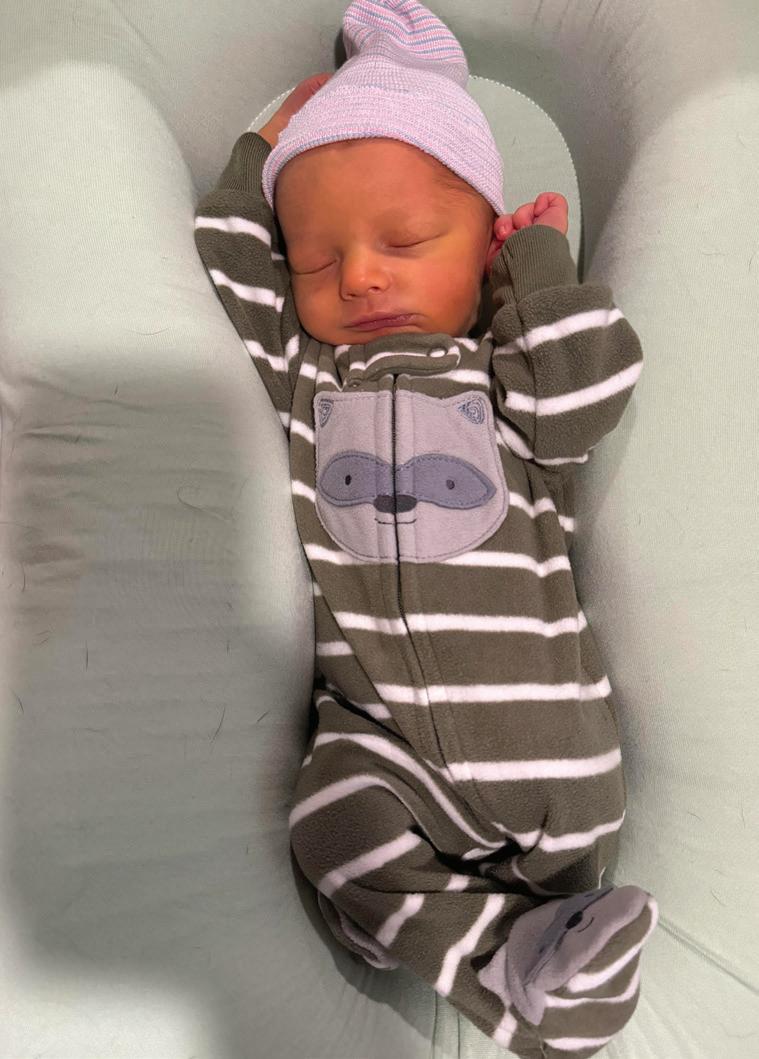
WE LOVE TO HEAR FROM YOU! We hope you’ll share any news from the small to the large— including news of your recent alumni meetups (including virtual gatherings!); job changes and professional achievements; recent travel; weddings and new additions to your family; acts of service, and anything else you want to let us know!
HOW TO SUBMIT NOTES ONLINE www.standrews-de.org/connect EMAIL
classnotes@standrews-de.org MAIL Class Notes c/o Magazine Editor St. Andrew’s School 350 Noxontown Road Middletown, DE 19709
SAS / ST. ANDREW’S MAGAZINE 52 / CAN'T HELP BUT CONNECT

CAN’T HELP BUT CONNECT / 53
In Memory
FORMER FACULTY/STAFF
The Christmas and New Year holidays were both wonderful and sad for St. Andrew’s School. We lost our former colleague, history teacher, and good friend, Nan Mein. Her clear voice and stern facial expressions were part of our lives, and always will be. Her daughter-in-law, Olivia, shared that Nan died peacefully in her favorite chair at Meadowcrest. Then, soon afterwards, our former colleague, classics teacher, and good friend, Evert van Buchem, too passed away quietly at home.
It is difficult to accept that both Nan and Evert died in the same two-week period. Their passing reminds us that life is fragile and that it is our sacred responsibility to make the most of every day because the here and now is all we really have.
Nan and Evert were realists. They faced life head on. They were not sentimental people. God knows their long lives included trials and hardships beyond what most of us have known. The best we can do is offer our thanks for their lives and labors, gifts they gave to our school every day because they loved teaching young people. May we live up to their high expectations and deep devotion to the honorable craft of teaching, advising, and sharing their lives with our community.
The right thing now is to hug your friends and classmates, your partner, your children. Tell them how much you love them. Tell them a story about these two remarkable teachers, and how much you respected them. Above all, pray a prayer of thanks that Nan and Evert fought the good fight and have now gone into their good night. A new dawn is breaking for each of them. This is our Christian hope. —DAVE DESALVO, ST. ANDREW’S INTERIM CHAPLAIN
I was saddened to learn about the loss of Nan Mein, Evert van Buchem, and Dianne Carter ’75 toward the end of 2023. These losses mark a profound passage for those of us in the Class of 1975 and surrounding classes.
Nan Mein was unquestionably the most important female presence at St. Andrew’s in the runup to coeducation. When she and Simon arrived in 1971, she quickly established herself as a formidable presence within the all-male community of St. Andrew’s. Her commitment to social justice, gender equity, and compassionate discipline led St. Andrew’s out of the “Welton Academy” model and toward the school we know today. Her steely yet mischievous eyes let us boys know that there was a new sheriff in town, one who understood that change would be gradual, but change was coming, and we better get on board.
Scooby van Buchem was an institution when I arrived in the fall of 1970. His playful demeanor and joyous approach to life helped make a small, terrified II Former feel a little less homesick. Much as we tried to get him distracted in class and start telling stories, he always saw through our ruse. “Golly man! Acta deos numquam mortalia fallunt!”
Dianne Carter was a pioneer, one of the original 26 [girls]. I can’t imagine what it must have been like for a Black girl from Massachusetts to come down to this small boarding school in Delaware as one of the first girls to attend. Dianne’s sassy humor, huge laugh, and adventurous spirit quickly won the hearts of her classmates. Life was not always kind to Dianne, and save for one concerted effort to get her back to one of our Reunions, most of us had lost contact. But her infectious personality resonates with the Class of 1975 today. Rest in peace, Dianne, and know that you were loved.
Scooby, Nan, and Dianne represented the past, present, and future of St. Andrew’s School in the 1970s. Those of us blessed to have lived, studied, laughed, and cried with them are all better human beings for their presence in our lives. And those who came after, up to and including today’s students, continue to reap the benefits of their timeless gifts. —GORDON BROWNLEE ’75
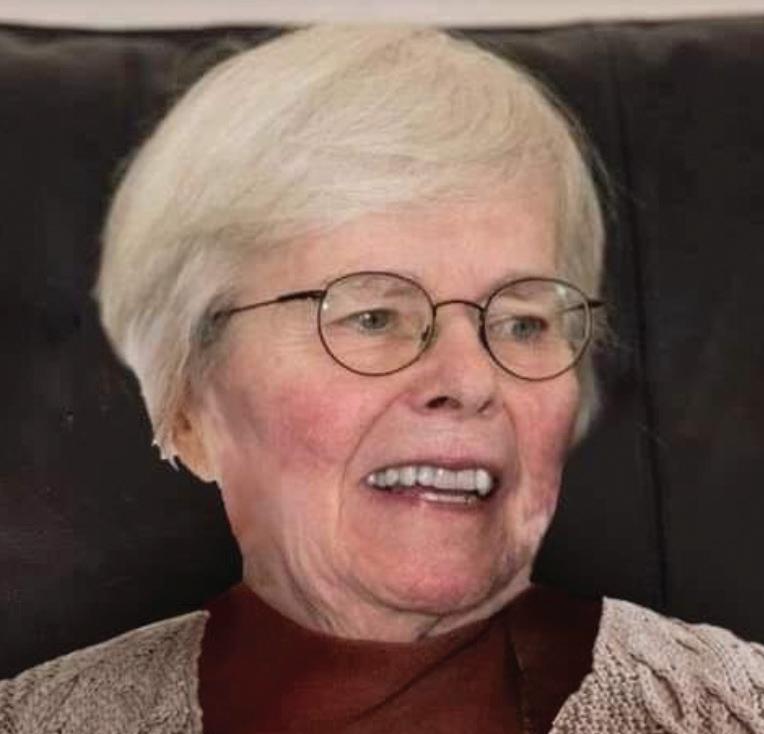
NANCY ANN McCLEERY MEIN
January 20, 1936 – December 21, 2023 Odessa, Delaware
Nan Mein, to me, embodied everything that made teaching and learning at St. Andrew’s so unique and inspirational. A brilliant historian, Nan stimulated young minds, mentored and encouraged teachers, and served as a model of what it meant to be a lifelong scholar as well as a person who prioritized humanity and connection both within and outside the classroom.
The secret to Nan’s enduring and astonishing impact is that the depth of her scholarship was always in conversation with what was relevant and accessible to teenagers across decades. As one former student of Nan’s so beautifully said, “Nan was an exacting, challenging, and inspirational presence in the classroom on a daily basis, but the longevity of her influence is what made her such a remarkable teacher. I thought about her course material and her feedback well into my studies in college and graduate school and beyond. It’s clear that she was a voracious reader and deep thinker: she crafted outstanding syllabi that managed to be current as well as stand the test of time. It’s amazing to think about her influence multiplied over so many generations.”
I will be forever grateful to Nan for her wisdom, her care, her wit, and her love of books. She taught me so much: how to teach, how to knit, how to cook, how to grieve, how to give grace, how
SAS / ST. ANDREW’S MAGAZINE 54 / CAN'T HELP BUT CONNECT
to inspire and care for teenagers, and how to endure.
We will all miss you, Nan, but your legacy resides in multitudes of hearts and minds.
—ELIZABETH ROACH
“I will be forever grateful to Nan for her wisdom, her care, her wit, and her love of books. She taught me so much: how to teach, how to knit, how to cook, how to grieve, how to give grace, how to inspire and care for teenagers, and how to endure.”
—Elizabeth Roach
I worked briefly, and joyfully, at St. Andrew’s in the fall of 2005, after graduating from college and before beginning my Army service. While working in the Admissions Office for the first half of the school year, I also assisted Nan, then semi-retired, in teaching her Western Civ class. What an experience! She invited me to do so, on a lark almost, at the start of the year, to raised eyebrows from Lindsay Brown and Louisa Zendt. But she was Nan, and she got what she wanted. I was green, full of so much energy that I practically bounced around the room, and almost completely lacking in teaching skills or life experience. She was, of course, the opposite: experienced, rooted in her chair, and full of more knowledge and personal history with the subject than anyone else at the school. We taught together, played off one another, and counter-balanced our respective skills and abilities.
After each class, with the kids gone, Nan would sit me down and teach me. Not about the subject, but about teaching, about leading kids, about guiding them, coaxing their best from them, and creating an environment in which learning can take place. When, owing to some medical issues she and Simon were going through at the time,
I had to solo-teach the course for six weeks, I was ready. Looking back on the experience nearly 20 years later, I am filled with gratitude—at her willingness to place such trust in me, her eagerness to share her lessons and experiences with one eager to learn, and her warmth and positivity in building up my confidence and showing me how much I could do and how far I could go. Teaching is, of course, an act of leadership, and, of whatever successes I’ve had in my professional career, be it in the classroom or the Army, I owe as much to her as I do to anyone. —RICH HUTTON ’01
I am so sorry to learn of Nan’s passing; she was a key person in my time at St. Andrew’s, the last four non-coed years. My class was the black sheep class of that Vietnam War era, questioning authority, dabbling in illegal substances, and refusing to maintain and promote the good ol’ boys attitudes that prevailed before we were seniors.
Nan and Simon brought humanity and family to what had been a seriously authoritarian campus, where sports ruled, bullying was ignored, and mistakes of judgment were met with summary expulsion.
They opened their home to students, served tea regularly, and made Easter a true celebration, with a full procession with trumpets and tall banners that we made during Lent.
We flew (and built) kites, learned cut-throat croquet, and learned that sherry was a daily ritual for them each afternoon at 5:30; the tower bells would ring, “Jesus calls us,” Nan (or Simon) would say, and the decanter and two glasses would be set out and used. By them, not students. Heavens.
Those of us lucky/wise enough to fall into their embrace, by either being advisees or just making the effort to connect, blossomed under the warmth of their care and concern. Nan was probably the first strong, outspoken woman most of us had ever met who did not necessarily toe the corporate line, who understood dissent, who knew that the way to break a corrupt system (discipline, for example) was to use it to the letter and thus overwhelm it. She was a rebel with a heart of gold,
having stood with Daniel Berrigan, the NYC anti-war activist Catholic priest, and having dropped her vows to marry Simon.
The pair were so funny, taking verbal jabs at each other and their occasional meeting of stereotypes, but their love of each other, of their god, and of the work that they did, which both just assumed included caring personally about their students, was unquestionable, unassailable. They were there for each other, and for us. I loved them both so much. They were the warm spot in an otherwise cold and unyielding, as yet unenlightened, hardnosed administration, and I know they kept a number of us feeling loved, so far away from our homes. Whether they knew it or not, and I suspect they did, they were breaking the cycle, and the school would never be the same again.
Nan had a huge heart, encyclopedic knowledge, a wicked sense of humor, a smile that could melt the polar icecap, and a laugh that could burn away the February Delaware cloud cover. And values that inspired a lifetime of tolerance and generosity in my own approach to life and, I hope, countless others. She and Simon trusted me to babysit their tiny Andrew (were they crazy?!), allowed me time in their apartment alone with my date for the spring dance (were they crazy?!), and treated me like a human being with value, and with needs. I honestly don’t know how I would have made it through those years, if not for their guidance, support, and open arms.
And now, with Scooby’s passing (Golly man!), the last of the SAS faculty who truly touched me has passed, and I don’t think I ever took the time to let them know how much they meant to this bullied, late-blooming, non-athletic 99th SAT percentile scholar in a world where jocks took the spotlight.
I urge any of you reading this, reach out to the guiding lights in your own life, and let them know their impact on your life and heart. There are few awards given to adults, and no salary can equal the knowledge that one has made a difference. Let them know. Today.
Nan, Simon, Scooby, I am forever grateful; your care, wit, brilliance,
SPRING 2024 CAN’T HELP BUT CONNECT / 55
verve, energy, and love kept me afloat, and allowed me to carry on through school and beyond, and become the person, father, colleague, and friend that I am today.
—GLENN HORTON ’73
I was very sad to hear of Nan Mein’s death. She left an indelible mark on everyone that she encountered and will certainly be missed by multiple generations of St. Andreans. When Simon and Nan arrived at St. Andrew’s in the fall of 1971, the school was a rather drab and stifling place. Of course, there were no girls. But perhaps more than that, it was an institution that still was operating under English boarding school rules amidst social revolution all around us. With Nan and Simon, we boys could witness firsthand a marriage of equal titans, unafraid of shaking up the status quo with their intellect, humor, and sheer force of personality. Instead of somber chapel services, we were suddenly making banners, discussing the need for women as priests, and flying kites on Easter Sunday. Nan was appalled that young men about to enter college had no clue how to cook, so she organized cooking clubs, and soon I was making raised donuts for treats, and joining classmates in figuring out how to prepare a full meal for ten people for ten dollars! Non-credit evening seminars soon followed, and a group of us gathered in the Mein apartment one evening a week to discuss readings centered on “Communes, Communities, and Utopias.” I never will forget what was then called “Father’s Weekend,” when my fairly provincial father visited the Meins’ apartment and discovered a book by Phillip and Daniel Berrigan, inscribed: “To Nan with Love, Phil and Dan”! My dad, conservative but always ready for a good debate, thoroughly enjoyed the ensuing discussion, and talked about it for years to come. We all were enchanted, and it was clear that St. Andrew’s was never going to be the same.
Through the years, Nan continued to impact how I viewed the world. She was the first thoroughly contemporary woman whom I encountered, and she continued to challenge my prejudices and areas of ignorance. She was
generous with herself in all ways, from sharing her experience of pregnancy and childbirth of her beloved Andrew, to her loving but forceful intellectual battles with Simon and everyone else, to her irrepressible hugs and cheers for jobs well done or well tried. She was fearless but kind; cerebral but practical; a force of nature who always made the time to help a fellow traveler.
Nan’s love made St. Andrew’s and the world a better place, which is all God could ever ask of any of us. We will miss her, but all of us who knew her will carry her presence forever. —MITCH
EDMONDSON ’73
Nan was a grand old soul with an abundant capacity for humor, a terrific teacher, and a good thinker. When I returned to the school one midsummer for a transcript, I saw Alice Ryan and Mary Dunn, both of whose sons were in my class, and Nan. Nan said she was teaching a woodworking class. “I wanted to show these kids that a middle-aged woman can do more with her hands than hold a cocktail.” Classic! I was not surprised when John McGiff told me a few years ago that Nan took him and his wife under her wing when they first got there. —PETER GEIER ’74
Very sorry to hear of the passing of this remarkable woman who was my Sacred Studies teacher in the 1971-72 school year if memory serves me. Her brilliant readings of the New Testament have never left me. It makes me stare with disbelief at those among us who would describe themselves as Christian, having met and enjoyed the company of the real thing. —ROGER GEIER ’75
Nan was my advisor and arranged a tour around England between my V and VI Form years long before parenting had been invented! She opened my eyes to so much. We memorized metaphysical poets and learned of her friendship with the Berrigan Brothers and her FBI file, and she said the f- word in class. We watched “Upstairs, Downstairs” and Princess Anne’s wedding in their flat–riveting for a budding Anglophile.Vivid memories! —TOM SAVAGE ’75
I was greatly saddened by the news of Nan Mein’s passing. She had a big impact on me at SAS in the early 1970s. I took two history classes from her and
“Nan had a huge heart, encyclopedic knowledge, a wicked sense of humor, a smile that could melt the polar icecap, and a laugh that could burn away the February Delaware cloud
cover.
And values that inspired a lifetime of tolerance and generosity in my own approach to life and, I hope, countless others.”
—Glenn Horton ’73
loved them both. She treated us like adults capable of serious discussion of weighty issues. It made the learning process feel important. I still remember a paper I wrote for her on the Kent State massacre. She was demanding and could be a little intimidating, but she was also open-minded and capable of real kindness. She was a strong person and held her own in a predominantly male faculty. I will never forget the warm breaking-of-the-bread services in her and her husband’s apartment. She was an inspiration to me when I later chose higher education as a career. I feel very lucky to have known her and been taught by her. —MIKE KUEHLWEIN ’76
Nan was a great role model for us “first girls.” She spoke her mind, and she was a great history teacher. [Former U.S. Sen.] Arlen Specter spoke at SAS in either my IV or V Form year. Nan clearly did not agree with him and peppered him with questions during his talk. It was the first time that I saw a female “challenge” a man regarding his views—and it certainly made an impression on me. —SUE MOON ’76
I was so sorry to hear the sad news about Nan. I came to St. Andrew’s in 1974 (the second year of coeducation). I struggled academically. I took a history course with Nan, and with her inspiration and confidence in me, I received my first A! I remember having great conversations with her about her life prior to St. Andrew’s. Nan
SAS / ST. ANDREW’S MAGAZINE 56 / CAN'T HELP BUT CONNECT
actually lent me some of her personal belongings so I could dress up as a nun for Halloween. Nan sparked a lifetime interest in history for me. I will always remember her kindness, sense of humor, and her inspiration to bring out the best in all of her students. I only wish I had told her how she so positively influenced me. I will remember her with great affection. —ALEXIS REED ’77
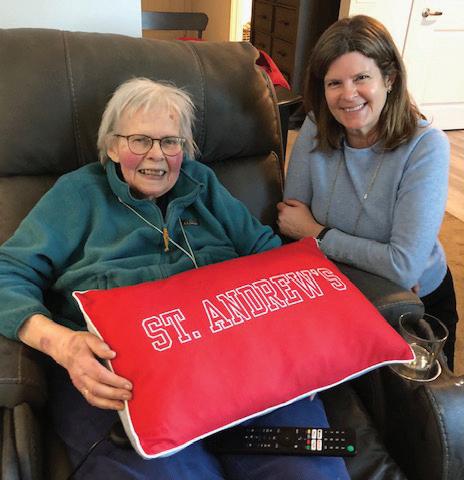
I met Nan before I ever attended SAS, when I went up with my parents on crew weekends to watch the races. Andrew was a newborn and I recall visiting her with my parents in their home. She was always so welcoming. When I did go to St. Andrew’s in 1975 for III Form, she was a natural choice to be my advisor and she patiently guided me through my years of teenage angst. She was more than just supportive though. Nan pushed me to do better and be better. She was a champion for all the girls as SAS figured out what to do with us all in the early years of coeducation. She was remarkable and I was fortunate to have her in my corner during such important, formative years.
—JANET BROWNLEE LUKE ’79
What a full life she had—and we were lucky to have her on campus in, arguably, her prime. I remember her as fiercely smart, a feminist without wearing it on her sleeve. —EDITH MACARTHUR ’82
Nan is an iconic SAS figure. She and Simon Mein were the faculty members living on E/F corridors when I was a freshman/sophomore. Mrs. Mein
was quite a tour de force. She had a small “store” in her home where if the school store was closed and you needed something like a bar of soap, she would sell one to you. I remember needing some dish soap or something, which she didn’t have at the time (and she gave me something else—I think it was laundry powder—but my memory may be filling in, anyway it was a substitute) and she said something so matter of fact and a little exasperated, as I must have had a dubious look on my face: “Soap is soap.” I remember it to this day when I often remind myself not to be so worried about everything. Her words became something larger for me, pronounced with so much conviction and practicality.
—ANITA PAMITUAN FUSCO ’86
What an honor to have known Nan Mein, as well as Simon and Andrew, a fellow 1990 classmate. Taking Nan’s History and Culture of East Asia class was one of the highlights of my time at St. Andrew’s. History was never a strong subject for me (sorry, Mr. Lyons—you tried valiantly with me!), but I used to genuinely look forward to Nan’s class every week. What an extraordinary teacher she was! She hosted countless classes at their home, complete with tea and biscuits. I remember one particular class field trip (where it was, specifically, I can’t remember—it was to see a friend of Nan’s). We were invited into our host’s stunning home that was filled with stunning East Asian art and relics. After listening to a talk, our host invited us to enjoy a homemade lunch. As we were merrily eating our bowls of rice that many of us had balanced on our knees since we were too many to sit around the dining table, Nan mentioned just how very old and precious the bowls we were eating from were. I just recall instantly being equal parts amazed and terrified: amazed to be eating out of a bowl that could ostensibly have been part of a major museum exhibit, and terrified that I’d be The One to drop my bowl in some freak chopstick-induced mishap (I’m happy to report that no bowls were harmed during the luncheon). The Meins also invited me out once to their home in Lewes one long weekend. My
parents lived in France at the time, so going home wasn’t an option. During that weekend, Nan made a French-style potato salad—with mustard vinaigrette and freshly-chopped chives—that has been my go-to recipe ever since. I think of her every time I make it. The Meins were also regularly in my thoughts during my time at the University of Kent in Canterbury (England). When they found out I’d be attending university there, they told me they had spent time living in a little apartment just inside the entryway to the cathedral grounds. I thought of them every time I walked past it. What a wonderful, lasting legacy Nan and the whole Mein family have left on St. Andrew’s. Those of us who are lucky enough to have been taught by—and known—the Meins are truly the richer for it.
—CHRISTINA CAIN ’90
I am so sad to learn of Nan’s passing. I was blessed to have taken her religion class in VI Form about utopian societies. I deeply enjoyed learning from Nan and to have been a recipient not only of her love for teaching, but also her profound love for her students. This love for her students is one of the enduring memories of St. Andrew’s that will forever stay with me. Thank you for loving us/me, Nan. —DIONNE THOMAS PULCINELLA ’94
I am so sad to learn of Nan Mein’s passing, though I am grateful to hear that it was peaceful. Nan Mein’s kind, steady presence was so important to me in my time at St. Andrew’s. From my III Form homesickness to my VI Form early admission acceptance into Williams College (and most importantly, helping me break it to my dad, Howard Snyder ’61, that I was not going to his alma mater Princeton), she supported me through the big and small moments that comprised my time at SAS. I am so grateful for her 30 years later. She has touched my life forever.
EMILY
(SNYDER) QUEENAN ’94
During my time at SAS (1991-95), Nan hosted a feminist group meeting for girls across SAS which was quite bold at the time, prompted in part by some challenging dynamics at 9:30-10 p.m., if I remember correctly. It was the first time we met as a group of all girls at St. Andrew’s and Nan created
SPRING 2024 CAN’T HELP BUT CONNECT / 57
the most welcoming, open, and trusting environment for us to share what was on our minds. The conversations were an awakening for many of us, and Nan was our fearless leader! —DESI BLISS ’95
Nan was an amazing woman, a force of nature. My condolences to her family and the broader SAS community who she impacted deeply. She will be incredibly missed by all who knew her.
—JAMES MAXFIELD ’98
“I remember her as fiercely smart, a feminist without wearing it on her sleeve.”
—Edith MacArthur ’82
Nan Mein’s teaching of Modern European History left a lasting impression on me—and not because I have particularly retained the details of the Industrial Revolution. I vividly recall her encouraging the young women in the class to find our voices, and to more forcefully participate in a discussion of history that could often be dominated by boys. She made it clear she valued our contributions, and that we had an obligation to speak up—in her classroom and beyond. I respected her immensely, not only as an intellect but also as a wife and mother. I remember to this day the tragedy of the loss of her son, and my awe for the incredible strength she modeled in a moment of unimaginable grief. She was a true inspiration to countless St. Andreans. —CAROLINE (SALAS) GAGE ’00
I am so saddened to hear about Nan’s departure from this world, but know that she is in peace with her beloved husband, Simon, and son, Andrew. Mrs. Mein was instrumental in my growth as a young woman, feminist, and amateur historian. While I attended St. Andrew’s in the late 1990s and SAS had been coed for decades, there was still an underlying (and at times, apparent) thread of misogyny that existed throughout the school traditions, classrooms, and life experiences. Frustrated by this, I was often disillusioned and frustrated as a student by these restrictions.
Enter Nan Mein and her European History class. Mrs. Mein not only validated the experiences that I was having in the present, but put them into historical context, and discussed cultural and societal shifts that occur over time. Each class with Mrs. Mein was engaging, enlightening, and memorable. She fostered my interest in history into a love and accepted me as a student unconditionally—my passion was a strength, my debates with other students and her were accepted, and my frustrations with societal expectations of women and other marginalized groups was a source of my own power that was meant to be channeled to make change. When discussing my college prospects and frustrations with the current educational systems, one question changed my life: “Why don’t you look into an all-women’s college?” I had never considered the option before Mrs. Mein and, with this recommendation, realized that this educational experience was exactly what I needed. My parents, particularly my mother, were hesitant to agree to allow me to apply to any of the Seven Sisters. It was a constant battle for several weeks, until parent-teacher conferences. My mother walked into her meeting with Mrs. Mein with one opinion of my collegiate prospects and within 20 minutes, walked out and stated, “Leslie, you can go to whatever school you want. Apply to those schools.” I was shocked. Later, I learned that Mrs. Mein told my mother that I could be the “next Margaret Thatcher if [my mother] does not stand in my way.” I applied to three of the Seven Sisters, attended Bryn Mawr College majoring in History (later transferring to Boston University, but that’s a story for another time), and ultimately obtained my master’s in social work. Looking back, while I did not grow up to become a politician (and have no such desire), Mrs. Mein’s influence in my development was instrumental. I can honestly say that I would not be who I am today if Mrs. Mein had not been in my life during those crucial years at St. Andrew’s. May she rest in peace and power. —LESLIE (HIRSH) ARCHER ’00
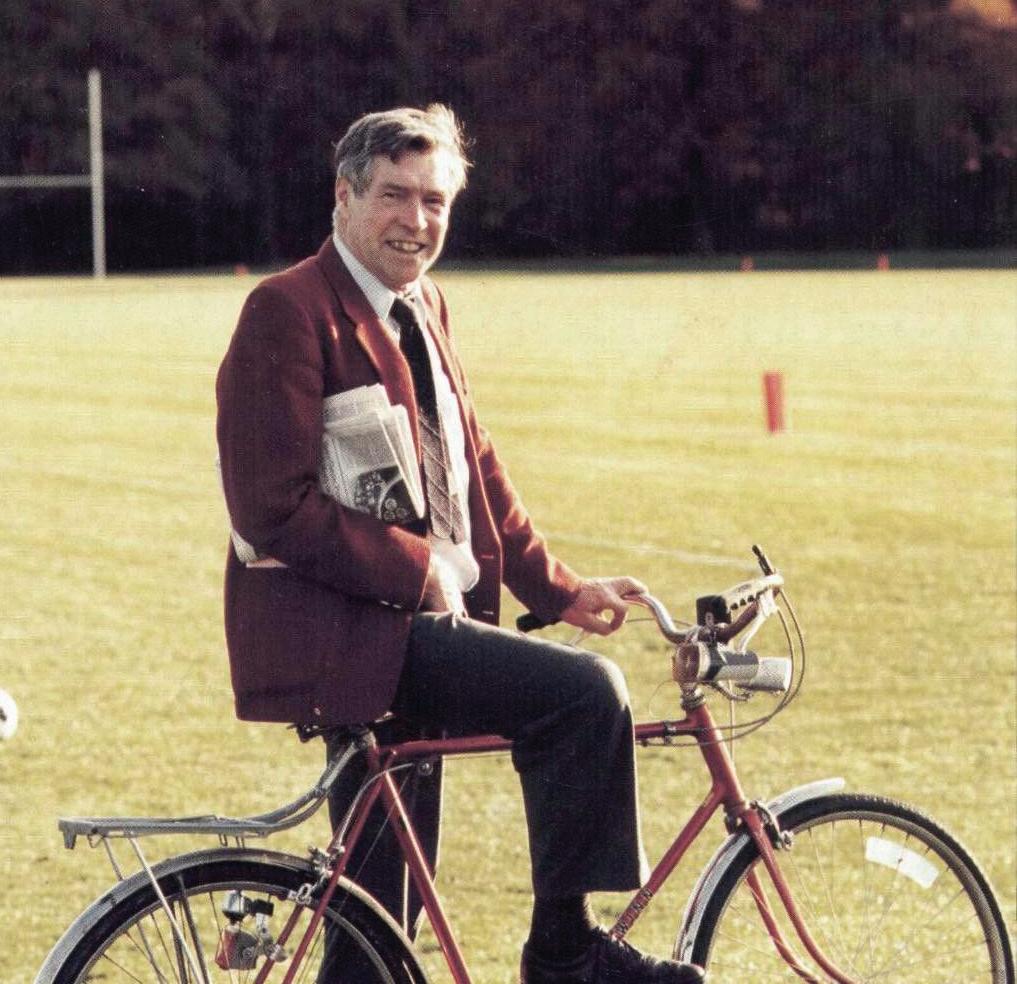
EVERT “SCOOBY” VAN BUCHEM
November 4, 1928 – December 31, 2023 Elkton, Maryland
Evert van Buchem was new to St. Andrew’s when most of our class of 1969 was also new. I was assigned to be one of his first crop of advisees. In what I have since discovered to be somewhat of a Dutch tradition, our first gathering featured white rolls with cheese or some other filling, soft drinks or juice, and perhaps a sort of dessert. When I later heard from Peter McGowin that he had enjoyed more-than-he-couldeat fried chicken and multiple fixings with other advisees at the Camerons, I quickly requested a transfer, which I hope Evert didn’t take as any sort of personal slight.
Though I was not enamored of Latin, and was quickly but gently corrected when I tried a sort of freestyle translation, Evert took a great personal interest in his students, and was happy to share a few words in Dutch with me when I asked. I suspect that his connection to Europe and his “exotic” past in Nijmegen first awakened some stirrings in me to experience some of the wider world. Little could I have imagined that after some years of peregrinations I would end up living only an hour south of the Netherlands. Evert was also my soccer coach and had a rather distinctive and efficient way of running—no flailing away with any unnecessary hand or arm movements. I’m not sure soccer was his forte, but he certainly knew more about the game than the rest of us.
SAS / ST. ANDREW’S MAGAZINE 58 / CAN'T HELP BUT CONNECT
Evert was een geweldige man. Moge hij in vrede rusten —PETER MAXSON ’69
What a wonderful man and inspired teacher. I recall, clear as day, his gentle chiding: “Gosh boy, the blunder!” Mr. Van Buchem taught me how to think, how to understand history and nature, and how important it is to grasp context and push the limits of what we know. Latin had no direct applicability to my onward life, but our interactions inside and outside the classroom (he was my advisor) taught me so much that has been fundamental to many aspects of my life. I was blessed to know him.
GREGORY SHAW ’70
I will miss seeing him at reunions. Although the conjugations have long since left me, I never forgot the advantage I had in later years from studying that language with Scooby at SAS. A kind and understanding man with a unique style which served to instruct the brainiacs at the same time as the morons, like me. God grant him peace and soothe the pain you feel at his passing. Gosh Boy! —CHUCK SHORLEY ’71
“My golly man!” Mr. Evert van Buchem was my all-time favorite teacher. He was also my advisor. I have so many fond memories of him and Marijke. How fortunate was my class to have a special dinner with Evert and Marijke at our 50th Reunion! (Special thanks to Alfons Gunnemann ’73 and his wife for arranging this.) —JERRY RUE ’73
I still remember my first encounter with Mr. van Buchem as a lowly II Former, required to take Latin. As he enthusiastically scribbled on the chalkboard and propelled himself across the room with one knee on his wheeled office chair, he declared in his unmistakable accent: “By gully, you are going to love Latin. It is full of the kind of stories all boys like: sex and violence!” And we did love it, more for his amusing interpretations than for any great fascination for Caesar’s Gallic wars or the words of Ovid and Cicero. He showed the same infectious energy and humor on the soccer field and in all of his student interactions. Evenings spent cooking and dining in
Marijke’s and Evert’s home are among my favorite memories at St. Andrew’s. It was such an honor and thrill for the Class of 1973 when Alfons Gunnemann was able to persuade the van Buchems to join us for our 50th Reunion dinner, truly bringing to mind some of the good times we shared at SAS. Thank you, Scooby, for your love and for your example of a life well lived! We will miss you. —MITCH EDMONDSON ’73
He was my advisor and had an enormous positive impact on my experience at St. Andrew’s and in shaping those formative years of my life. A magnificent man who leaves a great legacy from a life well-lived. We are all the better for having known him.
—GREGORY VAN DER VINK ’74
Absolutely one of the giants. He had a great early impact on my life! His legacy is the thousands of students who came into his orbit who he helped shape. I was lucky to have known him.
—BEDE RAMCHARAN ’76
I told my family that I was sure I would have loved to have taken Latin from Scooby in particular, with his multilingual knowledge, sense of humor, and that great smile of his. This led to amusement and questions about why he was nicknamed “Scooby”—which I honestly couldn’t say, although it always made perfect sense to me!
Of course, I did get to know him through JV soccer, since he was our coach. To add to that, he and my dad got to know each other, as Dad was a referee, and when the scheduled ref didn’t show up one time, Dad got his uniform out of his car and refereed our game. Not to mention that they both enjoyed each other’s sense of humor, and Dad looked forward to seeing him whenever he came to SAS, for Parents (Fathers?) Weekends, Arts Day, soccer games, and graduation! I’m not sure, but I think Dad even did work on the van Buchem’s house over the summer once, since, being a woodshop teacher at Gunning Bedford, my dad did side work every summer between school years. If Dad were still with us, he’d be sorry to hear of Evert’s passing ... so I prefer to believe they’re together again, catching up, and amusing each other
with humorous anecdotes! —SCOTT STANARD ’76
Scooby was the best teacher I ever had and the model of the fine education I got at St. Andrew’s.—ROBERT RAY ’78
He was an excellent teacher and a sweet guy. —ANDY MCDOWELL ’79
I never took a single class in Latin with Scooby, but still I was so frequently in “his classroom.” His infectious smile and enthusiasm and wit will remain a lasting memory for every St. Andrean who had the pleasure of knowing him. The visions of him riding his bicycle all over campus and his energetic flair on the soccer pitch are indelible memories. I loved seeing him return to St. Andrew’s in the years following his retirement. He will be missed! —SCOTT SIPPRELLE ’81
I have fond memories of learning and laughing in “Scoobymon”’s classroom as we discussed the lives of Caecilius and Quintas in Pompeii. He was a cool dude. —JILL CHASE ’82
A lovely, intelligent, and committed man. I am lucky that I was his student. We are all lucky that we got to have him around so long. —MICHAEL WHALEN ’84
Scooby was the best! —CHARLES SCHUMACHER ’84
He was an amazing man and my favorite teacher of all time. We can only hope to have as great a life as his.
PHILIP OECHSLE ’84
I took Latin for four years, not because I had any natural talent for it (I didn’t), but because I enjoyed my time with Mr. van Buchem. In fact, I would say I needed it. I took myself seriously (too seriously), and he added some much-needed lightness to my life. I remember watching out the window of our classroom as he arrived by bicycle, with books under his arm, clumsily trying to park his bike while waving at us. We laughed a lot in his class. I needed that. During a time in life when everyone felt a little awkward, Scooby made it OK to be weird.
I don’t remember much Latin, but I do remember how I felt in Latin class. Maya Angelou said, “People will forget what you said, people will forget what you did, but people will never forget how you made them feel.” Scooby made
SPRING 2024 CAN’T HELP BUT CONNECT / 59
me feel like I belonged. It is nowalmost 40 years since I left St. Andrew’s, and I am an educator myself. He will always be an inspiration to me, and I hope that I make my students feel like they belong. Thank you, Mr. van Buchem. You will be missed, and you will be remembered with love. —ERICA STETSON ’85
My beloved advisor and one of the most influential people in my life.
ANNE GAMMONS CROCCO ’85
I was so sorry to read the news of Mr. van Buchem’s passing. While I never took Latin during the years I was at SAS, I was a little jealous of those who did. Every time I looked into Scooby’s classroom, they were always laughing. Clearly Scooby made the study of Latin a fun event. Plus it was on the main floor so he had prime classroom space!
—ANITA PAMINTUAN FUSCO ’86
He was an amazing man and extremely tolerant of many a III Formers stumbling through first year Latin, myself included. His humor was magnificent and his caring nature came through in everything he did. —RANDY REYNOLDS ’86
Mr. van Buchem was the first person I met at St. Andrew’s, as my advisor and then Latin teacher for three years. He was so kind and jovial, always. I am now a teacher and channel his energy daily as I work to bring smiles, comfort, and welcoming to my students and advisees. Evert was a source of warmth and community at a time when I needed it. I will miss him very much and carry on his legacy for many years to come.
—HARDY GIESKE ’92
Mr. van Buchem was my advisor, and I am heartbroken that he just passed. He touched generations of St. Andreans with his wit and warmth. More than anything, he showed that caring is strength and inspired us to go into the world and do good. —TORE OLSEN ’89
I had the chance to spend a rainy afternoon with Evert and Marijke van Buchem at their home [in October 2019]—lovely folks. He told stories about his experiences at St. Andrew’s and elsewhere. He loved The Aeneid and The Odyssey, as well as Livy, Tacitus, and Plautus. I listened avidly to a great teacher. At the end of the afternoon, he gave me a few Latin books to return
“home.” They remain in my classroom. Ave atque vale, Evert. —PHIL WALSH, SAS CLASSICS TEACHER
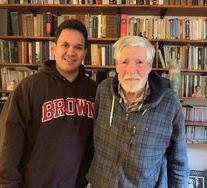
DIANNE CARTER ’75
April 25, 1956 – December 25, 2023 Pittsburgh, Pennsylvania
Dianne was one of the “First Girls,” moreover, she was the very first girl to receive a St. Andrew’s diploma, the first female to graduate from SAS. Back then, they handed out standard diplomas first, then cum laude, then magna, etc. All in alpha order. Dianne graduated with a standard diploma, and Carter was early in the alphabet, so she was the first. —LOUISE DEWAR ’75
The loss of Dianne leaves a hole in my heart. She was an amazing person who survived many challenges in her life and somehow overcame them with grace and her great sense of humor. —LISA GALLOWAY ’75

In Memory
2023
JAMES F. ADAMS ’48
Dunwoody, GA December 6, 2023
COL. HERBERT D. VOGEL, JR. ’48
Mechanicsville, VA August 9, 2023
CHARLES WILLIAM “CHARLIE BILL” KENNEY ’52
Sarasota, FL December 20, 2023
WILLIAM M. POPE, SR. ’61
New York, NY/Charlottesville, VA November 23, 2023
JAMES VOLLMER “SANDY” HAZLETT III ’70
Leesburg, FL December 15, 2023
MICHAELA CELESTE PENNY COLE ’76
San Antonio, TX December 31, 2023
In Memory as of December 31, 2023. Visit standrews-de.org/ inmemory to read full obituaries and leave remembrances for departed Saints.
If you would like to submit a remembrance of a deceased alumnus or former faculty member, you can do so via email to Chesa Profaci (cprofaci@standrews-de.org).
SAS / ST. ANDREW’S MAGAZINE 60 / CAN'T HELP BUT CONNECT
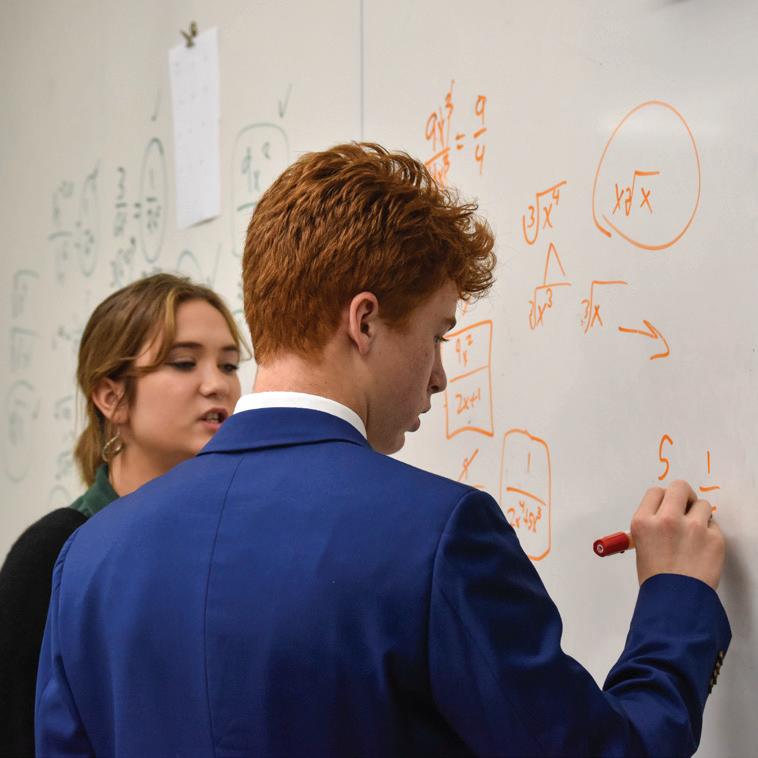
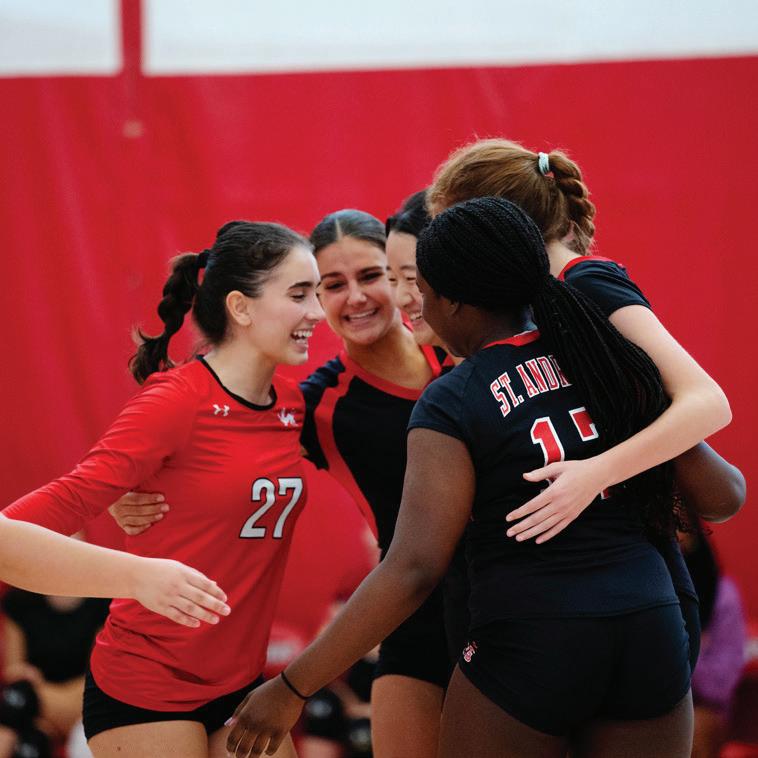
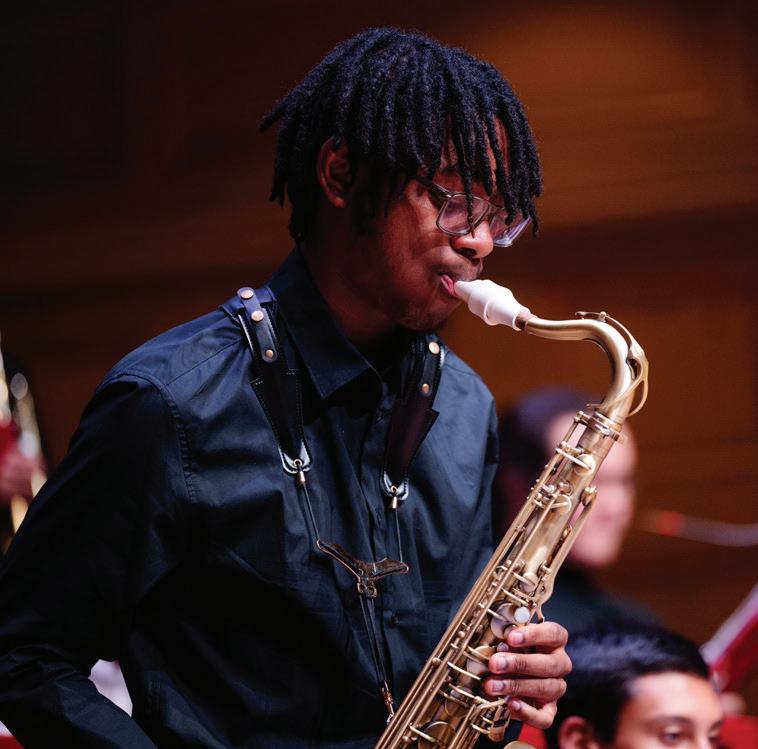
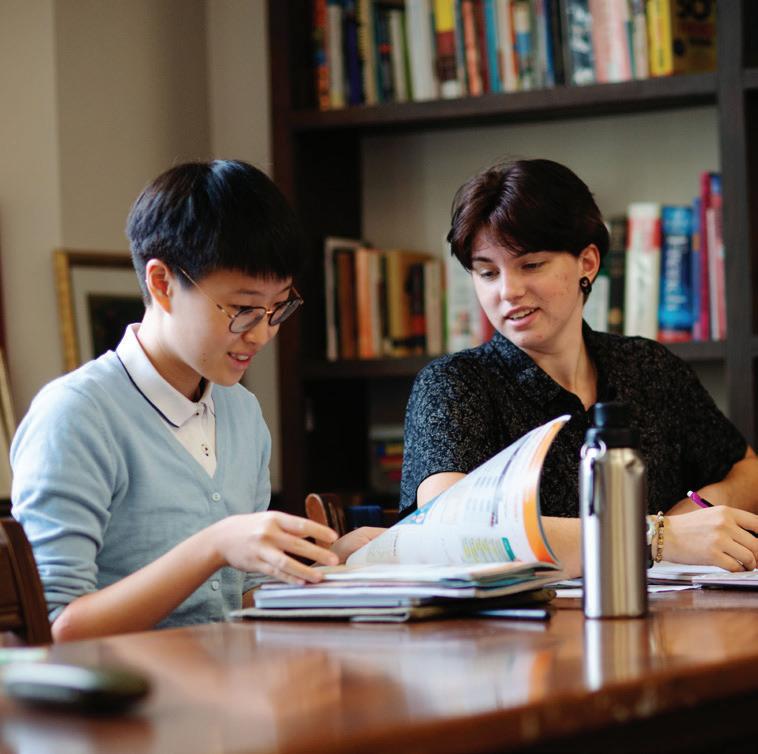
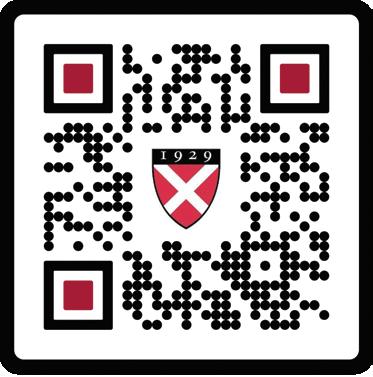
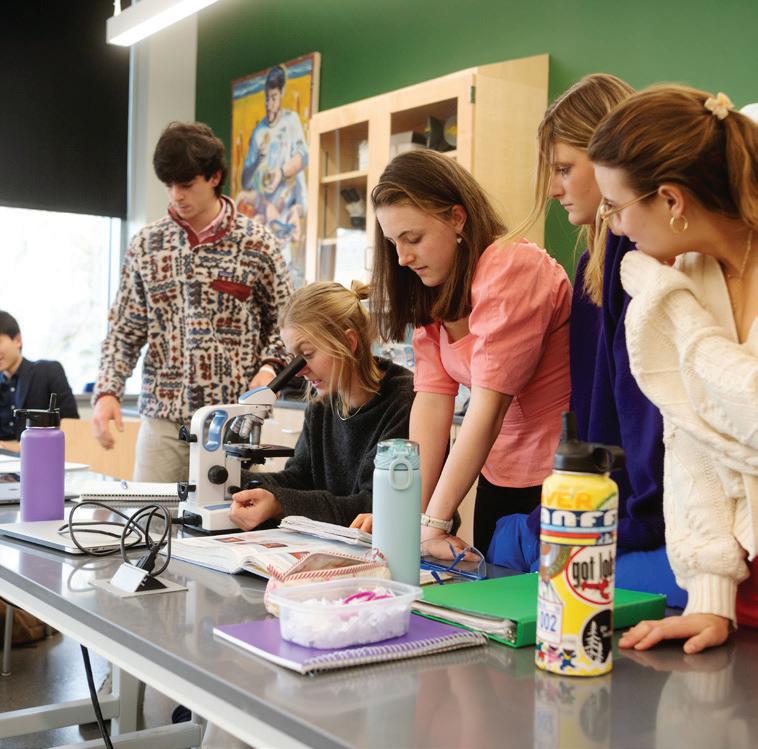
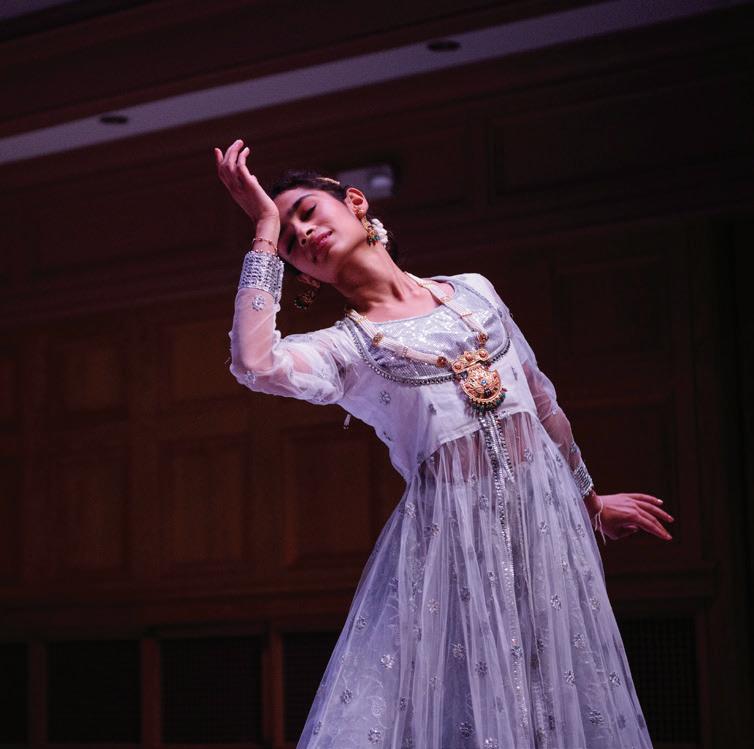
CAN’T HELP BUT CONNECT / 61 Whether you are one of the nearly 400 donors who have given to the Saints Fund for 25 or more years, or one of the five alums who have given for more than 50 years, or one of the nearly 250 first-time donors to the Saints Fund last year, your gift matters! VIA SMART PHONE ONLINE www.standrews-de.org/give VIA CHECK Not sure if you have given this year or want to discuss making a pledge, stock gift, or other way to give? Contact Laurie Kettle-Rivera, Director of the Saints Fund, at (302) 285-4274 or lkettlerivera@standrews-de.org. Please mail to: Advancement Office St. Andrew’s School 350 Noxontown Road Middletown, DE 19709 Gifts to the Saints Fund make a significant impact on the lives of current Saints, and help us plan for the Saints of tomorrow. We have a bold $3 million Saints Fund goal this year that is achievable only if our whole community comes together to do what Saints do: open doors, open hearts, and open minds. Please join us by making a gift today!
50 YEARS OF COEDUCATION AT ST. ANDREW’S

Our next issue of St. Andrew’s Magazine seeks to pick up where we left off in our conversation about coeducation. As we move into our second phase of celebrating the 50th anniversary of the first girls to attend St. Andrew’s, we could use your help. Do you know a Saint who was “first in her space,” either by shattering corporate ceilings, innovating in her field, rising through the ranks of a male-dominated space, smashing athletic records, or charting her own creative path? Perhaps that Saint is you! Please send your tips to magazine@standrews-de.org.
Our archival project remains open to collect all stories related to coeducation. If you’d like to share it, we’d love to hear it.
This is your story. Together, let’s make sure it gets told.
For more information on how you can join us in commemorating 50 years of coeducation, please visit:
STANDREWS-DE.ORG/COEDUCATION






































































































































